

CUJ, CTUIR Communications wins Indigenous Journalists Association awards
MISSION – The Confederated Umatilla Journal (CUJ) and Confederated Tribes of the Umatilla Indian Reservation’s (CTUIR) Communications Department combined to win five 2025 Indigenous Journalists Association (IJA) awards.
Announced on Thursday, June 12, the CUJ won third place for general excellence in the Professional Division II – Print/Online, while CUJ Reporter Chris Aadland took second place in the division’s best news story contest with his story about a derailed CTUIR solar energy development. The CUJ also won third place for best page layout in the Professional Division II – Print/Online.
“I’m incredibly proud of the CUJ and Communications team for their talent and commitment to telling important stories. This recognition is well-deserved,” Communications Director and CUJ Publisher Kaeleen McGuire said. “In an industry that continues to face tough challenges, the CUJ has remained committed to informing our community of issues vital to it, and I thank all those who had a hand in growing the publication and enhancing our storytelling abilities.”
For a photo of a spring Chinook smolt in someone’s hand that the CUJ published, Communications AV Support Specialist Lee Gavin won second place for best news photo in the Professional Division II – Print/Online. He also took second place in the division’s best multimedia category with a video story about the Pendleton Round-Up & Happy Canyon.
“Winning these awards really solidifies my passion for photography and videography,” Gavin said. “When I started here three years ago, I never would have thought my love to create would become a facet in my career and that would bring me to this point.”
But he wasn’t the only one in his family to win IJA hardware. His sister and fellow CTUIR member Jill-Marie Gavin, who is the public information specialist for the Columbia River Inter-Tribal Fish Commission, won four awards.
In the Professional Division I – Media, she won second place in the best
multimedia category. And in the Professional Division I – Print/Online, she won second and third places for best news story, as well as third place in the division for best feature photo.
With a record 871 entries, IJA will recognize the winners of its 250 awards during its 2025 Indigenous Media Conference Aug. 13-15 at the Isleta Resort and Casino in Albuquerque, New Mexico. The annual awards contest recognizes excellence in reporting by Indigenous and non-Indigenous journalists from across the globe.
The Confederated Tribes of the Umatilla Indian Reservation is comprised of the Cayuse, Walla Walla and Umatilla Tribes, and formed under the Treaty of 1855 at the Walla Walla Valley, 12 Stat. 945. In 1949, the Tribes adopted a constitutional form of government to protect, preserve and enhance the reserved treaty rights guaranteed under federal law..

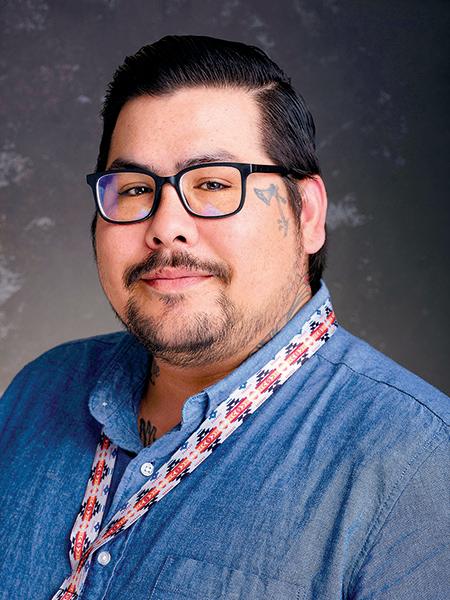
Yates named new CTUIR deputy executive director
MISSION – Confederated Tribes of the Umatilla Indian Reservation (CTUIR) officials have announced Chanda K. Aloysius Yates as a new deputy executive director to help manage the CTUIR’s governmental departments.
Yates, who holds a master’s degree in business administration, has more than 30 years of experience in health care management and consulting, specializing in Indian Health systems, tribal health organizations and village corporation governance.
“I am deeply honored to step into the role of deputy executive director for the Confederated Tribes of the Umatilla Indian Reservation,” she said. “In this capacity, I look forward to collaborating closely with the executive director, the Board of Trustees and the dedicated staff to strengthen our organizational framework, ensure efficient service delivery and continue advancing the long-term goals of the tribal government. I am committed to upholding the values and priorities of the CTUIR, working strategically to enhance our operations and making meaningful progress for our community and citizens.”
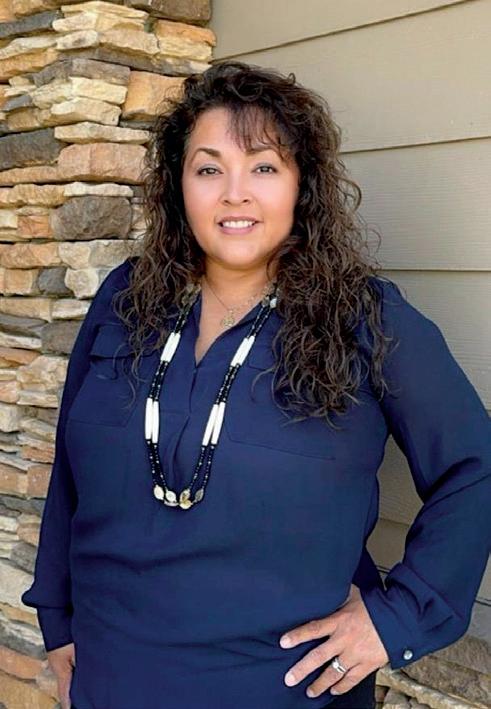
Previously, Yates served as a senior advisor at Kauffman and Associates where she contributed to health care research, planning and transformation initiatives. She also was health general manager at Klamath Tribal Health & Family Services where she successfully managed the operations of a $60 million dollar budget and 225-plus staff members. She also served as chief operations officer at OLE Health and vice president at Southcentral Foundation where she directed behavioral health integration and quality improvement efforts within Alaska’s Nuka System of
Care.
CTUIR Executive Director J.D. Tovey said he selected Yates as one of the tribe’s two deputy executive directors because of her commitment to strategic growth and sustainability.
“When considering Chanda’s work history, she has consistently demonstrated expertise in organizational leadership, business development and board governance across health care and business environments,” Tovey said. “She also has a proven track record of successfully managing multimillion-dollar budgets and leading large teams to drive operational excellence and organizational transformation. We are glad to be welcoming her to the CTUIR family.”
Yates, an enrolled member of Holy Cross Tribe in Alaska, replaces CTUIR Human Resources Director Kathryn Burke, who served part of 2024 and 2025 as deputy executive director before returning full time to Human Resources. The other executive deputy director position is being held in the interim by Finance Department Director Paul Rabb.

Chris Aadland
Chanda K. Aloysius Yates
Lee Gavin
The “Gatherers Project” book was featured on a float during the CTUIR Treaty Day celebration on June 13.
Bentz defends Republican tax and spending bill,
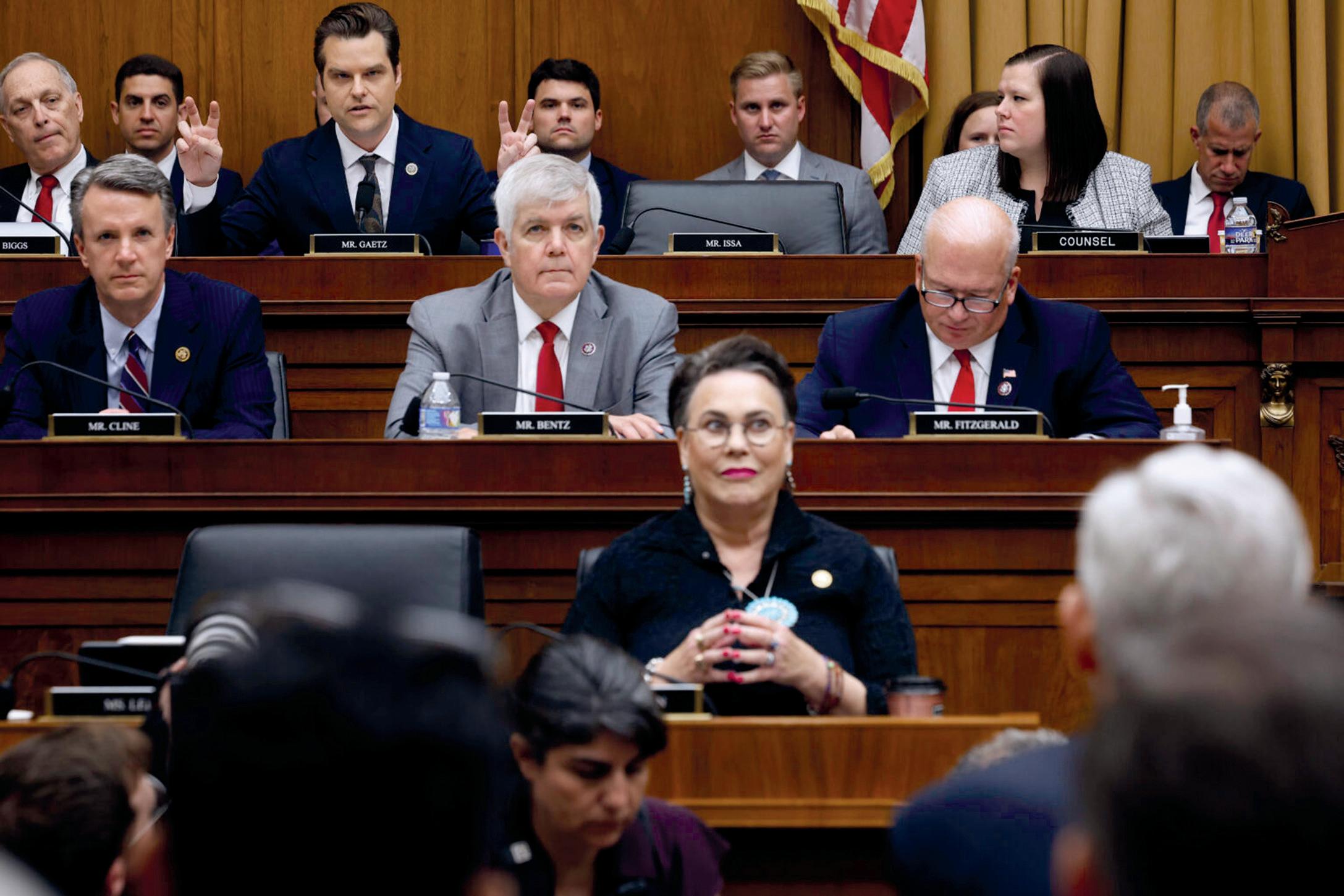
ALEX BAUMHARDT
Oregon Capital Chronicle
Oregon’s lone Republican Congressman, Cliff Bentz, represents more than 705,000 Oregonians — about
16% of the state’s population — who will feel disproportionately the cuts in the Republican tax and spending bill currently being considered by the U.S. Senate and that passed the U.S. House
in May.
Bentz’s 2nd Congressional District spans two-thirds of the state east of the Willamette Valley and is home to mostly rural communities with higher
average rates of poverty, food insecurity, unemployment and Medicaid enrollment than the rest of the state and nation. The bill, which Bentz voted for, would cut spending on Medicaid and on the Supplemental Nutrition Assistance Program, or SNAP, funding meant to ensure low-income Americans have food.
In a 45-minute phone interview with the Capital Chronicle last Friday, Bentz defended the Republican tax and spending bill, adding that middle and low-income families, small businesses and the timber industry would be particularly pleased.
“I’ll just say that there’s a lot of really, really, really good things in this bill that I think people are going to be very, very happy for,” he said, pointing to the bill’s lowering or ending taxes on certain wages, such as overtime and tips, and costs, such as car loans.
He dismissed questions about the possible impacts Medicaid cuts could have on rural medical clinics that cannot turn patients away regardless of insurance, saying “If I may, this is supposed to be an interview, not an interrogation or an argument.”
Instead, Bentz said, the bill reflects fiscal responsibility.
“The most important thing that I was focused on is our economy, and making sure that we don’t damage the


Oregon Rep. Cliff Bentz, center, voted for a proposal to cut Medicaid funding. The state’s lone Republican congressman said the tax bill he and House Republicans put forward will make people “very happy.” CHIP SOMODEVILLA/GETTY IMAGES
economy, while at the same time trying to reduce the deficit,” he said.
In fact, according to analysis from the nonpartisan Congressional Budget Office, the bill if implemented would add trillions to the national deficit and the national debt. That growing debt would be driven not just by spending but by extending the 2017 Tax Cuts and Jobs Act passed during President Donald Trump’s first term that brought the federal corporate income tax rate and income tax rates on the wealthiest Americans to historic lows. A year after the act passed — for the first time in history — America’s billionaires paid a lower effective tax rate than the bottom half of American households, according to analysis by economists at the University of California at Berkeley.
Bentz said without extending the 2017 tax cuts, the average American family would see their income taxes rise by about $1,700 and up to 7 million jobs could be lost. Those figures come from the Council of Economic Advisers, a three-member, president-appointed agency within the Executive Branch that recommends economic policies.
The Capital Chronicle received nearly three dozen questions for Bentz submitted by readers. The bulk of those questions, and the interview, covered provisions of the bill that would impact access to health insurance under Medicaid, cuts to federal jobs and clean energy tax credits, tax cuts for the wealthy and the power President Donald Trump has over the Republican Party.
An annotated and full transcript of the interview can be read here.
Medicaid
To reduce federal spending, Republicans have focused on adding new work and citizenship requirements to Medicaid eligibility that could result in about 7.6 million people losing coverage over the next decade, or a bit less than 10% of everyone in the country who relies on Medicaid, according to the Congressional Budget Office. It would result in $76 billion to $88 billion a year not being spent on the program, according to Bentz’s analysis of Congressional Budget Office data.
The group of 7.6 million includes immigrants at risk of deportations and people who might be receiving Medicaid despite higher than reported income. But the bulk of the 7.6 million — more than 60% — are what Bentz calls the “able-bodied adults choosing not to work.” Analysis of 2024 U.S. Census Bureau surveys finds they are mostly in school, are parents, caretakers or disabled Americans.
Bentz, who serves on the House Energy and Commerce Committee responsible for the Medicaid cuts proposed in the bill, said that he consulted closely with former Democratic Oregon Gov. John Kitzhaber, a doctor, for weeks on the bill, and called him “a genius” in a recent interview on Oregon Public Broadcasting.
But Kitzhaber told the Capital Chronicle that there was “nothing morally defensible in the bill” following a May 22 virtual town hall Bentz hosted the day the Republican tax and spending bill passed the House.
“We advised him on how the program works, and I warned him over and over again that the impact of this was not going to be good, especially for people in his part of the state,” Kitzhaber said.
About one in three Oregonians relies on Medicaid for their health insurance. But in the 20 counties in Bentz’s district, the numbers are even higher. In Malheur, Klamath and Josephine counties, more than 40% of residents rely on Medicaid, according to the Oregon Health Authority. In Jefferson County, where Bentz is from, half of all residents are covered by Medicaid.
Bentz said he couldn’t work all of Kitzhaber’s recommendations into the bill, including his warnings that it would be overburdensome to rural clinics to take health insurance away from people who will seek medical care they cannot pay for, anyway. Bentz said he understands why Kitzhaber would bemoan it: “Well, he’s a doctor.”
“He is going to be on the side of the patient at all times,” Bentz said. “Anything that does not provide coverage for everybody, he’s going to be concerned about it.”
Money matters
Bentz says he’s been worried about the U.S. budget deficit, or the gap between how much revenue the federal government brings in against how much it spends, since before joining Congress in 2021. Bentz has been quoted in the past saying he won’t vote for a bill that raises the deficit.
The Republican tax bill would raise the national deficit by $3.6 trillion over the next decade and would add $2.4 trillion of debt to the nation’s $35 trillion debt, according to analysis by the Congressional Budget Office. It would also raise the debt ceiling — a legal limit to the amount of money the federal government can borrow — by $4 trillion. Asked why Bentz voted for it given his past statements, he said he had to.
“The fact of the matter is, we have to raise the debt ceiling to avoid defaulting on debt incurred way before I got here, and we are not going to default,” he said.
Indeed, during Trump’s first term from January 2017 to December 2020, the growth in the U.S.’s annual deficit was the third-largest increase, relative to the size of the economy, of any U.S. presidential administration, according to reporting by ProPublica and The Washington Post. Even before the COVID pandemic hit in late 2019, Trump was on track to add close to $10 trillion to the nation’s debt by 2025 — $3 trillion more than his predecessor, former President Barack Obama.
Climate and energy
The version of the Republican tax bill that Bentz voted for before it got to the Senate included a provision that would have transferred and privatized 500,000 acres of public land in Nevada and Utah. Republican U.S. Rep. Ryan Zinke, of Montana’s 1st Congressional District, ended up getting the provision killed following pressure from hunting and fishing groups in his state.
Bentz said he does not support selling off public land to the private sector, but that he does support trading it for the right purposes. He said most
of the 500,000 acres slated for transfer in the bill were going to be made in a trade, not a handover. He said he was surprised Zinke caved and that he believes some of the “movie stars and whatnot who have moved up there,” to Montana, played a role in getting Zinke to axe the transfer.
“There are really good reasons many times in the West, where there are literally tens and hundreds of millions of acres of public land, to transfer a small portion of it so that we can actually grow and perhaps address, oh I don’t know, housing issues? Since everybody knows that we are desperately short of housing,” he said. “Why in the world would we try to preserve land for hunting when people are living under a tree someplace?”
Reporting in the Oregonian found Bentz’s district has about $10 billion in committed investment in solar, wind and energy projects spurred by tax incentives and investments in the 2022 Inflation Reduction Act. Among them is Sunstone Solar, which would be Oregon’s largest approved solar and storage project on 10,000 acres of farmland in Morrow County. Many of the projects committed so far are incomplete or haven’t broken ground. Bentz, who did not vote for the bill in 2022, said he was not worried about losing those projects, and that he thought the clean energy tax credits were bad policy.
“These incentives are all tax-driven incentives, which allow folks to avoid paying taxes in return for investing in a certain type of activity in this case,” he said.
Trump’s power over Republicans Bentz, a career lawyer before becoming a politician, said he is not concerned about Trump or his advisers’ defiance and disinterest in judicial review. He said Trump’s continued appeals to higher and higher courts when he loses in lawsuits brought against him and his policies are his legal right, and if he “bumps into a judge that he doesn’t appreciate the opinion of, he has every opportunity and right to appeal it.”
Bentz said he believes Trump is simply using the full scope of the legal system to his advantage, and that he would not support Trump defying the Supreme Court.
“I would not support anyone ignoring the Supreme Court. That’s not how our system works,” Bentz said.
As for whether Republicans will fall into line on all of Trump’s orders, Bentz said it’s not because of pressure, but because they agree with what the president stands for.
He said having power in the majority is a new experience for him after 12 years in the Oregon Legislature, led by Democrats.
“I was never one day in the majority, not even one day. And as a result, when I got here and found that I had all Republican control across the scope of the three branches of government, it’s been a huge and welcome change,” he said.
ABOUT THE CUJ
The Confederated Umatilla Journal (CUJ) was created in 1975 as the official publication of the Confederated Tribes of the Umatilla Indian Reservation (CTUIR), which includes the Cayuse, Umatilla and Walla Walla people. The CUJ is produced monthly by the CTUIR Communications Department.
Publisher: Kaeleen McGuire kaeleenmcguire@ctuir.org
Editor: (vacant)
Reporter: Chris Aadland christopheraadland@ctuir.org
Advertising: M. Moses-Conner cuj@ctuir.org
Contributors: Kathy Aney
Dallas Dick
Annie Fowler
Lee Gavin
Sammantha McCloud
Wil Phinney
Travis Snell
Aaron Worden
CONTACT US
Confederated Umatilla Journal 46411 Timine Way Pendleton, OR 97801
Email: CUJ@ctuir.org
Phone: 541-429-7005
EMAIL ADVERTISING, LETTERS TO THE EDITOR & OTHER SUBMISSIONS TO: CUJ@ctuir.org
DEADLINE: 20th of the month prior to publication
The CUJ prints on the first Wednesday of each month and is distributed the first Thursday.
SUBSCRIBE
The CUJ is free to pick up at tribal entities and area businesses. However, a mailed subscription can be purchased for the price of shipping and handling by contacting the CTUIR Finance Department. Call 541-429-7150 or visit the Finance Department in person at Nixyáawii Governance Center, 46411 Timine Way, Pendleton.
One year: $15 • Two years: $28
For more information or daily news, visit the CUJ online at: www.TheCUJ.org


DIGITAL INCLUSION
Cayuse Native Solutions Digital Inclusion Program provides personalized digital skills training in oneon-one sessions. The training covers device setup, email, online safety, and using tools for information gathering and communication. Build the digital skills needed for success at your own pace.
Nixyaawii Governance Center Every Monday 12:30 PM - 3:30PM Mission Senior Center
1st & 3rd Tuesday 10:30 AM - 1:30PM
Yellowhawk Tribal Health Center
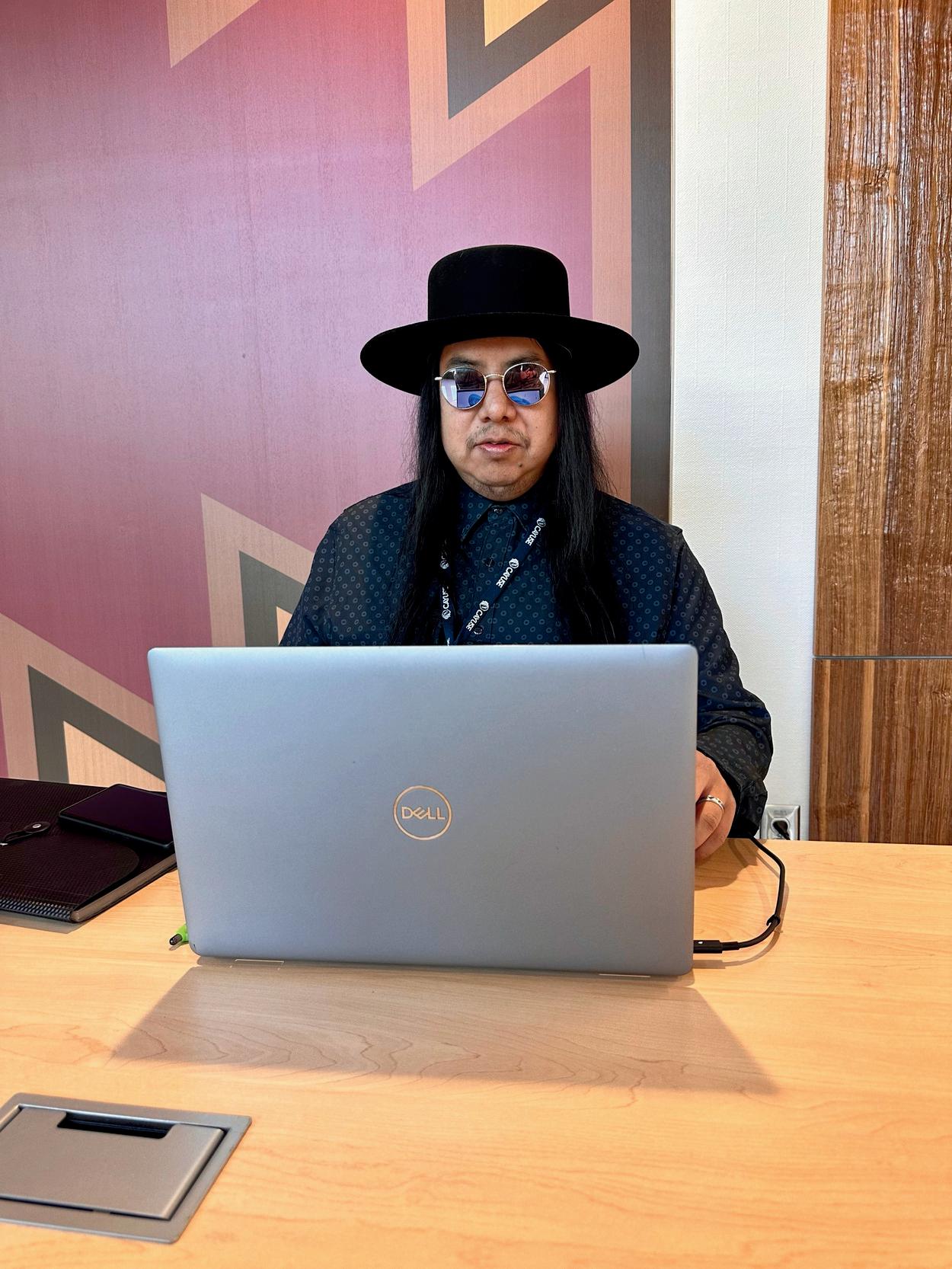
1st & 3rd Friday 9:00 AM - NOON Nixyaawii Community Financial Services
1st & 3rd Thursday NOON - 3:00 PM
Devices & Digital Navigation services are available to all residents of the Umatilla Indian Reservation. There are no income requirements. No tribal enrollment requirements. You will be asked to complete a short intake form. Our Digital Navigator will ask a few questions to assess your needs and determine the type of assistance we can provide to support (such as how to use the device, navigate the internet, or other specific support).
Leo.Wallahee@cayusens.com
www.CayuseNativeSolutions.com
Eastern Oregon leaders praise data centers, look to future
BERIT THORSON East Oregonian
When Amazon came to Eastern Oregon about 15 years ago, many people didn’t know what to expect from the large company setting up new buildings to serve as “data centers.” Today, many still don’t know exactly what a data center is, but for communities in Morrow and Umatilla counties, their presence has made a difference. In Morrow County, even with three of five data centers still in a tax-exempt status, Amazon Web Services pays more than $19 million in property taxes — that’s more than the next 16 largest taxpayers in the county combined. “They’re paying in for economic development, schools, all these things,” said David Sykes, Morrow County commissioner. “The government entities have more money to spend on services to the people. The health district gets more money, the county gets more money. It’s all increased.” Plus, Sykes said, having jobs through Amazon, in addition to other technology and industry positions, creates opportunities for young people and others in the workforce, which he said “contribute to us having a vibrant community in Morrow County.” The growth and development of data centers — and thus the impact of Amazon on progress in Morrow and Umatilla counties — is tied to the communities in which they’re located. One local Amazon Web Services employee, David Tanner, director of infrastructure operations, said he’s seen the growth firsthand. The partnerships between Amazon and local schools and organizations have created opportunities for building in-demand skills, he said. Morrow County ‘going in a good direction’ Torrie Griggs,
CEO of the Boardman Chamber of Commerce, said Amazon’s investments are helping drive the regional economy. “In Morrow County, their presence means good-paying local jobs, reliable tax revenue and funding that directly impacts our schools, emergency services and infrastructure,” she said. “These are real impacts that make a difference for the people who live and work here.”
According to Mike Gorman, Morrow County assessor and tax collector, Amazon represents close to half of the county’s taxable property value and its taxes account for about a third of the total levied in the county. In that way, he said, “it’s been very favorable” to have data centers in the county. Additionally, Gorman said, Amazon has agreements to pay money to enterprise zone sponsors in lieu of certain taxes, helping support community development projects, schools, housing and more across the five communities in Morrow County. “Things are definitely going in a good direction,” said Gorman. “We’re not stagnant, like maybe some of our neighboring counties to the south.” He added that continuing to build sites in this area will keep local contractors and other businesses busy. However, technology changes quickly and the company’s needs may shift, too. Since the first data centers popped up, storage capacity and energy requirements have changed, Gorman pointed out, and there’s no way for him to predict the local impact of future technology trends. Umatilla County looks forward Meanwhile, Umatilla County Commissioner Dan Dorran said he believes in the decades to come, Umatilla County will be seen as “a strong place to participate” in the industry. Dorran said the “thirst and hunger” has not diminished in the 15 years since Amazon

started paying taxes in Umatilla County. “It’s a driven industry and unless we all say, ‘OK, I don’t want to know any more than what I already know,’ that industry’s not going to slow down,” Dorran said. In Umatilla County, too, Amazon has a Strategic Investment Program agreement and several Long Term Rural Enterprise agreements in lieu of taxes, county Assessor Rachael Reynolds confirmed. Additionally, the data centers have created about 7,400 full-time equivalent jobs regionally, and Dorran said they have added about $9 billion to the gross domestic product in Eastern Oregon. Data centers also have a positive effect on another main industry in the area: agriculture. Using GPS in agriculture is becoming more common, and that data comes from centers like — if not actually — the ones in Eastern Oregon, Dorran said. “That’s how much we should be proud of Umatilla and Morrow counties, how much
they’re contributing to our progress,” he said. “ It’s just hard to find and recruit industries that have done what Amazon and the data centers have done for Umatilla and Morrow counties.” Dorran specifically mentioned Amazon’s philanthropic contributions, such as supporting local events or contributing financially to buildings or community services. Some of these things, he said, wouldn’t have even started or survived without Amazon’s support, “and now they’re thriving on their own.” The company also, from his perspective, pays it forward with projects they need for their centers but that will also be used by others, like roads or energy substations. Dorran said he knows there are detractors but hopes people see the benefits the region has gained because of the data centers here. Looking to the future, Dorran said he sees a strong continued partnership with the tech giant.
Rainwater gets new name; more changes coming
CHRIS AADLAND
CUJ
MISSION – A tribal wildlife area in the Blue Mountains being managed to improve habitat health and increase access to First Foods has a new name, with more changes planned for the southeast Washington property.
Since the Confederated Tribes of the Umatilla Indian Reservation (CTUIR) purchased more than 8,500 acres of a former ranch near Dayton, Washington, using federal Bonneville Power Administration (BPA) mitigation funds, the tribe has called the property of about 11,000 acres of CTUIR aboriginal title lands the Rainwater Wildlife Area.
But now, the property is the Tátwin Wildlife Area after a renaming process recently concluded.
Soon, pending an expected approval from the federal government, hunting and gathering at the site will be open to tribal members only.
The new name means “shooting light,” Andrew Wildbill, CTUIR Department of Natural Resources Wildlife Program manager, said. Tátwin was a village site or annual rendezvous spot for the Umatilla Cayuse, Walla Walla and Nez Perce people on the Touchet River near where the currentday wildlife area is. The tribe is now
completing the formal rebranding process and changing signage, he said.
More changes are in the works now that the process of placing Tátwin, which had formerly been classified as fee land, into trust is wrapping up, DNR officials said during a May 29 tour.
The CTUIR hosted the tour for mostly DNR staff members. Tour leaders shared plans of upcoming forest thinning and prescribed burning operations to make the area more resilient to wildfire and help preferred species of wildlife and plants thrive, in addition to discussing steps tribal land managers have taken – or plan to – in recent years to protect the land and its First Foods.
Tour leaders highlighted recently completed floodplain restoration work on the North Fork Touchet River designed to improve the river’s health, so salmon and steelhead numbers improve, as well as talked about an upcoming habitat revitalization project planned for the South Fork Touchet River, which flows through Tátwin.
But attendees also learned about what will likely be the most noticeable change at Tátwin: Limiting what Wildbill called “consumptive uses” on the property to tribal members.
That means “hunting and gathering will be prohibited to non-tribal

members,” Gerald Middel, Rainwater/ Wanaket Wildlife Area project leader, said during the tour.
The move is meant to better protect the land and give CTUIR members greater access to First Foods, said DNR officials and Tátwin managers.
Access changes
Tátwin is a diverse area with habitats that include conifer forest, grassland, shrubland, riparian and 10 miles of streams accessible to anadromous fish that flow into the Touchet River.
Data centers in Umatilla and Morrow counties are expanding their presence in terms of economic impact. These centers, county leaders say, offer a significant and stable tax base.
AMAZON WEB SERVICES
A landscape photo from the Tátwin Wildlife Area, formerly known as the Rainwater Wildlife Area, near Dayton, Washington. The Confederated Tribes of the Umatilla Indian Reservation’s Department of Natural Resources recently renamed the area. DEPARTMENT OF NATURAL RESOURCES
Environmental groups take Oregon to court over renewable diesel refinery on Columbia River
ALEJANDRO FIGUEROA OPB
Two Oregon environmental groups are asking a court to boot a water quality permit for a proposed $2.5 billion renewable diesel refinery back to state regulators.
Hood River-based Columbia Riverkeeper, two local people and the Northwest Environmental Defense Center – a Portland-based nonprofit –have filed a lawsuit in the Multnomah County Circuit Court, claiming a water quality certification the Oregon Department of Environmental Quality issued to NXTClean Fuels earlier this year is “legally deficient.” They are asking the court to send that certification back to DEQ for revision.
“With the type of permit that it is, under the Clean Water Act, the state is supposed to ensure that the facility will not be violating our water quality standards,” said Audrey Leonard, an attorney with Columbia Riverkeeper. “And the conditions on this permit are not protective enough. They’re pretty boilerplate conditions.”
For years, local people and environmental groups have raised concerns the facility could pollute the Columbia River, damage a system of dikes and levees that control water drainage in the area and disrupt nearby working farms.
NXTClean Fuels, also known as NEXT Renewable Fuels, is a Houstonbased company proposing to build a large refinery outside Clatskanie at Port Westward, a small industrial park with deep-water access to the Columbia River.
If built, the facility would be able to crank out up to 50,000 barrels a day, or about 750 million gallons a year, of sustainable jet fuel and renewable diesel made with fish grease, used cooking oil and other oils from agricultural crops like soybeans.
Renewable diesel is chemically similar to petroleum-based fuels, which makes it compatible with traditional fossil fuel engines.
Researchers estimate refineries produced about 340 million gallons of sustainable aviation fuel last year, but they expect that number to climb rapidly as companies like NEXT continue developing new projects.
NEXT claims the Oregon facility would generate $45 million per year in local and state tax revenue once in operation and create 240 jobs. Local elected officials and union groups have expressed support for the project.
But some residents and farmers say the risks to the environment outweigh the economic benefits. They say the proposed site sits on loose, unstable soils with a shallow water table and would be prone to liquefaction in the event of a strong earthquake.
“Why would you want to build this facility that is heavier than what we already have out there with more rail cars, more vibration than we have out there and more toxic chemicals that you’re bringing into this region,” said Wendy Schmidt, a farmer and a copetitioner in the lawsuit.
Schmidt primarily grows hay and oats and raises livestock at her farm. Her property is adjacent to the proposed

site. She said if built, the refinery could cause irreparable damage to nearby farms and crucial habitat for migrating salmon on the Columbia River.
“If this facility does go through, there’ll be no more agriculture out here. Because no one will be able to survive it,” Schmidt said.
Some of the tenants at the Port Westward Industrial Park include Portland General Electric’s Beaver Power Plant and the Columbia Pacific Bio-Refinery – which bills itself as the largest ethanol manufacturing facility on the West Coast.
Back in January, DEQ issued NEXT a so-called 401 water quality certification, which certifies the construction and operation of the refinery will comply with state water quality standards. The company needs this state certification before it can receive other federal permits to move forward.
But environmental groups argue DEQ failed to include sufficient conditions in the permit to protect water quality, saying, for example, the state agency ignored the seismic vulnerability of the refinery site, which has soils that could act like a liquid during a strong earthquake, said Leonard.
Columbia Riverkeeper initially appealed DEQs approval of the permit, and asked the agency to reconsider its decision. But in May, DEQ denied that petition for reconsideration. In its reasoning, the agency said seismic standards are addressed in local building codes, and are not waterquality related.
Michael Hinrichs, a spokesperson for NEXT, told OPB the environmental group’s decision to challenge the permit is not surprising.
“This is the standard playbook of Columbia Riverkeeper. They appeal every single decision, and we understand that strategy,” he said. “That’s why we anticipate it all the time.”
Hinrichs said the company has done rigorous research and worked to comply with federal and state
regulations.
“The state adhered to its regulations. It made the correct decision. It was asked for reconsideration, and they denied it because they made their decision based on state regulations,” Hinrichs said. “And we anticipate the permit to be upheld.”
Hinrichs said that NEXT is still set to begin construction this year, though
it still needs several other permits, including an environmental impact assessment from the U.S. Army Corps of Engineers. That federal agency is set to release a draft assessment later this summer, which will be followed by a public hearing.

The Columbia Pacific Bio-Refinery in the distance in the Port Westward Industrial Park, Clatskanie, Ore., May 30, 2025. ALEJANDRO FIGUEROA/OPB
Tribes push back on Umatilla County nuclear expansion bill
Bill would allow the county to pilot a small modular nuclear reactor project
ANTONIO SIERRA
OPB
SALEM – Oregon lawmakers are considering softening a 45-year-old statewide ban to allow nuclear power in Umatilla County. The legislation has the backing of the county government, while tribal leaders are opposed.
House Bill 2410 received its first public hearing in front of the House Committee on Climate, Energy and Environment last week. Oregon voters effectively banned all new nuclear energy facilities in 1980, but the bill would create a carve out so that Umatilla County could start a small modular nuclear reactor pilot project.
State Rep. Bobby Levy, R-Echo, is one of the bill’s chief sponsors, and although the legislation is mostly backed by Republicans, it’s picked up a couple of Democratic supporters. State Rep. Emerson Levy, D-Bend, told the committee why she was backing the bill.
“With AI on our phones, that consumes an incredible amount of energy,” she said, “We need to make sure we have a clean way to address these long term energy needs.”
Testimony poured in from across Oregon and the Northwest, with both supporters and detractors making familiar arguments.
Proponents said small modular





nuclear reactors, or SMRs, are a promising piece of technology that would allow utilities to harness a massive amount of reliable, low-carbon energy without the development costs that come with traditional reactors. They argued the smaller size of SMRs negates much of the meltdown risk associated with larger reactors, and waste they produce can be safely stored out of harm’s way. SMRs are being championed by Amazon, which wants to build several in southeastern Washington to power Eastern Oregon data centers.
Opponents of the bill said nuclear waste remains a real threat to public health and the environment, especially because the U.S. still doesn’t have a national repository for spent nuclear material. They added that SMRs are more wishful thinking than a proven technology, with previous projects coming in over budget and underperforming.
The Confederated Tribes of the Umatilla Indian Reservation is one the bill’s opponents. Board of Trustees member Lisa Ganuelas pointed to the Hanford Site in southeast Washington, a former plutonium manufacturing facility that remains heavily polluted decades later.
“CTUIR knows from previous experience that nuclear waste is a burden



that will be with us for millennia and unless and until a specific repository is selected, that it is almost certain that any newly generated nuclear waste will stay in Umatilla County and within CTUIR ceded lands indefinitely,” she said.
Cathy Sampson-Kruse, a CTUIR member and a longtime critic of nuclear energy, brought historical pictures of the tribes and said there was a long history of the tribal government not being involved in the decision making process.
“We hear the talk behind closed doors that do not consult us – tribes,
treaties and the trust responsibilities,” she said. “It really disheartens us as a people.”
Other locals from Eastern Oregon wrote testimony opposing the bill over environmental and quality of life concerns. Pendleton resident Jennifer Abney name-checked Amazon in her opposition.
“I don’t want a nuclear plant in my backyard, nor Amazon using more of our water … Please listen to the voters,” she wrote. “An oligarch should not be able to bypass the law, nor should the counties.”
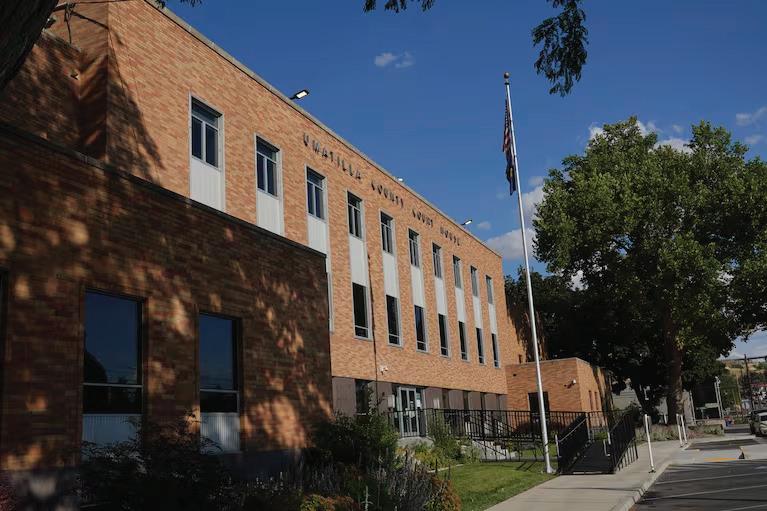


























































The Umatilla County Courthouse in Pendleton. ANTONIO SIERRA/OPB
Tribal leaders ditch enhanced ID projects
CHRIS AADLAND CUJ
MISSION – Tribal leaders have decided to discontinue pursuing an enhanced tribal identification card that would make travelling by air easier and instead reimburse enrolled members who get a passport or state-issued ID.
Since 2023, Confederated Tribes of the Umatilla Indian Reservation (CTUIR) staff had been working with a contractor on an enhanced tribal ID card project. The proposed IDs would have been used instead of a passport to visit Canada or Mexico and ensured quicker passage through security checkpoints when flying domestically.
But amid climbing costs to complete the project and unexpected long-term administration expenses, the Board of Trustees (BOT) decided recently to cancel the project and establish a program to reimburse tribal members for costs associated with obtaining a passport or state ID.
“The real advantage of it is, you can use a tribal ID to get across the border to Mexico and Canada,” CTUIR Enrollment Director Toni Minthorn said of the enhanced tribal ID at a May 23 BOT work session. “There really aren’t any other super big advantages to it.”
Minthorn and Enrollment Administrative Office Manager Elfrina Lubrin, who led work on the project, brought up potentially abandoning the idea during the May meeting. The BOT then voted via a motion to cancel the enhanced tribal ID project in favor of compensating tribal members who get a passport or state-issued ID that can be used at airports starting June 2.
Tribal staff, according to the motion, were directed to propose a plan to establish a passport funding program by July 31.
The CTUIR could launch the reimbursement program as soon as this fall, Interim Deputy Executive Director Paul Rabb said in May.
Practicality and cost concerns
At the May 23 work session, tribal staff shared updates on the project’s progress, as well as a proposed design for the ID cards. The new IDs would have been laser-engraved, scannable and “chipped.”
“We’re at the point where we either go with it or we don’t go with it,” Minthorn said. “Do we want to keep going with this project?”
The tribe’s current tribal ID, while not able to be used to cross the border into Canada or Mexico, can be used to fly anywhere in the U.S.
But Transportation Security Administration (TSA) agents aren’t trained to recognize most tribal IDs, including the CTUIR’s current offering, which can sometimes result in delays for tribal members trying to board a commercial flight.
Enhanced tribal IDs would have avoided that issue because they would have been recognized as acceptable forms of identification when scanned by TSA or U.S. Customs and Border Protection agents, who would also
be trained to recognize them, tribal officials said.
The CTUIR would have joined 13 other tribes that offer enhanced IDs if the tribe decides to continue pursuing it. Three dozen other tribal nations are in the process of offering them, Lubrin said.
In addition to finalizing a proposed design and inking service and interagency agreements for implementation, the tribe had also completed agreements with the U.S. government for the CTUIR to participate in the enhanced ID initiative and have its new cards entered into a federal database for easier recognition.
Lubrin said it would have probably been at least another year before the CTUIR was ready to begin offering new tribal IDs to tribal members.
But unexpected complications, such as long-term expenses, led tribal staff working on the project to question whether it should be completed, officials told tribal leaders in May.

Implementing the enhanced ID program would have cost between $10,000 and $15,000 a year, officials said. Those expenses would come from annual training required for tribal staff involved in managing the enhanced tribal ID program, the costs of producing the high-tech ID cards, paying a contractor to help roll out the program and annual contracts for technology and software support.
“After working on this project for a couple of years, I’m pretty sure we’d both be a lot more happy with just giving people a passport,” Minthorn said of herself and Lubrin. “This project has become extremely difficult, way more complicated than we could’ve imagined.”
However, canceling the project would also mean that the tribe would have to pay a consulting firm hired to help develop the program and guide the CTUIR through the process about $33,000, even though it wouldn’t complete any additional work, Lubrina said at the May meeting.
The tribe has already spent about $200,000 on the project, Minthorn added.
Although he said he liked the design of the new IDs, BOT Treasurer Raymond Huesties said the tribe probably should have developed a plan to pay for tribal member passports over the enhanced ID initiative, adding that he was concerned the tribe was “reinventing the wheel” due to the expensive security features on the new ID cards and costs with administering the program.
“We’ve already forked over a lot of money but if we’re on the hook for even more money to keep them maintained, I don’t know if that’s going to be fiscally responsible,” he said.












Trump just unraveled years
of
work on tribal rights, salmon and clean energy. What’s next?
The president pulled the federal government out of Columbia River management deal

TONY SCHICK OPB
Less than two years ago, the administration of President Joe Biden announced what tribal leaders hailed as an unprecedented commitment to the Native tribes whose ways of life had been devastated by federal dambuilding along the Columbia River in the Pacific Northwest.
The deal, which took two years to negotiate, halted decades of lawsuits over the harm federal dams had caused to the salmon that had sustained those tribes culturally and economically for thousands

of years. To enable the removal of four hydroelectric dams considered especially harmful to salmon, the government promised to invest billions of dollars in alternative energy sources to be created by the tribes.
It was a remarkable step following repeated failures by the government to uphold the tribal fishing rights it swore in treaties to preserve. The agreement is now just another
of those broken promises.
President Donald Trump signed a memorandum on Thursday pulling the federal government out of the deal. Trump’s decision halted a governmentwide initiative to restore abundant salmon runs in the Columbia and Snake rivers and signaled an end to the government’s willingness to consider removing dams that blocked their free flow.
Thursday’s move drew immediate condemnation from tribes and from environmental groups that have fought to protect salmon.
“The Administration’s decision to terminate these commitments echoes the federal government’s historic pattern of broken promises to tribes,” Yakama Nation Tribal Council Chair Gerald Lewis said in a statement. “This termination will severely disrupt vital fisheries restoration efforts, eliminate certainty for hydro operations, and likely result in increased energy costs and regional instability.”
The government’s commitment to tribes, however, had been unraveling since almost when the deal was inked.
Key provisions were already languishing under Biden. After Trump won the presidency, his administration spiked most of the studies called for in the agreement, held up millions of dollars in funding and cut most of the staff working to implement salmon recovery. Biden’s promise to seriously consider the removal of dams gained little traction before it was replaced by what Trump’s energy secretary, Chris Wright, called “passionate support” for keeping them in place.
The chair of the White House task force to implement the agreement quit in April because of what he saw as Trump’s efforts to eliminate nearly everything he was working on.
“Federal agencies who were on
the hook to do the work were being destroyed through untargeted, inefficient and costly purges of federal employees,” Nik Blosser, the former Columbia River Task Force chair, told ProPublica and OPB. “When I left, most things were on hold or paused — even signed contracts were on hold, which is a disgrace.”
Trump’s White House announcement called the Biden administration’s commitments “onerous” and said the president “continues to deliver on his promise to end the previous administration’s misplaced priorities and protect the livelihoods of the American people.”
“President Trump is committed to unleashing American energy dominance, reversing all executive actions that impose undue burdens on energy production and use,” the announcement read.
But the decision could also have some unintended consequences, experts say.
Trump signed an executive order in April to “restore American seafood competitiveness” but in revoking the Columbia River agreement has canceled millions of dollars to support the programs that seed the ocean with fish to catch. He signed a separate executive order on his first day in office to “unleash American energy dominance” but has now reversed a commitment, made under the Biden salmon deal, to build new sources of domestic energy. This week’s action has sent federal agencies back to court, where judges have repeatedly shackled power production at hydroelectric dams because of its impact on the endangered fish.
“It’s tempting to comment at length on the absurdity of the President’s order, including the fact that what he says he wants — stability for power
generation — is in fact put more at risk by this action,” Blosser wrote in a post on LinkedIn. “Instead, I’ll look for inspiration to the mighty salmon, who don’t stop swimming upstream when they get to a waterfall.”
Back to court
Before they began negotiating the Columbia River Basin agreement in 2021, federal agencies had been losing in court over the hydropower system for more than 20 years. Judge after judge ordered the federal government to use less water for making electricity and instead let more of the river spill through the dams’ floodgates so that fish could more safely ride the current past them.
The accord with states and tribes guaranteed up to a decade without those lawsuits. Trump canceled that.
The Bonneville Power Administration, which sells the hydroelectricity from federal dams, had more at stake than the rest of the agencies in the deal. When the government signed it, Bonneville Administrator John Hairston said it provided “operational certainty and reliability while avoiding costly, unpredictable litigation in support of our mission to provide a reliable, affordable power supply to the Pacific Northwest.”
In its most recent annual report, Bonneville credited the agreement for giving it the flexibility to increase hydropower production during times of high electricity demand, which helped stem the losses in an otherwise difficult financial year.
A major component of the agreement was the acknowledgment of the region’s dependence on hydropower and the need to build new sources of energy before removing the dams. It offered no guarantee of dam
Tanks filled with thousands of coho salmon at the Melvin R. Sampson Coho Hatchery in Ellensburg, Wash., Dec. 1, 2021. KRISTYNA WENTZ-GOFF/OPB
Water moves through a spillway of the Lower Granite Dam on the Snake River near Almota, Wash., April 11, 2018. NICHOLAS K. GERANIOS/ASSOCIATED PRESS
After reaching historic lows, hydropower generation in the Northwest expected to rise in 2025
ALEX BAUMHARDT Oregon Capital Chronicle
After dropping to historic levels last year due to ongoing drought and high temperatures, hydropower generated in the Northwest is expected to rise slightly this year from much needed precipitation.
Hydropower in the region is expected to increase about 17% compared to last year, a welcome boost to growing energy demand, but will still be below the 10-year average, according to the U.S. Energy Information Administration.
Officials at the Energy Information Administration published their 2025 forecast on May 19, as well as annual expectations for water supplies in key river basins generating the hydroelectricity.
Overall hydropower generation in the U.S. is expected to rise 7.5% in 2025, which will also still keep overall hydropower generation below the 10year average. Hydropower represents about 6% of the country’s electricity.
The increase in hydropower expected in 2025 is due in large part to above average precipitation in northern California, Oregon and eastern Washington during the past winter and this spring. Parts of southeast Oregon received record rainfall this spring, causing Gov. Tina Kotek in March to declare a state of emergency.
Despite the increased precipitation
in some parts of the state, the Upper Columbia River Basin near Grand Coulee Dam in Washington will have a below-normal water supply this year when compared to the past 30 years, according to the National Oceanic and Atmospheric Administration’s Northwest River Forecast Center. Water supply will be about normal or above normal in the southern portion of the Columbia River, which includes the Snake River Basin.
Eleven Western states produce up to 60% of the country’s hydroelectricity. Washington, California and Oregon are the three largest contributors, with dams in Oregon and Washington producing more than one-third of all U.S. hydropower. About 40% of the electricity used in Oregon comes from the region’s hydroelectric dams.

But ongoing drought, periods of low precipitation and rising summer temperatures that melt mountain snowpack too quickly have led to lowerthan-usual power generating capacity at dams in the West.
Both Oregon and Washington generated 20% less hydropower in 2023
than they did in 2021, and hydropower generation in the Northwest dropped to a historic 22-year low between Oct. 2022 and Sept. 2023. Hydropower generated in 2024 was the lowest it’s been since 2010, according to the federal Energy Information Administration.
The loss in generating capacity has cost the hydropower industry billions in revenue in recent years, according to researchers from the University of Alabama. The sector
lost about 300 million megawatt hours of power generation between 2003 and 2020 due to drought and low water compared with the long-term average, equating to about $28 billion in lost revenue. Half of the drop in power generation was due to drought in Oregon, Washington and California. In Oregon, the hydroelectricity sector is estimated to have lost more than $1.5 billion in revenue over those 18 years..
DCFS mulls child care increases, asks public for feedback
CHRIS AADLAND
CUJ
MISSION – Tribal members who receive financial assistance from the Confederated Tribes of the Umatilla Indian Reservation (CTUIR) to pay for child care could soon have their costs increase slightly.
The Department of Children and Family Services (DCFS) Family Engagement Program held the first planned public information sessions on June 23 to outline proposed changes – including cost increases –to its Child Care Development Fund (CCDF) plan and take feedback from community members about how the CTUIR could improve offerings.
DCFS officials are also asking community members to complete an anonymous survey to get a better idea of how to better serve families and children.
The CCDF is a federal program that financially supports child care programs through options such as providing child care subsidies or offering provider licensing and background checks.
To receive the money, the CTUIR must provide a plan for approval from the federal government for how it will spend its funding, officials said at a June 23 session.
The Board of Trustees (BOT) would also need to approve the updated plan and its cost increases.
Dionne Bronson, the Family Engagement Program manager, said she hoped to present the plan to the BOT during the summer so the federal government could OK it to be implemented in the fall.
Tribal families who are approved to receive CCDF assistance can use it to help pay for child care at the CTUIR’s Átaw Miyánašma Learning Center or other approved area providers.
Potential changes include the sliding fee scale for families that receive CCDF money to help pay for child care the CTUIR uses to determine a family’s share of child care costs.
While the increased fees for families could result in more money being available to help more CTUIR families afford child care, they’re primarily meant to “foster and promote the selfsufficiency and parent responsibility of paying from some of that co-pay,” Bronson said.
It is tentatively set to take effect on Oct. 1.
For the lowest-income parents, those who make up to 100% of the federal poverty guideline, monthly copays would increase from $0 to $13 for one child. Parents in the same income bracket with four children would see their costs jump from $0 to $27 and to $56 for those with 8 children.
Another example of proposed copay increases includes parents who make 150% of the federal poverty
guideline with one child paying $78, compared to a previous $36, while those who earn up to 250% of the federal benchmark with two children would see their co-pays jump about 7% to $308.
The plan update also comes as the CTUIR has discussed in recent years about the need for more, and affordable, child care options available to tribal members and potential strategies to address the issue.
At one of the two June 23 public meetings, tribal member parents and area child care providers discussed the proposed changes, in addition to DCFS officials seeking input on questions about the CTUIR’s child care programming and what other support or resources the tribe could provide.
Attendees spoke of challenges in providing or paying for child care and for ways to better collaborate with providers and parents, as well as offering suggestions – such as how to improve care of children with special needs and making the process of applying for financial assistance easier to understand – the CTUIR could implement to improve the child care experience of families.
Since tribal leaders have expressed interest in addressing child care concerns in recent years, Bronson said the purpose of the survey and information sessions was to learn about
areas where community members feel the CTUIR could improve and where, or how, improvements could be incorporated into the new CCDF plan.
Some of the suggested changes, such as more clearly defining eligibility requirements and what types of employment or job training qualify, have already been incorporated into the updated plan.
For more information about the CCDF survey and a QR code to submit feedback, go to ctuir.org/departments/ children-and-family-services/familyengagement.
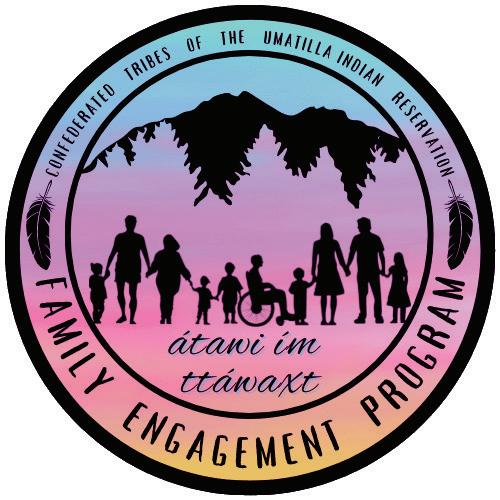
Water flows out of the Bonneville Dam along the Columbia River between Multnomah County, Oregon and Skamania County, Washington. on Tuesday, July 23, 2024.
JORDAN GALE/OREGON CAPITAL CHRONICLE
Trump just unraveled years of work on tribal rights, salmon and clean energy. What’s next?
removal.
The Bonneville Power Administration, which sells the hydroelectricity from federal dams, had more at stake than the rest of the agencies in the deal. When the government signed it, Bonneville Administrator John Hairston said it provided “operational certainty and reliability while avoiding costly, unpredictable litigation in support of our mission to provide a reliable, affordable power supply to the Pacific Northwest.”
In its most recent annual report, Bonneville credited the agreement for giving it the flexibility to increase hydropower production during times of high electricity demand, which helped stem the losses in an otherwise difficult financial year.
A major component of the agreement was the acknowledgment of the region’s dependence on hydropower and the need to build new sources of energy before removing the dams. It offered no guarantee of dam removal.
Earthjustice attorney Amanda Goodin, who represents the environmental advocates who signed the agreement, said the Trump administration’s actions would force a return to courts.
More fish will die
The White House said that Trump’s revoking of the Columbia River deal shows that he “continues to prioritize our Nation’s energy infrastructure and use of natural resources to lower the cost of living for all Americans over speculative climate change concerns.”
Shannon Wheeler, chair of the Nez Perce Tribe, said the damage on the Columbia River is anything but speculative.
“This action tries to hide from the truth,” Wheeler said in a statement.
“The Nez Perce Tribe holds a duty to speak the truth for the salmon, and the truth is that extinction of salmon populations is happening now.”
Wild salmon populations on the Columbia and its largest tributary, the Snake River, have been so sparse for decades that commercial, recreational and tribal subsistence fishing are only possible because of fish hatcheries, which raise millions of baby salmon in pens and release them into the wild when they’re old enough to swim to the ocean.
In some years, an estimated half of all the Chinook salmon commercial fishermen catch in Southeast Alaska are from Columbia River hatcheries, making them critical for “restoring American seafood competitiveness” as Trump aimed to do.

that equipment failures have killed thousands of baby fish.
As ProPublica and OPB previously reported, the number of hatchery salmon surviving to adulthood is now so low that hatcheries have struggled to collect enough fish for breeding, putting future fishing seasons in jeopardy.
“The agreement formed the basis for the stay of litigation,” Goodin said, “so without the agreement there is no longer any basis for a stay.”
But some Columbia River hatcheries are nearly a century old. Others have been so badly underfunded

The Biden administration promised roughly $500 million to improve hatcheries across the Northwest. His administration never delivered it, and Trump halted all the funds before eventually canceling them with this week’s order.
Mary Lou Soscia, former Columbia River coordinator at the Environmental Protection Agency, said the administration’s dismantling of salmon recovery programs amounts to “cutting off your nose to spite your face.”
“We’re losing decades of accomplishments,” said Soscia, who spent more than 30 years at the agency.
“When the fish managers aren’t there to make real time river decisions, more fish will die,” she said. “Or the watershed restoration work will take a lot longer to happen because you won’t have funding, and more fish will die.” Continued from page 9
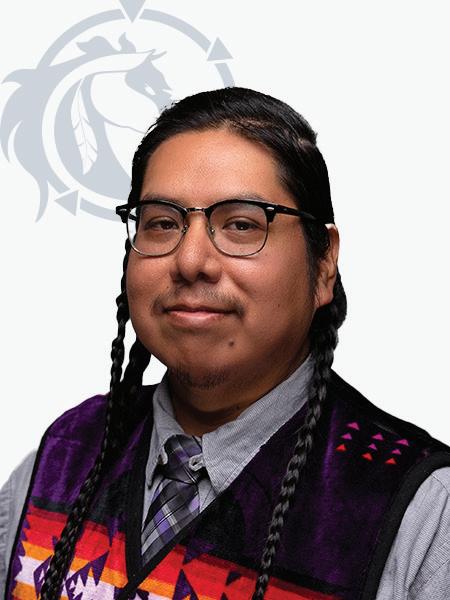


The salmon viewing area at the Bonneville Lock and Dam, August 2021. KRISTYNA WENTZ-GOFF/OPB






















































































































10X ENTRY MULTIPLIER








































































































































































































































































What’s needed to get spring Chinook back to Walla Walla? Cooperation and patience
SUSAN SHAIN Northwest Public Broadcasting
In a tiny cement room under a big steel-and-cement bridge, Jerimiah Bonifer stood at a rectangular window. Through the plexiglass pane, he had an underwater view of the Walla Walla River, which flows from the Blue Mountains to the Columbia River.
A camera sat trained on the window, collecting data that would be hand-reviewed by staff at the Confederated Tribes of the Umatilla Indian Reservation, or CTUIR.
Bonifer, who manages Fisheries Program for the CTUIR, was excited by what the camera had captured: more than 900 spring Chinook salmon swimming past this bridge in Milton-Freewater, Oregon, as of late June.
That number is a significant jump from past years: roughly 500 in 2024 and roughly 60 in 2023. The growing numbers of Chinook are the result of decades of work by the CTUIR, as well as extensive collaboration with the Bonneville Power Administration and the governments of Washington and Oregon.
The CTUIR soon hopes to have a self-sustaining population of Chinook, with runs big enough to allow for tribal harvest.
“ With spring Chinook actually returning in harvestable numbers, we’re gonna be restoring a connection to landscape that’s been missing for quite a while,” said Bonifer, who’s a CTUIR member. “This relationship with the landscape, this relationship with the foods, is essential to our culture.”
A ‘First Foods’ mission
Spring Chinook went extinct in the Walla Walla River about a century ago, after infrastructure built in the river caused it to run dry in the summers. Bonifer said other factors contributed to the extinction, too: overfishing, overallocation of water, and a lack of screens on irrigation systems, which meant salmon would pour onto farmers’ fields.
The loss of the salmon was devastating to the CTUIR. For the tribes, the fish are more than just a food source; they’re an integral part of their culture. So much so, the mission statement of the tribes’ Department of Natural Resources is to “protect, restore, and enhance the First Foods” — water, salmon, deer, roots and huckleberry that represent the region’s Indigenous people.
As Bonifer put it: “These natural resources and cultural resources, we don’t separate ‘em. They’re necessary for our existence.”
So in 2000, the CTUIR began making a pointed effort to bring Chinook back to the Walla Walla Basin. It started by planting adults, and later juveniles, or smolts, from the Carson National Fish Hatchery into the river.
But not many salmon returned in the following years. And besides, releasing salmon from a different location seemed incongruous with the tribes’ ultimate goal
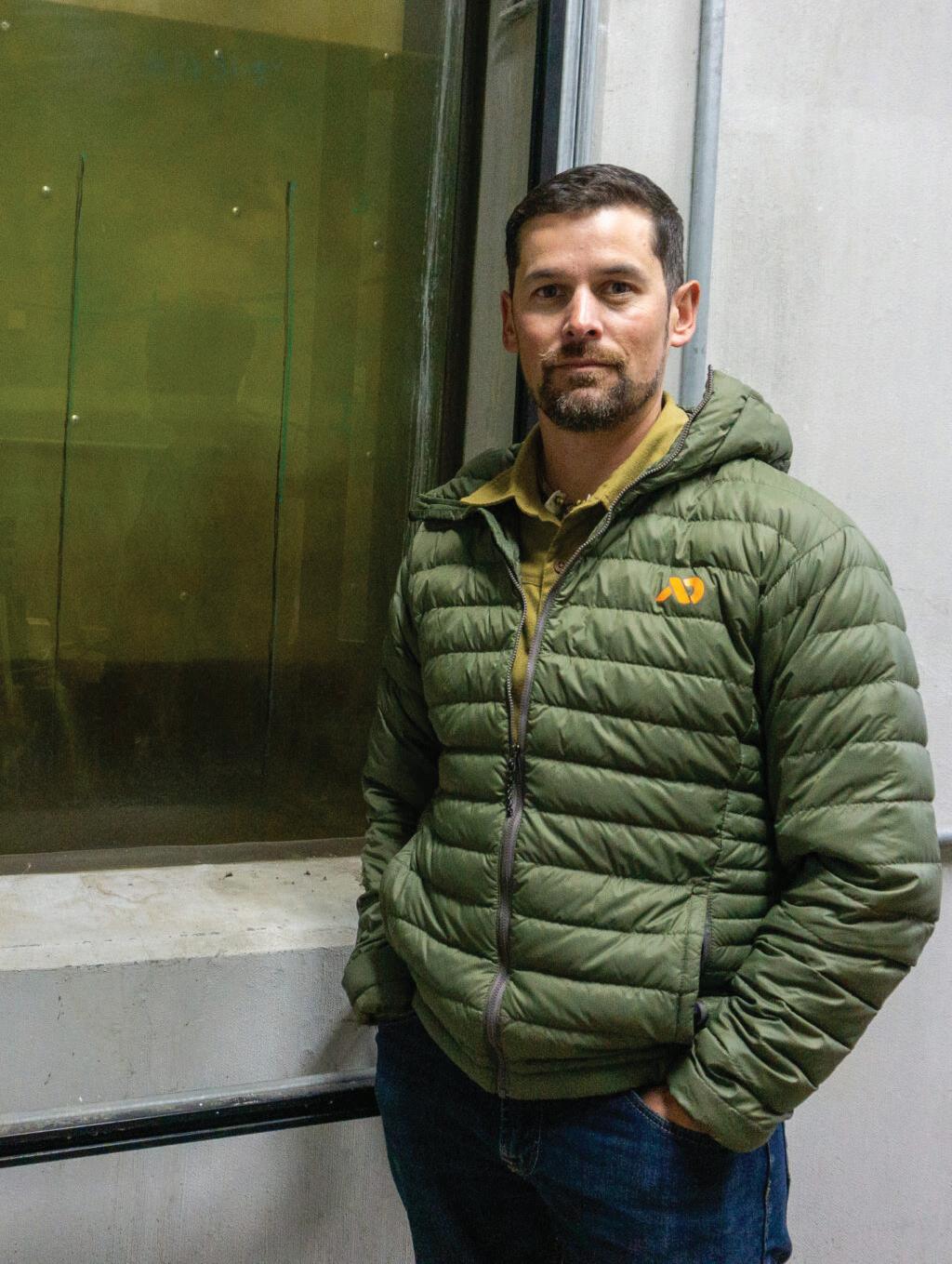
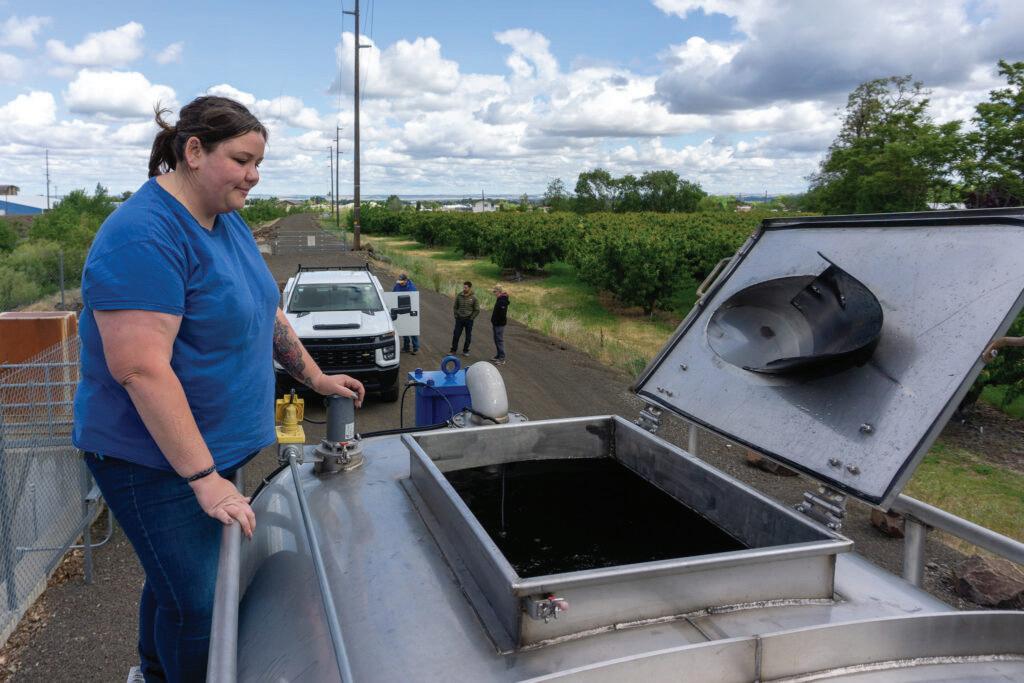
of a naturally spawning local population. So the idea for a CTUIR-owned hatchery was born.
But first, the water flowing down the Walla Walla River which needed to be colder and more plentiful for the fish to survive their passage — had to be addressed.
“ Fish gotta have water,” Bonifer said. “We’re gonna work our tail off to get these fish back. But if we don’t have sufficient flows in the river to support these populations, it’s just not possible.”
A groundbreaking new law
The tribes weren’t the only ones concerned about water in the Walla Walla Basin.
Brook Beeler, the eastern region director for Washington’s Department of Ecology, said that there had been “decades of frustration” because there wasn’t enough water to meet the needs of everyone: farmers, industry, cities and tribes.
So in 2009, Washington’s Legislature developed a pilot program that gave those in the Walla Walla Basin more flexibility in managing their water. Despite some successes, the program didn’t result in more water in the streams — a necessity for fish migration. And after a decade, the CTUIR asked the state of Washington for more help.
The Legislature directed the Department of Ecology to get involved again — and this time, to include the state of Oregon, as well. The result was the Walla Walla Basin Advisory Committee.
Modeled after the Yakima Basin Integrated Plan, which started in 2013, Walla Walla’s committee includes representatives from government, agriculture, business, recreation, conservation and more. The group also encourages the public to attend its monthly meetings.
“The overarching goal is to have that durable supply for everyone,” Beeler said. “People, farms and fish.”
In comparison to the pilot project, the new committee makes decisions by consensus rather than votes. Beeler said that’s been key to its success.
“Whereas before you could really just sit in your camp and vote how you wanted, now it really forces dialogue and understanding,” she said. “You have big irrigated ag folks talking about how cool fish releases are.”
The committee’s biggest accomplishment, Beeler said, has been pushing for two new laws that allow the state of Washington to collectively manage water in the Walla Walla Basin with Oregon.
To understand why that matters, imagine each state has a big water cooler, and that residents have a number showing where they are in line to get that water. Those who’ve had water rights for a long time are at the front of the line. Those who are newer to the game are at the back.
In the past, if Oregon found a way to conserve some of its water, that water would flow into Washington’s water cooler. All of a sudden, the people at the back of Washington’s line would get some water — completely negating Oregon’s efforts to reduce its usage. And due to long standing water laws, neither state could do anything about it.
But now, when someone in Oregon adds more water to the proverbial cooler that is the Walla Walla River, Washington’s Department of Ecology can preserve that water, too, ensuring it flows all the way to the Columbia River and out to sea. The laws that allow this were among the first of their kind nationwide.
“It’s pretty remarkable,” said Dylan Hedden-Nicely, a professor and head of the Native American law program at the University of Idaho and citizen of the Cherokee Nation. “I think that this serves as maybe an example or a precedent for better intergovernmental, transboundary water resources management.”
While Hedden-Nicely wasn’t familiar with the specifics of the laws or their origins, he said the notion that states worked together and prioritized fish passage was noteworthy in itself.
“Usually states, pretty jealously, protect state sovereignty over water,” he said.
Jerimiah Bonifer, Fisheries Program manager for the Confederated Tribes of the Umatilla Indian Reservation (CTUIR), stands by the window through which CTUIR staffers can count fish. SUSAN SHAIN/NWPB
Emily Meshke, who works at the Confederated Tribes of the Umatilla Indian Reservation Imtwaha Fish Hatchery, stands atop a silver tank truck holding spring Chinook salmon. SUSAN SHAIN/NWPB

“So just the fact that these two states are engaging with each other on this level and making agreements that might limit one state’s or both states’ control over water resources, I really think is pretty groundbreaking.”
The first time water was protected through these news laws was in 2024, as part of a cooperative effort between the city of Walla Walla, the CTUIR and a nonprofit called the Washington Water Trust.
The city, which has some Oregon water rights despite being in Washington, agreed to put some of its Oregon water into an aquifer during the winter, when demand for water is lower. The city then diverts less water during the dry summer months using what’s stored in the aquifers instead — thereby preserving more stream flow for fish in Mill Creek, a tributary of the Walla Walla River. The project is on hold this year while some kinks are worked out but is expected to resume in 2026.
Greg McLaughlin works for the Washington Water Trust. In the West, he said there’s been a long history of litigation when it comes to water rights. But that attitude has been changing, especially in this region.
“There’s a lot of places where water is this kind of place of conflict — and truly in the Walla Walla, this is a place where partners are working on behalf of one another,” he said. “ There’s a real spirit of, ‘We can do more together than we can separately.’”
Beeler echoed that sentiment. She brought up an old saying: “Whisky’s for drinkin’ and water’s for fightin’.”
“That has really been what water management has been, up until the last, probably, 10 to 20 years,” she said. “We’re learning that you’re much more successful when you have all the interests working together towards common goals.”
500,000 smolt
Back at the bridge in Milton-Freewater, Emily Meshke opened the lid of a big silver tank truck. About 30 salmon swam around, the water burbling around them.
Meshke, who works at the CTUIR’s Imtwaha Fish Hatchery, was collecting these adult fish from the Walla Walla River to use as “broodstock.” She’ll put the fish into a holding pond to mature and spawn, thereby providing the hatchery with smolts that can be released in future years.
“It’s really, really cool to get to be part of a program that’s in its infancy still,” Meshke said of Imtwaha, which was completed in 2022. “ The returns we’re seeing this year are kind of showing that what we’re doing is working.”
Imtwaha, the first hatchery that’s fully owned and operated by the CTUIR, sits on a 12-acre site on the South Fork of the Walla Walla River, about nine miles from Milton-Freewater. The 33,000-square-foot building has dozens of tanks that see the salmon through their first two years of life.
The hatchery’s construction was funded by the Bonneville Power Administration, as part of its legally-required efforts to mitigate the impact of hydropower dams. The company also covers the hatchery’s ongoing operating and maintenance costs.
In 2023, the hatchery released 500,000 smolt — the first group of fish that it had reared from eggs to juveniles — into the Walla Walla River and Mill Creek. Now, those fish are returning as 4-year-old adults.
“I was just excited to see a lot of fish showing up,” said hatchery manager Thomas Tall Bull, who is Cayuse and an enrolled member of the Nez Perce tribe. Imtwaha’s program has continued to release another half-million smolt every
spring, with the eventual goal of having 5,000 return annually.
Those stark numbers reveal the limitations of these efforts: Surviving as a salmon is difficult, even with lots of help. It’s especially difficult when they must pass through a system filled with dams and other infrastructure. And when climate change is bearing down on them, too.
“I’m kind of worried about drought, kind of worried about fire, I’m worried about habitat — especially low flows and warmer temps,” Tall Bull said. “The tribe is doing their best to make up for that.”
And if the CTUIR succeed, Tall Bull said the return of spring Chinook would benefit far more than just the tribes.
Salmon “bring nutrients to the water from the ocean, not just to humans, but to all walks of life,” he said. “Everything flourishes with what salmon bring to the area, because they’re a keystone species.”
Earlier this spring, Bonifer thought there might be enough returning Chinook to have a harvest.
But the returns were about 100 fish shy of what the tribes’ Fish and Wildlife Commission was looking for. The agency only opens fishing after an adequate number of salmon have been captured for the hatchery and an adequate number have escaped to spawn naturally.
Still, Bonifer is hopeful it’ll happen next year. Or the year after that. Whenever it does, he will celebrate his people’s return to the river to catch spring Chinook, prepare them for ceremonies and feast together, as they have for millennia.
“ We’re not just thinking about today, we’re not just thinking about tomorrow,” Bonifer said. “We’re thinking seven generations ahead.”

Jerimiah Bonifer, Fisheries Program manager for the Confederated Tribes of the Umatilla Indian Reservation, looks for salmon in Milton-Freewater, Oregon. SUSAN SHAIN/NWPB
Letter to the Editor
Thanks
to all for helping in time of need
Dear Family and Friends, Our tribe has suffered so much loss this year. Our hearts go out to everyone who is still hurting as so many are mourning right now. It’s not easy for any one individual to keep it together for their family in times like this; coming together even though it feels like a big piece of you died with them or a hole formed in your heart. It will always hurt, every loss but family/our tribal community—for every loss our tribe has had to endure, our people are there to help lift that burden (funeral planning, drummers & cooks, hunters, officiants, speakers, memory cards, PWD diggers, participants in services, tule mat, ribbon shirt, to flowers).
The MARSH family thanks all of you (so, so much) who helped send our Brother/Dad/Uncle/Grandpa atway on his final journey. We had such hope until the very end that we weren’t expecting this outcome—least, not so suddenly. Everyone who stopped in to help comfort our family, helped Mom and Uncle Chris make the final arrangements (Burn’s/Waashat), took time from their work/lives (cooks, hunters, officiate, speakers, drummers, dancers) to make everything possible at Burn’s and the Mission Longhouse. Also, much appreciation/thanks to the flower senders, the condolence card givers, and everyone who helped the immediate family in other ways (bringing by food \supplies, DCFS/BOLSTER



for cutting weeds on property, TERF for the cleaning process)—especially, everyone who comforted his wife, Faye & children Lisa, Frances (Swa), and Ryan (Bro). Keep thinking of them and checking up on them, please.
Our tribe works hard to raise our children to be Natitayt but in mourning times, the tribal community pulls extra hard for our Elders. The community came together for Uncle’s final sendoff; CRITFC, Fish & Wildlife officers/ members, UTPD, CTUIR BOT/GC and leader/members from our sister Plateau tribes—everyone (Native/ none-Native alike), THANK YOU, so much. Everything was so bittersweet. He talked often of this day to my Mom as his illnesses progressed. She said, “Everything, was exactly how he wanted it.” Every consoling word, thought, and prayer was felt. And.. there’re no words. Just this overwhelming emotion of gratitude to all who were there for him.
Ataawiishamash to those who showed up with genuine love for my Uncle and our family
Iyokes/AVARY MCKAY


















































more



















































































































NCFS Board of Directors seeks individuals to fill open seat

• Commercial or bank loan services,
• Financial or investment services,
• Accounting and financial management,
• Management of a nonprofit corporation,
• Grant writing and fundraising,
• Adult and youth education,
• Knowledge of tribal community at CTUIR,
• Saving and wealth building program, and
• Small business management and operations.
major projects – home construction on the Nixyáawii Neighborhood, indevelopment Txtáyma Food Truck Park and a Youth Financial Literacy mobile app.
NCFS is organized as a 501(c)(3) nonprofit with tax-exempt status from the IRS and was certified by the U. S. Department of Treasury as a Native Community Development Financial Institution (CDFI) in 2020.
CDFIs are specialized financial institutions that serve geographically defined low-income communities and/or populations that lack access to financing.
MISSION – The Nixyáawii Community Financial Services (NCFS) Board of Directors is seeking interested individuals to be considered for an open seat on the board.
Directors serve staggered three-year terms, and at least four board members must be enrolled Confederated Tribes of the Umatilla Indian Reservation (CTUIR) members. Also, currently these positions are voluntary and unpaid.
If interested in being considered for the Board of Directors, submit a letter or email detailing experience in one or more of the above areas. Résumés and bios are also acceptable. Please submit information electronically to NCFS Executive Director Dave Tovey at DaveTovey@nixyaawii-cdfi.org or by mail at 46440 Kusi Rd. #A-3, Pendleton, OR 97801. If you have further questions, visit www.nixyaawii-cdfi.org.
Under NCFS bylaws, there is a list of desired skills and experiences, namely:
NCFS has grown substantially since its formation, providing services in homeownership and small business along with various loan products. NCFS has also recently spearheaded three
“Our target markets are tribal members and their families, employees of tribal entities and their families as well as reservation residents and their families,” NCFS officials said. “In accordance with the prescribed mission, NCFS is charged to improve the financial well-being of people in the Umatilla Indian Reservation community through loans and development services such as business planning, financial coaching and homebuyer classes to help borrowers use credit effectively to build personal assets and wealth.”
BOT establishes GRAP payment policy for missing tribal members
CHRIS AADLAND
CUJ
MISSION – Missing tribal members won’t forfeit quarterly revenue sharing payments if their whereabouts are never determined, or if authorities declare them deceased, after tribal leaders approved a new policy in June.
The Confederated Tribes of the Umatilla Indian Reservation’s (CTUIR) Board of Trustees (BOT) unanimously adopted a resolution in June that established a policy for handling distributions made to missing tribal members under the tribe’s amended Gaming Revenue Allocation Plan (GRAP).
The policy likely won’t apply to many tribal members Enrollment Office Director Toni Minthorn told the BOT at a work session in April. She said two tribal members were currently unaccounted for but that the policy ensures quarterly payments to tribal members are made available once a missing tribal member resurfaces or distributed to the person’s estate or according to a will if he or she is found to have died.
The BOT amended the tribe’s GRAP in 2024, swapping its per-capita payout method for quarterly gaming revenue sharing payments with a taxfree general welfare distribution model.
As part of that change, the BOT created a trust fund and established policies for payments made to tribal member minors and protected people.
The June 2 resolution created a section in the trust fund policy to apply to missing tribal members.
Previously, the CTUIR reclaimed and reallocated GRAP distributions of tribal members who were missing or failed to provide contact information to the tribe after one year.
Now those gaming and nongaming distributions will be held in
a trust account indefinitely, in which the money will grow through interest payments until claimed by a missing tribal member who re-establishes contact with the tribe.
If authorities determine an unaccounted tribal member is deceased, unclaimed payments in that member’s trust account will be paid out according to a will or to his or her estate or family members up until the point of his or her death, tribal officials said in May.
Tribal staff originally recommended at an April work session that payments to missing tribal members be held for 10 years before forfeiting money for each quarter they were unaccounted for after.
But some tribal leaders raised concern about the time limit and how tribal members were accounted for, and asked for a different proposal to ensure that payments made to missing tribal members weren’t improperly reclaimed and redistributed. Some BOT members also expressed a wish for the payments to be deposited into an interest-bearing account.
“Here we are, are fighting every day for MMIWP. We’re still looking for our ancestors,” said BOT Member at Large Corinne Sams in April. “But we’re willing to write off a tribal member after 10 years. That doesn’t seem like it aligns with our beliefs or some of our policies that we’re pushing to outside agencies, and so it’s a little confusing on how we’re dealing with tribal members who are missing.”
The reworked proposal that BOT adopted in June incorporated those concerns and comments, said tribal attorney Dan Hester at a May 23 BOT work session
“There is no deadline or any time limit on the contributions into the missing member’s trust until such time as they appear to collect those proceeds or they’ve [been] determined to have deceased,” he said. “The instruction we
received from the board is, ‘No, don’t cut it off after 10 years. Continue setting aside that money for missing persons until we determine that they are no
longer a tribal member or we’ve got evidence that they have deceased.’”
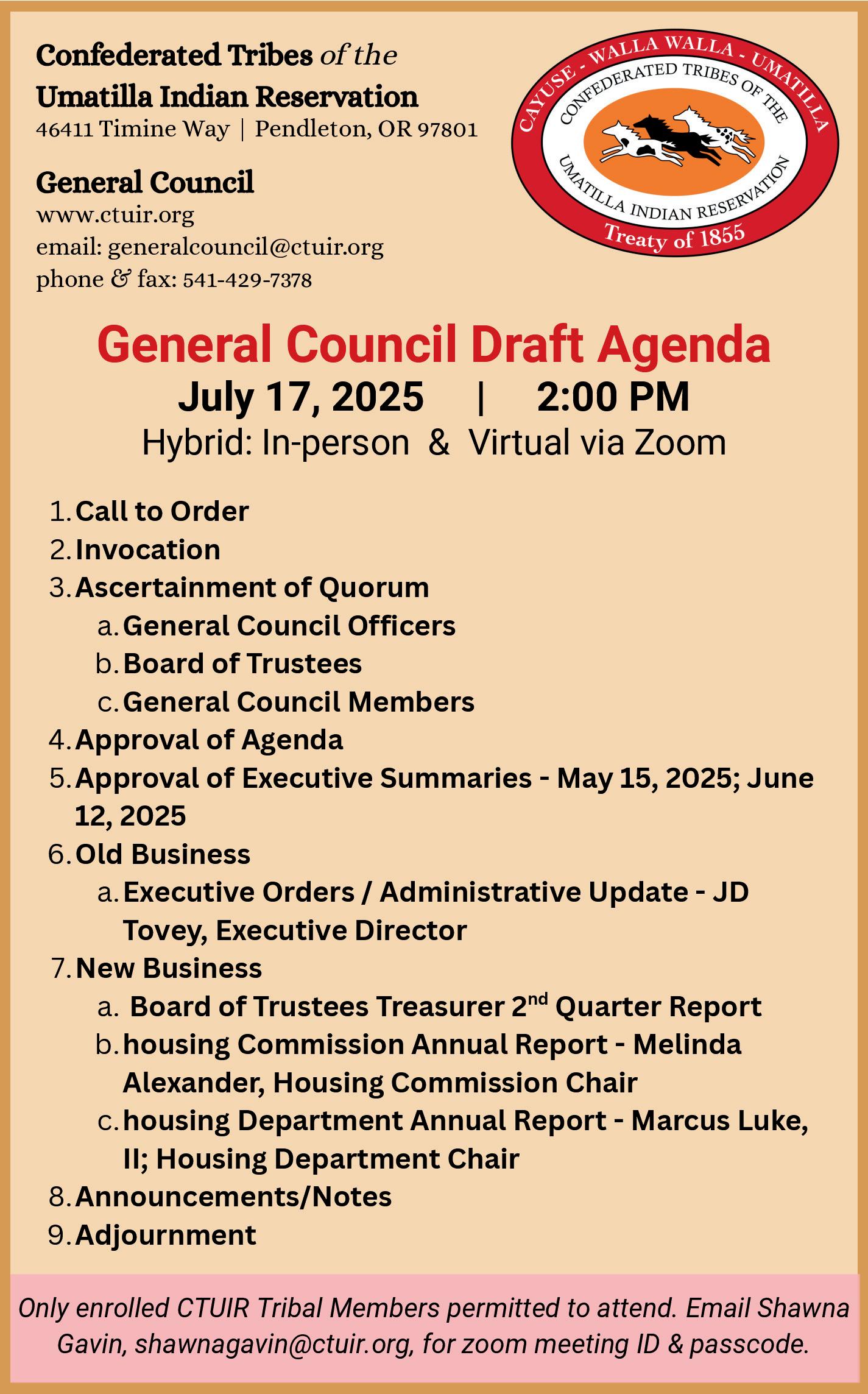
A crane lowers the Nixyáawii Community Financial Services (NCFS) sign at the NCFS office in Mission, Oregon. The NCFS Board of Directors is seeking applicants to fill a board seat. NIXYAAWII COMMUNITY FINANCIAL SERVICES
Oversized loads traveling through Eastern Oregon this summer
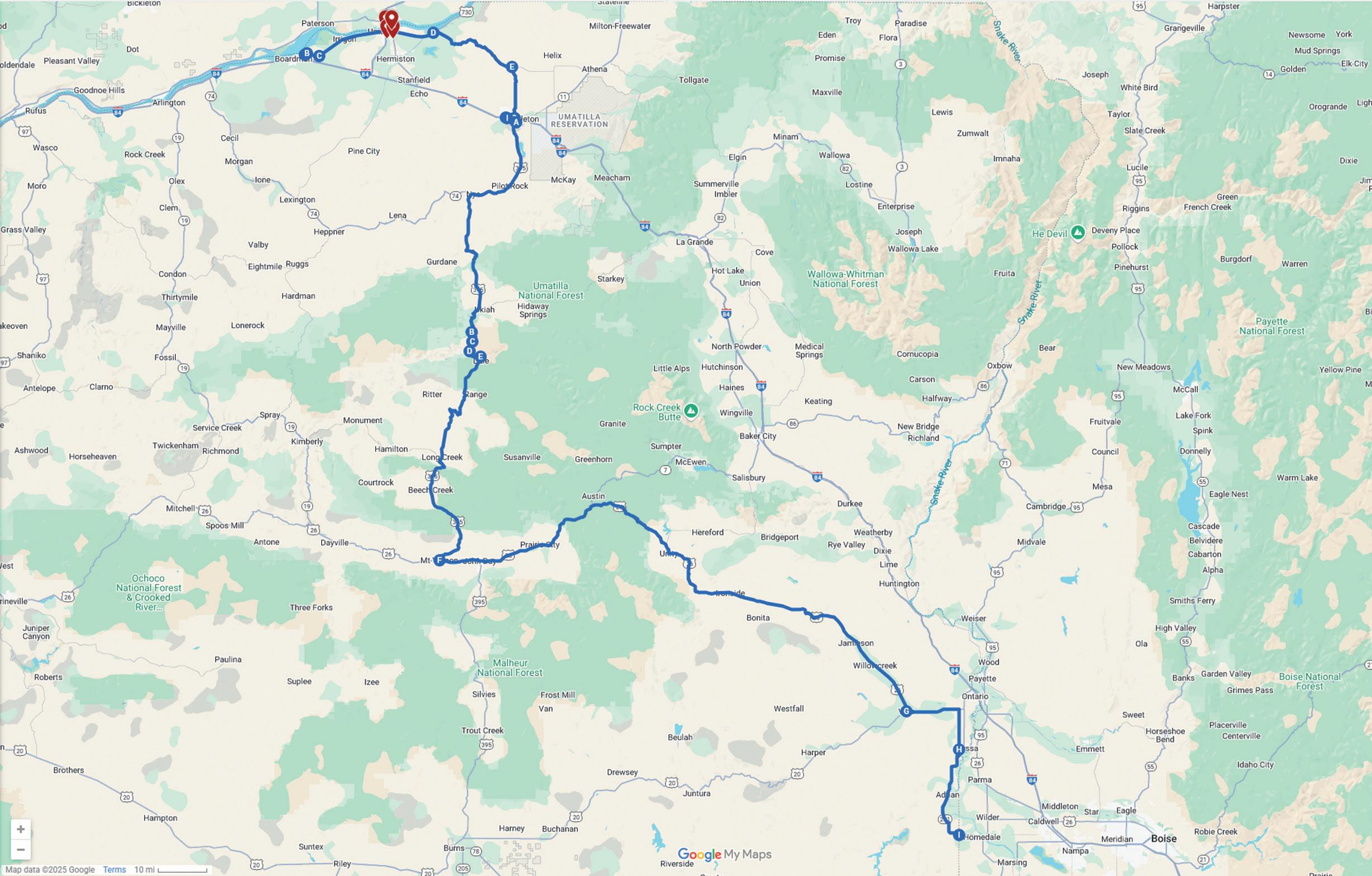
JOHN DAY – Motorists should expect delays on various highways and local roads between the Port of Morrow and the Idaho border through the summer.
A series of 31 oversized loads, or “superloads,” is scheduled for transport. Schedules for the remaining loads are flexible and subject to change.
The freight contains no hazardous materials, fuels or liquids. The shipments are expected to travel 10-30 mph along segments of U.S. 730, OR 37, Interstate 84 in Pendleton, U.S. 395, U.S. 26, and OR 201. Each will exit Oregon into Idaho via OR 201 south of Adrian.
Oversized loads will travel from the Port of Morrow through Pilot Rock during nighttime hours and continue from Pilot Rock to the Idaho border during daytime and nighttime hours. The loads will be parked off the roadway when not traveling. The size of each shipment will require the use of both travel lanes on two-lane highways, resulting in delays. Traffic will be stopped at regular intervals with pilot cars guiding the loads. They pull over at designated sites to let waiting vehicles pass.
To prepare for these loads, contractors were in John Day on June 20 to raise the traffic signals. Beginning at 7 a.m. the signals were turned off and flaggers directed traffic. Raising the signals allowed loads to pass through John Day without the need
to stop and adjust the signals for each trip. The signals will be lowered at the end of summer when transports are complete.
Motorists are encouraged to be aware when they see a pilot vehicle escorting an oversize and/or overweight load.
Superloads require special permits and traffic plans to help ensure the safety of everyone along the route. A superload is a category of oversized loads and in Oregon, the term superload is designated for oversized loads which exceed one or more of the following:
Over 16 feet wide on the Interstate.
Over 14 feet wide on any state two-lane highway. This does not include mobiles with a 14-foot box or less and up to a 12-inch eave.
Over 17 feet high on any highway.
Mobile with a box width over 14 feet wide and/or overall width greater than 15 feet.
Overall length greater than 150 feet.
For more information, call 503-647-7474.
Rainwater gets new name; more changes coming
Continued from page 5

The area allows tribal members to gather berries, mushrooms and other traditional plants, as well as fish and hunt for elk and deer. Moose are even beginning to push into the area, Middel said. All management efforts, previous or planned, are guided by the CTUIR’s First Foods policy and Upland Vision. They are designed to protect and
nurture self-sustaining ecosystems, mitigate damage to the land from previous degradation to the land from activities such as cattle overgrazing. The goal is to increase tribal member access to First Foods, according to information DNR officials provided to tour attendees.
Since the tribe established the property as Rainwater Wildlife Area,
the non-tribal member public and CTUIR members have had equal access to Tátwin and its hunting, fishing, gathering and recreational opportunities under an agreement with the U.S. government and Washington State.
But with Tátwin changing to trust status and the access agreement with the Washington Department of Fish & Wildlife expiring at the end of the year, the tribe wants to revise access rules to favor CTUIR members.
The public will still have the same level of access for recreational activities such as hiking, bird watching and dispersed camping, Tátwin managers said of the proposed change during the May 29 tour.
The privilege of hunting and gathering at Tátwin, however, will be reserved for CTUIR members
“There’s a limited number of resources up here and the tribe wants dibs on them, as they should,” Middel said. “It’s their land.”
Wildbill said the CTUIR is waiting for written approval of the change from BPA, though he and Middel said the
BPA has informally indicated that it would approve the proposal because it would still provide reasonable public access to the land.
Middel said he hopes to have a formal go-ahead by the end of the year.
The change will likely generate some criticism and concern – similar to concerns raised by area residents when the tribe began buying the land that would become the Tátwin Wildlife Area – from local citizens about losing access to the land.
Middel, who spends much of the year living at an office on the property, said he and the tribe have worked to ease concerns about access and the impacts of habitat and watershed restoration projects through communication, outreach and being a presence in the community.
So before the change takes effect, he said the CTUIR will host multiple public information meetings and take public comments on the proposal. Meeting dates haven’t been scheduled, though Middel said those could occur as soon as the fall.
Bears walk a road at the Tátwin Wildlife Area, formerly known as the Rainwater Wildlife Area, near Dayton, Washington. DEPARTMENT OF NATURAL RESOURCES
BE PREPARED FOR A WILDFIRE
May 2018
FEMA V-1013/
May 2018
A wildfire is an unplanned fire that burns in a natural area such as a forest, grassland, or prairie.
a forest, grassland, or prairie.
Often caused by humans or lightning
Often caused by humans or lightning. Can cause flooding or create problems with transportation, gas, power, and communications.
Can cause flooding or create problems with transportation, gas, power, and communications.

Can damage your property. Set up defense zones to protect your home.
Can damage your property. Set up defense zones to protect your home.
ARE UNDER A WILDFIRE
Can happen anywhere, anytime. Risk increases with little rain and high winds.
Can happen anywhere, anytime. Risk increases with little rain and high winds.
IF YOU ARE UNDER A WILDFIRE WARNING, GET TO SAFETY RIGHT AWAY
IF YOU ARE UNDER A WILDFIRE WARNING, GET TO SAFETY RIGHT AWAY
Leave if told to do so.
Leave if told to do so.
If trapped, call 911.
If trapped, call 911.
Listen for emergency information and alerts.
Listen for emergency information and alerts.
Use an N95 mask to keep particles out of the air you breathe.
Use an N95 mask to keep particles out of the air you breathe.










CTUIR offers new book about climate change effects on First Foods
The Confederated Tribes of Umatilla’s First Foods Policy Program opens up discussion on food sustainability with the release of the “Gatherers Project.”
ADRIANNA ADAME
Underscore Native News
MISSION – The “Gatherers Project” is a book that showcases the women gatherers of the Confederated Tribes of the Umatilla Indian Reservation’s (CTUIR) First Foods Policy Program (FFPP) and highlights management practices, advocacy and projects focused on First Foods and their access. One of the goals of the book is to create discussion about global warming and how it affects Indigenous communities.
Althea Wolf, a CTUIR citizen and FFPP program manager, recalls as a child gathering with the women from her tribe when she was in second grade. Her grandmother, Marie “Butch” Dick, was one of her mentors. From her elders, like Dick, she learned about the sacredness of gathering.
“We go out as women,” Wolf said, “and there’s nobody else with us.”
Dick is the first elder featured in the “Gatherers Project,” book, alongside 22 gatherers who are featured in the 70-page book, in order from eldest to youngest. Altogether around 50 people were involved in creating this book.
According to ctuir.org, the mission of FFPP is “to provide proactive
planning and policy analysis and development to protect, restore and enhance the First Foods and the exercise of associated rights reserved in the Treaty of 1855.”
FFPP officially released the “Gatherers Project” book during an event at the Nixyáawii Governance Center on June 10.
“Gatherers Project” leads readers through the seasonal traditional foods cycle, including the celery feast, the root feast and the huckleberry feast. The root feast is described by Wolf as the largest of the feasts, while the celery feast is an intimate gathering celebrated in early spring, being the first feast of the season.
“The book talks about how these women have made a lifelong commitment to gathering for not only a feast,” Wolf said, “but for different ceremonies, like namings and memorials and burials.”
FFPP’s adaptation planner, Colleen Sanders, said it took around five years to cultivate the information for the book. The idea of the “Gatherers Project” began during the Covid-19 pandemic in 2020. Sanders had written up two grant proposals that were approved. One of the proposals, received by the CTUIR in 2019, was called “Preparing
for Fire Project,” which focused on the effects of air quality, specifically from wildfire smoke.
“A lot of times, our gatherers, our fishermen and our hunters, are out in inclement conditions, because that’s when the foods are ready,” said Sanders.
“The ‘Preparing for Fire’ project was to make sure that our tribal harvesters were equipped with the skills, knowledge and equipment necessary to make good decisions for themselves, their families and their safety, while still maintaining connection with First Foods.”
The other grant proposal was a Climate Adaption Plan (CAP), called “Closing the CAP,” awarded in 2021.
The Meyer Memorial Trust funded both grants. Since the pandemic paused the original purpose of the grants, she and Wolf pivoted and combined the two to create the “Gatherers Project” book.
While working at the FFPP, Wolf and Sanders began learning more about the history of First Foods, foods which were eaten prior to colonization. They saw a growing interest amongst tribal citizens and worked with the community to make this information more accessible to everyone.
“Our gatherers get maybe a little
bit less attention, but they put a tremendous amount of work into making the ceremonies happen and bringing our women’s foods, the roots and the berries, back to be celebrated each year when they return,” Sanders said.
During the CTUIR Treaty Day celebration on June 13, the FFPP brought copies of the book to handout to attendees. There, Sanders talked more about the book with individuals and a neighboring table discussed the order and history about the CTUIR’s First Foods. The order begins from water, to fish, big game, roots and berries. Women’s foods consist of roots and berries. Men’s foods are water, fish and big game.
Gathering also comes with some danger. In some of their interviews, the gatherers featured in the book talk about how sometimes they’ve been targeted by passersby and even bears while celery harvesting. “Some of them joke that the violence they encounter out there is with cows,” Wolf said. Sanders said that people can learn from gatherers. They can note what condition the plants are in. Additionally, many of the young gatherers featured in the book are in
The “Gatherers Project” book was featured on a float during the CTUIR Treaty Day celebration on June 13. From left to right are gatherers Jennifer Mesteth, Michelle Thompson and FFPP adaption planner Colleen Sanders. ADRIANNA ADAME/UNDERSCORE NATIVE NEWS
CTUIR offers new book about climate change effects on First Foods
Continued from page 1

school for environmental studies and
colleges that have Memorandums of
Confederated Tribes of the Umatilla Indian Reservation (CTUIR) members Pat Hall Walters and Alvina Huesties sign copies of the First Foods Policy Program’s “Gatherers Project,” a book acknowledging the women who harvest First Foods. CTUIR
other areas of the sciences.
“Our gatherers are our best scientists,” she said. “They are the experts in what they’re seeing, because they’re out there year after year in all kinds of conditions.”
The heart of this book roots in “documenting tribal gatherers past, present and future,” said Sanders.
“That future component is,” said Sanders, “how are we addressing climate change impacts to first foods?”
Wolf and Sanders hope to make an updated version of the book in five years, including more gatherers and voices.
For now, more than 500 copies of the book are available for free to schools,

Understanding with the CTUIR and the public.
“We’re getting it out to our community to make sure that they can see where all of the work is happening,” Sanders said. The book is publicly available to everyone as a pdf on the CTUIR’s “Preparing for Fire Project” at https://ctuir.org/ departments/natural-resources/ climate-adaptation/gatherers-project/ and copies can be requested through FFPP directly.
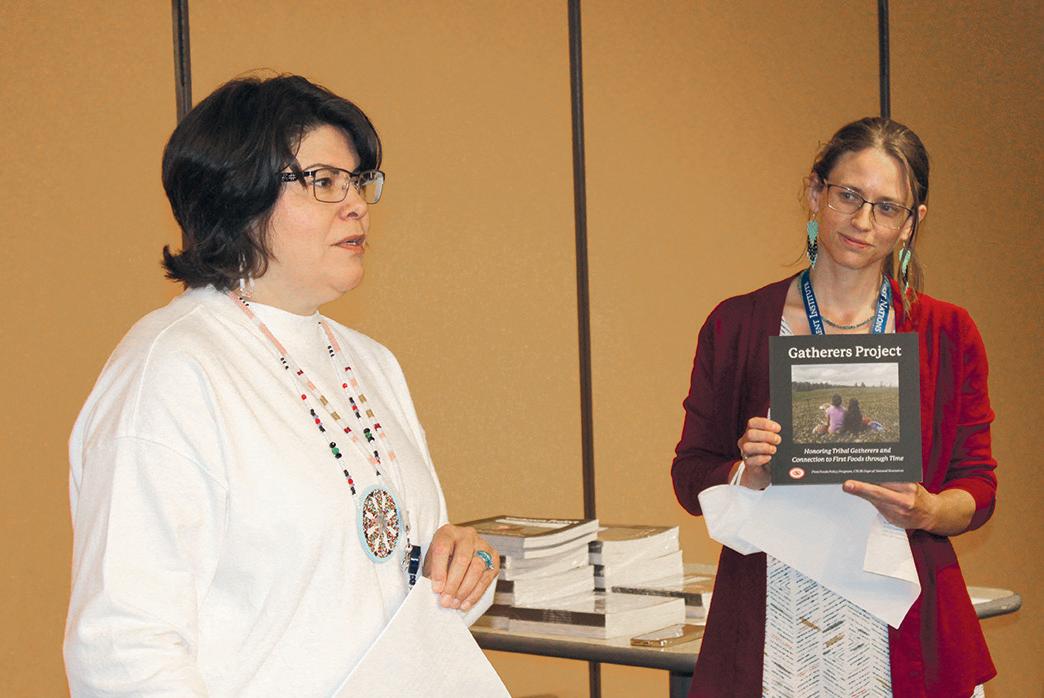
Althea Wolf, Confederated Tribes of the Umatilla Indian Reservation (CTUIR) First Foods Policy Program (FFFP) manager, speaks while CTUIR Climate Adaption Planner Colleen Sanders holds the “Gatherers Project” book during a book release event in June at the CTUIR Nixyáawii Governance Center in Mission. CTUIR
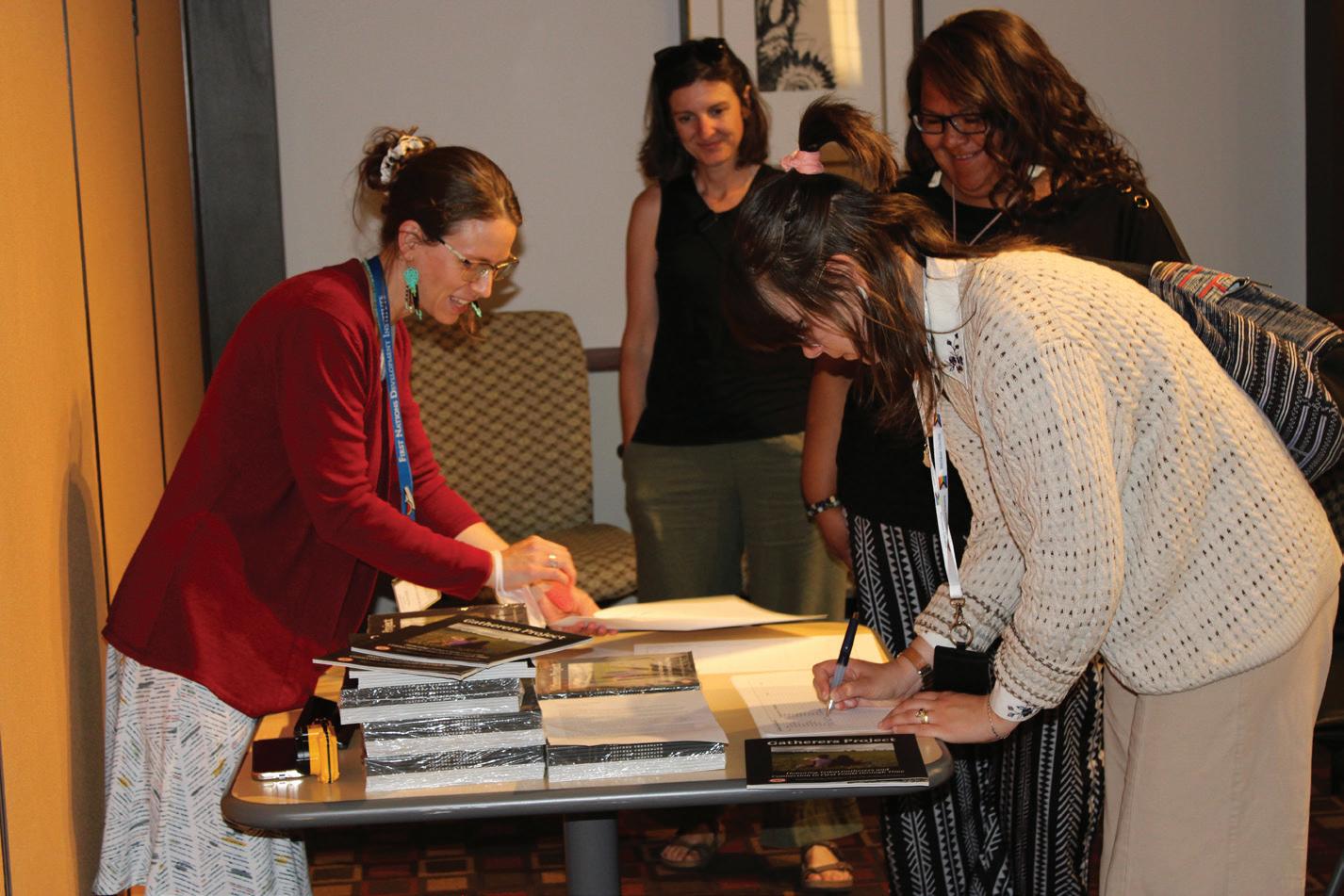
CTUIR Office of Air Quality Summer Air News Update
Open Burning is Prohibited

The CTUIR Office of Air Quality recommends regularly changing HVAC and furnace filters. During smoke events, check if MERV 13-rated filters can be used. If they are not suitable, consider using a HEPA filtration system or a box fan equipped with a MERV 13 or higher filter.
A message from the Tribal Fire Dept: "Please ensure that your home has a defensible perimeter during fire season"
For Agricultural or Forestry Permit Holders, please call the Office of Air Quality at 541429-7080 to discuss & plan Fall 2025 burning schedules or update your 2025 permits.
For Local and/or National Air Quality status, visit: AirNow.gov
Cultural & Ceremonial burning
For Ceremonial Burning, please contact Public Safety @ 541-278-0550 to inform them of and obtain a verbal permit to complete any religious or subsistence burning.
Former CRITFC commissioner James Marsh passes at age 81
JILL-MARIE GAVIN CRITFC
James Ryan Marsh was a proud Cayuse man who never forgot his heritage. This pride in his lineage was reflected by his deep sense of responsibility he carried as both a Umatilla Commissioner and Fish and Wildlife Commissioner of 15 years.
Through his bloodline, he felt a deep responsibility to advocate for his people. All the animal people, both four-legged and those of the water, as well as for the land that he cherished. Jim approached his responsibilities and position on the Columbia River Inter-Tribal Fish Commission (CRITFC) with determination and deep reverence.
“Jim and I both joined CRITFC in 2010,” recalls CRITFC executive director Aja DeCoteau (Yakama).
“From the very beginning, his dedication to the work and to the people we serve was unmistakable.”
His commitment to service followed in the footsteps of his mother, Atway Rosemary Narcisse, who had served on the Board of Trustees for the Confederated Tribes of the Umatilla Indian Reservation (CTUIR), the Fish and Wildlife Commission, and as a CRITFC Commissioner.
“Jim’s passion was unwavering. He was a dedicated Fish and Wildlife Commissioner and CRITFC Commissioner, only missing one or two meetings out of all his delegations during all his illness,” recalled Corinne
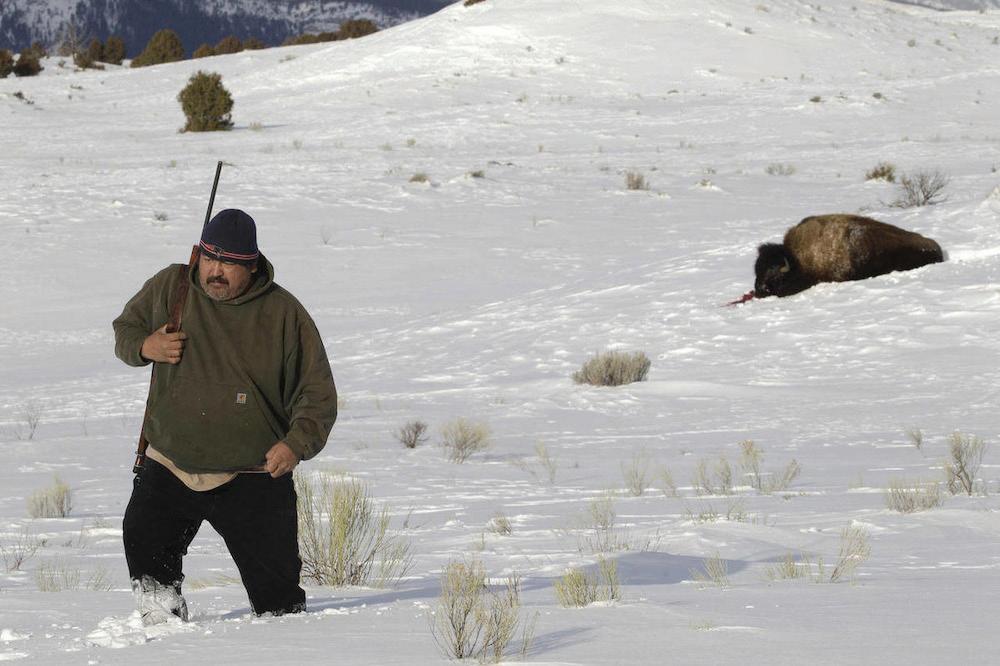
Sams, CTUIR Board of Trustees member and former CRITFC Chair.
“He could name every creek, tributary, river, hilltop, and road in our Usual and Accustomed areas.”
His time on the Nchi’ Wána [“big river,” the Sahaptin name for the Columbia River, pronounced “IN‘chee wana”] began in his earliest days. Jim
Congratulations!
The Confederated Tribes of the Umatilla Indian Reservation (CTUIR) recently received a rebate check for completing energy efficiency improvements to existing irrigation systems.
Umatilla Electric Cooperative is proud to invest in our membership and in meaningful projects to improve energy consumption in our region.
started fishing from the Columbia River scaffolds in the 1970s as a small child of just ten years old. He canned, filleted and prepped his own fish from that time on. He lived the life he wanted others to have.
As part of his duties as a commissioner and provider for his tribe, Jim was a passionate and vocal
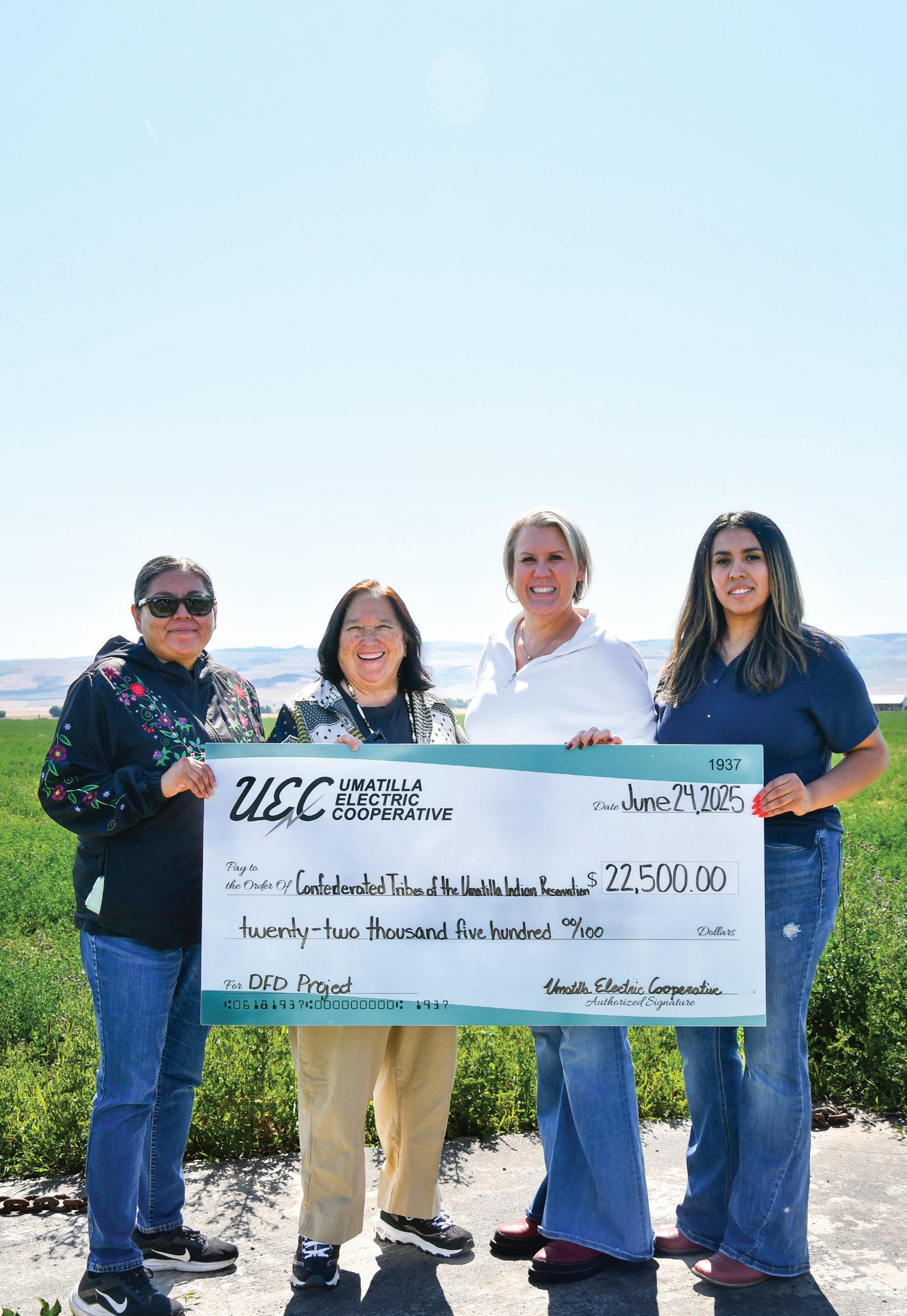


advocate for the Pacific lamprey. He served on the CRITFC Lamprey Committee and drew wisdom from tribal elders, often citing Atway Elmer Crow, Jr. (Nez Perce) as a trusted leader in lamprey stewardship. “The eels are struggling, they are struggling
Continued on page 6
Jim Marsh (Cayuse) walks away from a bison that he shot and killed in 2011, near Gardiner, Mont. at the first CTUIR bison hunt in more than 100 years. TED S. WARREN/ASSOCIATED PRESS
TAKE THE ELECTION COMMISSION’S ONLINE SURVEY AT CTUIR.ORG


The Election Commission is considering recommending changes to provisions in the CTUIR Constitution and Election Code.
These include the authority for one person to serve as the chair of the Board of Trustees and chair of the General Council at the same time, and a proposal to stagger the terms of Board of Trustees and General Council officers so that all elected officials are not on the ballot and to see if there is interest in a primary election.
Between mid-May and June, the Commission will be seeking CTUIR members’ responses to four survey questions that will guide what recommendations it makes on future CTUIR elections. Your opinion is important.
The survey questions are available at https://bit.ly/3FfT9Ai through July 31. For any questions, email the electioncommission@ ctuir.org.

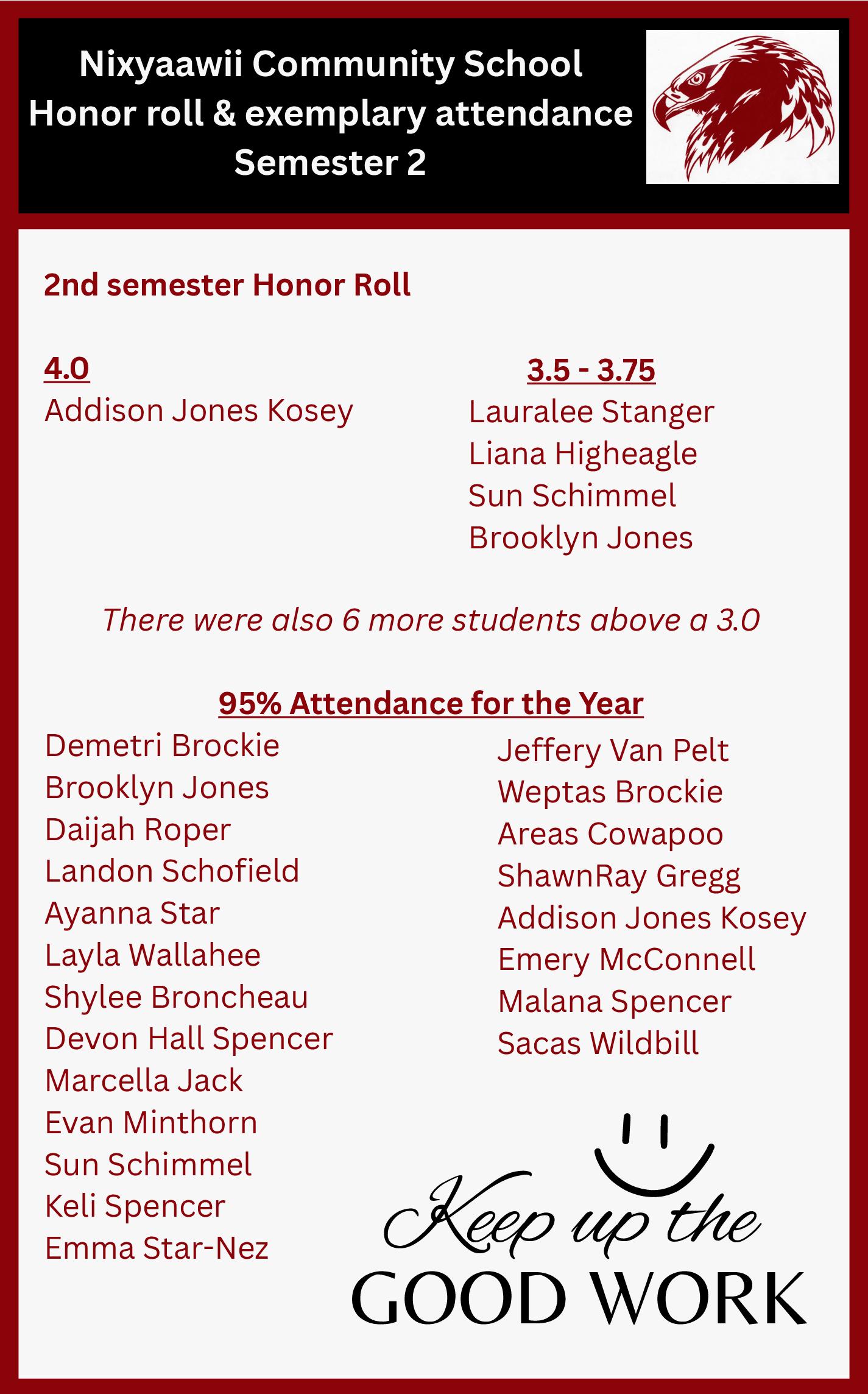
SCAN THE QR CODE TO TAKE THE SURVEY
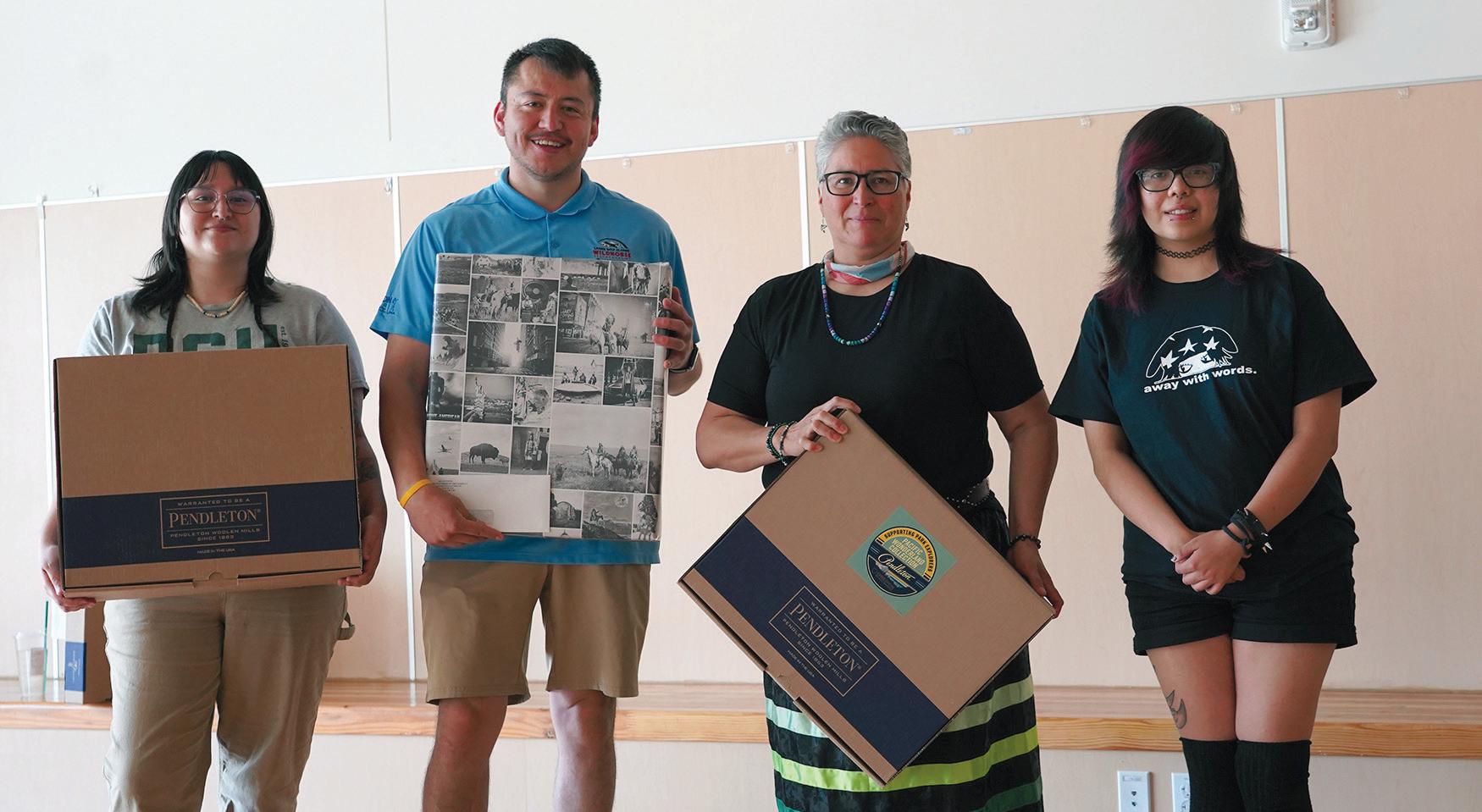
Education Department recognizes 2025 graduates with celebration
CHRIS AADLAND
CUJ
MISSION – Confederated Tribes of the Umatilla Indian Reservation (CTUIR) members who recently graduated were recognized in a ceremony at Nixyáawii Community School (NCS) on June 23.
Those honored ranged from high school graduates from area schools, such as Pendleton High School and NCS, to tribal members who had received bachelor’s or master’s degrees.
Of the dozens of CTUIR members who were recognized for graduating, four attended the ceremony and received gifts of Pendleton blankets.
“You are the future image of our
snacks, refreshments and keynote speech from Department of Natural Resources Director Eric Quaempts.
“This is a very important milestone for you moving forward and a transition point,” Quaempts said.
“I always think transition points are interesting because they are a time of change, they’re a time of uncertainty, but also a time of potential and possibility, and your achievements give you a whole new range of potentials and possibilities.”
He said the tribe’s modern-day success and new facilities – such as the building that houses NCS and the Education Department – is due to the hard work of past leaders who believed,

tribe,” said CTUIR Education Director Jaimie Crane, while also thanking families, teachers and mentors who helped the students while they worked to meet their graduation requirements. “Don’t be afraid to take up space. Don’t be afraid to use your voice.”
The annual event was hosted by the CTUIR Education Department and included an opening prayer and song,
and an educated tribal membership was one of the cornerstones for the tribe to build on that work.
With an education and solid cultural foundation, Quaempts said the graduates are positioned to help lead the tribe into the future.
“You can help yourself find purpose and help us articulate the needs of the community and address the problems
that the community has to make the community stronger as a whole and project our sovereign interests overall,” he said.
Those earning a higher education degree consisted of:
• Aaron Luke, bachelor’s degree from Oregon Institute of Technology,
• Adrienne J. Farrow, master’s degree from Colorado State University Global,
• Ambrosia Little Feather Snapp, associate degree from Blue Mountain Community College (BMCC),
• Anna Jane Harris, professional degree from Oregon Health and Sciences University,
• Ashlyn Paige Wallace, bachelor’s degree from University of Idaho,
• Candice Patrick, associate degree from BMCC,
• Cloe McMichael, bachelor’s degree from Oregon State University (OSU),
• Erick Sheoships, associate degree from Embry-Riddle Aeronautical University,
• Evelyn Galloway, master’s degree from Fort Lewis College,
• Ira Ashley, bachelor’s degree from OSU,
• Jayd Eke, bachelor’s degree from Salish Kootenai College,
• Kiana Watchman, master’s degree from University of Arizona (Arizona),
• Krystol Shaunte McKay Wade, associate degree from Atlanta Technical College,
• Maurice V. Bronson, certificate program from Northwest Indian College (NIC),
• Quincy George, master’s degree from Eastern Oregon University,
• Savannah R. Sammaripa, associate degree from NIC,
• Trinity Treloar, bachelor’s degree from Portland State University, and
• Jisselle Halfmoon, certificate program from Arizona.
Those recognized for earning high school diplomas from NCS were Ellis Ashley, Weptas Brockie, Rylen Bronson, Bryant Clemente Paz, Evan Corley, Areas Cowapoo, Tecoa Enick, Anthony Greene, ShawnRay Gregg, Addison Jones Kosey, Brianah Matamoros, Emery McConnel, Myalyn Mills, Breyon Minthorn, Symond Picard, Noah Pierson, Marcellus Scott, Malana Spencer, Lauralee Stanger, Jayden Van Pelt, Landon Van Pelt, Cody Wahl, Lillian Watchman and Sacas Wildbill.
Those recognized for earning high school diplomas from Pendleton High School were Tyce Cecil, Halona Demary Lewis, Miranda Dixson, Dennis Enick, Faye French, Annie Glover, Madison Grigsby, Oscar Huesties, Tru Hunter, Kamryn Kauffman, Dakota McLaughlin, Ariana Nez, Alyssa Oertwich, Richard Oertwich, Hailey Loiland, Pico Rodriguez, Ella Sams-Keosky, Toese Taula, Casyn Wahl Gibbs and Allan Wilson.
Those recognized for earning high school diplomas from Pilot Rock High School were Kenzie Hoeft and Blake Teeman. Honored from La Grande High School were Faith Middleton, Kanai Huff, Sierra Cartee, Sahara Cartee and Ava Beaudry Roe. Honored Hermiston High School graduates were Hayden Thompson and Kean Mathias.
Alyric Paige Redcrane was honored for graduating from Penn Foster High School, while Cole Soaring Eagle was honored for graduating from White Swan High School.
Trinity Treloar, who earned a bachelor’s degree from Portland State University, is recognized on June 23 at Nixyáawii Community School for recently completing her degree from a higher education institution. CHRIS AADLAND/CUJ
Trinity Treloar (Portland State University), Quincy George (Eastern Oregon University), Evelyn Galloway (Fort Lewis College) and Pico Rodriguez (Pendleton High School) line up for a photo on June 23 at Nixyáawii Community School during a ceremony to celebrate Confederated Tribes of the Umatilla Indian Reservation (CTUIR) members who recently graduated high school or a higher education institution. CHRIS AADLAND/CUJ
Former CRITFC commissioner James Marsh passes
Continued from page 3
to get upriver, the dams are slowing their passage, there is less snowpack, but with our tribes translocation
Committee meeting. “We need to continue to advocate for the tribes and for eel.”
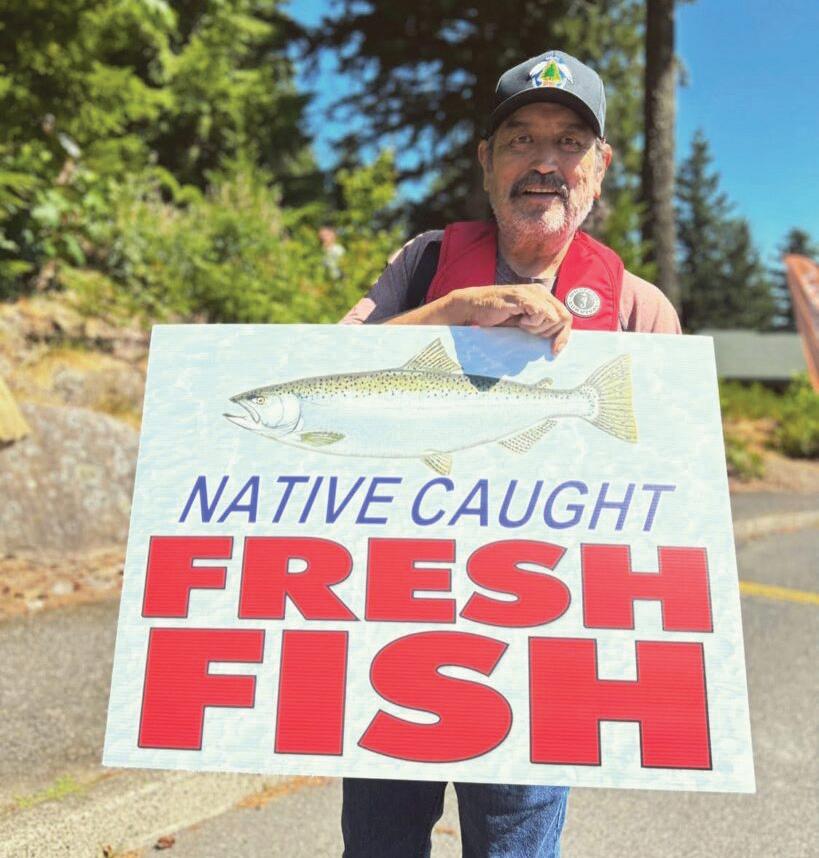
efforts we are starting to get a foothold to get eels back into our systems, and it is working,” Jim remarked at the November 2024 CRITFC Lamprey
Jim’s dedication to this ancient being began long before the recent surge in scientific research, population recovery efforts, Umatilla River

ceremonial harvests, and public education about this eel-like fish that is one of the First Foods of Columbia River Plateau peoples. His unwavering commitment to all fish was inclusive and steadfast, honoring the Pacific lamprey as sacred.
In 2011, Jim Marsh made history as part of the first buffalo hunt by Oregon tribal members in over a century. For years, he had heard stories about his great-grandmother’s buffalo-hide teepee, the last of its kind in their family. His great-grandfather was the last family member to travel across the Rocky Mountains to hunt bison before the federal government restricted travel from their reservation and the decimated herds were confined to Yellowstone National Park.
Jim wouldn’t let that tradition die. He pushed the CTUIR wildlife program to seek access to hunt buffalo, prodding officials when paperwork lay dormant. He applied for and was appointed to the Fish and Wildlife Commission in 2010, specifically to pursue this goal. “Our tribe has been hunting buffalo for centuries. It’s one of our traditional foods,” he said in a 2011 article covering the hunt.
Sharing that tribal chiefs cited buffalo more than a dozen times in their 1855 treaty. “It was important to me to try to return that tradition to my people.”
After months of negotiations, permission to hunt in Yellowstone was granted. Jim passed the first shot to his
then 23-year-old son Francis. “For me and my son to come up here as Cayuse, like our ancestors, it’s a great honor,” he shared with the news outlet.
The next morning, Jim himself took down a second bison, completing a hunt that restored a tradition lost for over a century. True to his values, the meat was shared with family members and elders who could no longer hunt, as well as provided for ceremonial observances in the longhouse.
Jim understood that the health of his people was directly linked to the land and to the “Big River.” He long maintained that pollution of the Columbia River directly impacted the health of his people. When new pollution rules were implemented to protect fish consumption, Jim spoke about the connection between clean water and tribal survival.
“Jim monitored toxins in our waters and foods,” Sams said. “We never had a meeting without him mentioning PCBs and other toxics that impact our fish and wildlife.”
Jim never stopped advocating for the river, land, and the animals that depend on them. He spent part of his final day attending online meetings as a CRITFC commissioner from his hospital room at Oregon Health and Science University in Portland. This dedication to protecting the land, water, and Treaty rights was fundamental to who he was.
“Jim approached his role as commissioner with unwavering

Jim Marsh at Skamania Lodge on the Columbia River supporting tribal fishers and the Zone 6 fishery. Above, Marsh holds a sign advertising the 2023 Tribal Fisher Expo held at the resort in July. JILL-MARIE GAVIN/CRITFC
commitment, always showing up, always advocating with heart and clarity. Beyond that, Jim brought a warmth and humor that made even the hardest days lighter. He was not only a trusted colleague but a true friend. I will miss him deeply,” said DeCoteau.
Home is where his heart lived, and the ancestral lands of his people were his home. He spent much of his life amongst those animals and in the hills of his homelands. Hunting, fishing and teaching.
“My relatives dry fish, can fish, smoke fish and eat fresh fish all year long,” he said to the Confederated Umatilla Journal reflecting on fishing traditions passed down through generations. “Now I’m teaching my son how to fish and it’s good to know that when he gets to be my age the fish will be safe to eat. And it’s not just about Indigenous natives, it’s for everybody, for the health of everybody.”
Jim’s family exemplified this commitment to traditional foods. “My family eats fish at least three times a week and when me and my boys sit down to eat we eat a whole fish,” he shared. “I can it, smoke it and freeze it. My winter supply is sockeye and I catch springers for summer and fall.”
His dedication to fish consumption studies came naturally, having been raised by a mother who participated in the fish consumption research conducted by CRITFC in the 1990s. This work was crucial in establishing the scientific foundation for protecting tribal fishing rights and ensuring the safety of traditional foods. His advocacy for clean water and healthy fish was part of his larger
vision. He knew that environmental protection and cultural preservation were inseparable. Addiction, poverty and generational trauma were always at the forefront of his concerns for Tribal members on the Big River and at home. He spoke loudly and often of the perils of fentanyl and what it is doing to Indian Country. Jim did not shy away from difficult subjects but instead faced them with the steady voice of a man who had seen the best and worst of what life could offer his people.
When asked about the implementation of new pollution rules, he didn’t mince words: “The ultimate goal is to reduce toxics that go into the water, fish and people. Do the words just exist on paper or are they applied and put into practice?”
James Ryan Marsh lived his principles. He was a hunter who shared his harvest, a fisher who fought for cleaner waters, a commissioner who fought for his people, and a father who protected his legacy of culture. His voice will echo in the chambers long after his time and will be reflected in policies he helped shape that will live long into the future. The traditions he helped restore, and the clean water that future generations will inherit will be a result of his covenant of his people, to take care of the land and all the animal people. That legacy will be because of his unwavering commitment to his people and their homelands.


How nutritional needs change for elders
MISSION – As we grow older, our bodies experience shifts that influence key functions such as metabolism, muscle strength, digestion and how efficiently we absorb nutrients.
These physiological changes alter our dietary requirements. For elders, maintaining a balanced and nutritious diet plays a vital role in supporting energy levels, cognitive health, bone strength, immune function and general well-being.
The Changing Body
Aging naturally brings physical changes. Muscle mass begins to decline, metabolism slows down and appetite may decrease. Many older adults also experience shifts in their sense of taste or smell, which can affect how much or what they want to eat. Others may be dealing with chronic conditions such as diabetes, heart disease, or high blood pressure that require specific dietary choices.
These changes make it important to consume foods that are nutrient-dense, meaning they provide a high level of vitamins and minerals without excess calories. Maintaining a healthy weight, supporting strong bones and keeping energy levels steady all require thoughtful nutrition.
Nutrients That Matter Most
As nutritional needs shift, some nutrients become especially important:
Protein: Muscle loss is common with age, so high-quality protein is needed to maintain strength and mobility. Traditional sources such as fish, venison, bison, beans and nuts are excellent options.
Calcium and Vitamin D: These nutrients are essential for bone health. Bone broth, leafy greens such as dandelion or nettles and sunlight exposure can help support healthy levels.
Fiber: Digestive issues are more common in older adults. Whole grains, beans, berries and wild plants provide
the fiber needed to keep the digestive system working well.
Iron: Fatigue is often linked to low iron levels. Red meats, dark leafy greens and iron-rich legumes can be especially helpful.
Water: Dehydration is a serious risk, especially for those who don’t feel thirsty as often. Herbal teas, broths and fresh fruits can help meet hydration needs.
Traditional Foods: A Path to Wellness
Many of the healthiest foods for our elders are the ones our ancestors ate. These traditional diets – high in lean proteins, wild plants, seasonal fruits and low in processed sugars – are naturally aligned with modern nutritional science.
Incorporating traditional foods into care isn’t just about nutrition, it’s about cultural connection, spiritual wellness and emotional comfort.
Preparing meals with respect for the land, using recipes passed down through generations and involving elders in foodrelated ceremonies or gardens can bring powerful healing and joy.
Addressing Common Challenges
In assisted living communities, several challenges can interfere with good nutrition:
Appetite Loss: Small, frequent meals that include familiar and flavorful ingredients can help.
Dental Issues: Soft foods like stews, soups and mashed vegetables can provide nutrients without discomfort.
Medication Interactions: Some prescriptions can affect appetite or nutrient absorption. It’s important to monitor and adjust diets accordingly.
Limited Access to Traditional Foods: Working with tribal programs, local farms, or community initiatives can help bring more traditional options.
To schedule learn more, visit McKayCreekAL.com or call 541-6128213.

Medicaid cuts could affect Oregon more than most states, analysts say

TEMPLETON OPB
President Donald Trump said in a social media post that he wants the ‘One Big Beautiful Bill’ on his desk by July 4.
If Republicans in the U.S. Senate pass the “One Big Beautiful Bill Act,” Oregonians currently enrolled in Medicaid are more likely than people in nearly any other state to lose coverage and end up uninsured, according to analyses from several national think tanks.
The budget reconciliation bill reduces federal spending using a number of policies that will cut enrollment in Medicaid, including a work requirement for some and more frequent eligibility checks for all. The work requirement would take effect in January 2027.
Republicans have said those policies will reduce waste, fraud and abuse in the program. Democrats counter that they would increase red tape, resulting in many eligible people losing their health insurance.
In a social media post this week, President Donald Trump said he wants the bill on his desk by July 4.
In Oregon, 20% of people currently enrolled in Medicaid could lose their coverage, according to a detailed estimate of the bill’s impact by the State Health and Value Strategies Program at Princeton University. That would be the most significant percent loss of any state, according to the think tank’s stateby-state analysis.
Oregon is particularly vulnerable because it has focused for decades on expanding its Medicaid program, simplifying eligibility checks and making it easier for people to enroll and stay enrolled.
“Congress wants to layer back on those administrative burdens,” Heather Howard, director of the State Health and Value Strategies Program at Princeton University, said. “They’re reversing what in Oregon is almost 20 years of progress.”
Republican Rep. Cliff Bentz, who represents Oregon’s second congressional district, serves on the U.S. House subcommittee responsible for the cuts to Medicaid and says he helped craft the bill. He did not respond to a request for comment about its local impacts.
In a telephone town hall last week, Bentz said the bill accomplishes many of his personal priorities, including increasing spending on border security and extending the Trump tax cuts. He called Medicaid a necessary program and said he’d objected to an effort by some of his fellow Republicans to further restrict its federal funding.
Impacts across the state
Democrats in the Oregon Legislature held an informational hearing Tuesday on the potential impact of the bill.
State Medicaid Director Emma Sandoe told state legislators that she would need to hire 800 to 1,200 additional eligibility workers to handle the more frequent reviews required by the bill.
Currently, adult Oregonians stay enrolled in Medicaid for two years at a time in between eligibility checks. Children are enrolled through their sixth birthday.
Under the reconciliation bill, eligibility renewals would be required for all Medicaid recipients every six months. State Sen. Deb Patterson (DSalem), who chairs the Oregon Senate’s health care committee, likened that change to requiring Oregonians to start filing their taxes twice a year instead of annually.
Eric Hunter, the CEO of Care Oregon, the state’s largest Medicaid insurer, told legislators that most of their members already work or are eligible for an exemption to the proposed work requirement, but would struggle to complete the paperwork on time to prove it.
“Our members will always be on the edge of losing coverage, due to minor temporary fluctuations in income,
legal status, like green card holders, and some without it.
The reconciliation bill would force Oregon to cut that coverage or face a reduction in the federal match rate it gets for other Medicaid members. That would amount to a loss of $1 billion in the 2027-2029 biennium, and billions more in future years, Sandoe said.
Most provisions in the reconciliation bill would not go into effect until after the midterm elections. One exception: a 10-year ban on all Medicaid funding for Planned Parenthood would take effect as soon as the bill is signed into law, potentially as early as next month.
Planned Parenthood Columbia Willamette’s CEO Dr. Sara Kennedy said 70% of their patients pay for visits with Medicaid.
“Health centers have a strong likelihood of closing across the state,” Kennedy said. “Abortion access will absolutely suffer.”
According to Kennedy, Planned Parenthood’s clinics across Oregon are also the single largest provider of many other types of primary care, including pap smears and STD testing.
“Our patients don’t have anywhere else to turn,” she said, noting that will likely result in patients not getting care.
administrative glitches or even moving to a different house and not getting the mail,” Hunter testified.
Historically, Oregon’s focus on stabilizing Medicaid and reducing the number of people who churn on and off coverage has helped it achieve among the lowest rates of uninsured people and medical debt in the country, according to Princeton’s Howard.
An analysis of the bill by the Kaiser
Kennedy, a doctor herself, said fewer pap smears will mean more patients with cases of cervical cancer are missed at the early, treatable stage. Patients diagnosed later face a painful cancer that can be fatal.
“This is truly life or death,” she said.
Kennedy said they believe the bill is likely to pass and asked legislators to consider an immediate allocation of funding to Planned Parenthood to

Family Foundation projected Oregon will see a 4% increase in the uninsured rate - making it one of 10 states that would see the biggest swing.
During the Tuesday hearing, hospital CEOs and medical clinic directors in Oregon said they too believe the bill will drive up the uninsured rate, shifting the cost of uncompensated care to providers.
Oregon is also in the crosshairs of a provision that penalizes states that provide Medicaid coverage to undocumented immigrants.
The state’s program, called Healthier Oregon, uses exclusively state dollars to provide coverage to 14,925 children and 88,903 adults, according to KFF. Those numbers include some immigrants with
avoid disruptions while they plan a response.
Oregon lawmakers are currently hammering out a new two-year spending plan, and slowing economic growth in the state is forcing them to scale back.
At the hearing’s end, Rep. Rob Nosse (D-Portland) said if the reconciliation bill becomes a reality, it would deal a “fundamental blow” to Oregon’s near 30-year effort to keep people insured while containing costs.
The Legislature, he said, would likely need a special session to respond to the cuts.
AMELIA
Activists with the Poor People’s Campaign protest against spending reductions across Medicaid, food stamps and federal aid in President Donald Trump’s spending and tax bill being worked on by Senate Republicans this week, outside the Supreme Court in Washington, Monday, June 2, 2025. J. SCOTT APPLEWHITE/ASSOCIATED PRESS
The front of the Planned Parenthood clinic in Bend, Oregon, on June 28, 2022. JONI LAND/OPB

SUMMER SALE!
30% OFF
This month only get 30% o all summer apparel and accessories. T-shirts, hats, beach towels, bags, and more are all marked down. Don’t miss out! O er may not be combined with other o ers/discounts.
PRIDE IN PATRIOTISM
A Fred L. Mitchell Collection of Patriotic Beadwork Designs
Opens Friday, August 1
OPENING DAY IS FREE!
LIVE RAPTORS
At Tamástslikt Cultural Institute
Saturday, July 19, noon-2pm FREE ADMISSION!
Meet raptors face to face! Lynn Tompkins from Blue Mountain Wildlife brings rescued raptors to our lobby and will be sharing information on the American Kestrel and other species. Admission is free.
FREE FIRST FRIDAY!
FREE admission all day at Tamástslikt Cultural Institute
July 4, 10am-5pm

A vast collection of beaded pieces demonstrate through beadwork the patriotism and loyalty tribal people feel for the United States. A nation whose early treatment of American Indians was spotty at best was nevertheless acknowledged as the government that would oversee the wellbeing of the nation and its inhabitants. The quality and creativity of the beaded pieces on exhibit will impress and provoke you. Thank you to St. Anthony Hospital for helping to bring this exquisite display to our exhibit gallery.
August 1, 10am-5pm
FREE admission every first Friday! Enjoy lunch at Kinship Cafe on the patio or order take-out. Dine on Indian Tacos ($10.50), Frybread ($5), and other goodies from 11am-2pm. Shop the Museum Store for big mark-downs on summer apparel and accesssories.
www.tamastslikt.org • 541.429.7700 • 47106 Wildhorse Blvd. Pendleton, OR 97801
Exhibits, Museum Store Open Tues-Sat, 10am-5pm • Kinship Cafe Open Tues-Sat 11am-2pm First Fridays are FREE!

Food truck park construction in Mission begins
BERIT THORSON
East Oregonian
MISSION – Construction is starting on the new food truck park from Nixyaawii Community Financial Services.
NCFS held a groundbreaking ceremony June 6 to celebrate taking the next step toward the park’s opening. Attendees included representatives from NCFS and its board, the Wenaha Group, a construction consultant business, and Bryson Picard Grading and Excavating, a local Native-owned business that won the bid to set up the park.
Jacob Wallis, business services manager for NCFS, said it’s exciting to be finishing phase one of the project – getting the park up and running –after working for a few years to make it happen.
He added that the park has many sponsors and he thinks that’s because “everybody sees how special this is” and wanted to be part of its success.
“I think it will be a beacon for a lot of our small businesses out here,” said Wallis. “So (I’m) really excited about that and also to be able to share their recipes and their gift to us.” What’s in a name? The park’s official name is Txtáyma Food Truck Park. Txtáyma (pronounced “tie-Eema”) means to exchange or barter in Umatilla. Wallis said the name “represents what (he wants) this small business ecosystem to be.”
Wallis’ hope for the park is that it will grow into its name, as phase two of
the project will be adding a commissary trailer for people in which people can make their goods and crafts.
Dave Tovey, NCFS executive director, said with a chuckle they settled on the name after some heated debate. He said it fits with goals to provide opportunities to small businesses.
Rather than always bringing in established companies, Tovey said, “We need to start growing our own.” Once they’re settled, he said, they may choose to expand into a brick-and-mortar spot with the necessary experience and preparation and customer base to make the endeavor a success.
For now, NCFS is taking applications of interest from people who want to open a truck or use the permanent, rentable NCFS truck on the lot. Wallis said there almost certainly will be fry bread sold at one of the trucks, and there may be coffee, pastries, hot dogs or tacos at some of the others.
He’s hoping people will continue reaching out to pitch their business plan to NCFS. If there aren’t enough applicants, it’s possible established food trucks from outside of the tribes will set up shop in the park temporarily.
Supporting small businesses NCFS board member Monica Paradise said she’s thrilled to see the vision come together.
“It’s exciting for all of the small businesses who will be able to be a part of each phase, especially our small businesses who are going to be able to provide food,” she said. “I think it’s really part of our cultural background,
Everyone Deserves a Place to Belong
At McKay Creek Assisted Living , we believe senior living is more than just a change of address—it’s about finding a true sense of home, surrounded by warmth, friendship, and genuine connection. Discover a place where you belong. Start the conversation today at McKayCreekAL.com or call 541-612-8213 to schedule your visit or speak with an advisor.

team
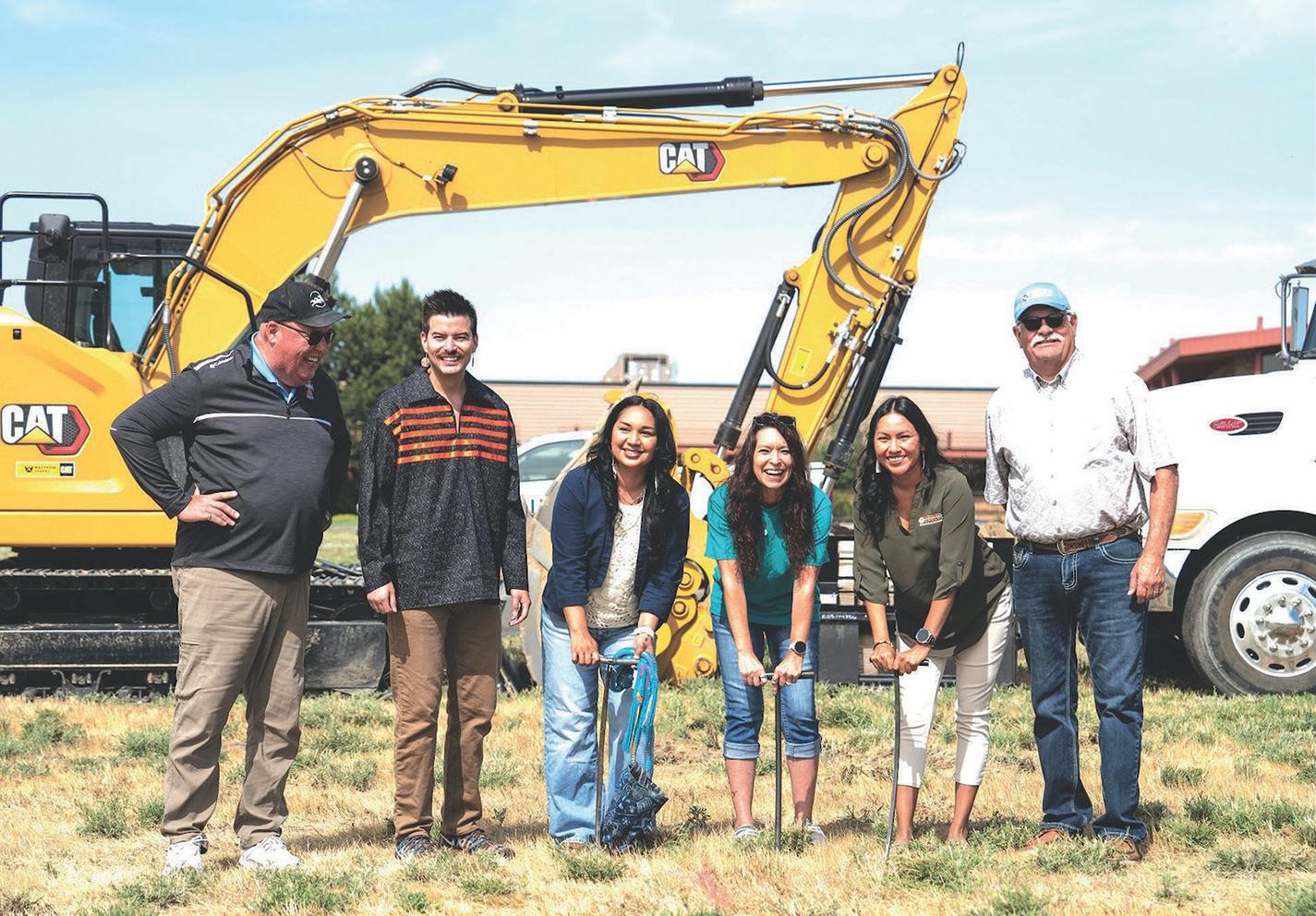
so that’s one thing that they’re able to bring forward is to provide food and use it in an economical way.”
One of the small businesses already benefiting from the park is Bryson Picard Grading and Excavating. The contracting business started in June 2020 and is co-owned by Bryson Picard and Dana Quaempts, enrolled members of the Confederated Tribes of the Umatilla Indian Reservation. The pair said they’re happy to be involved with a project like the food truck park.
“We’re a 100% Native-owned business, so it’s nice to work right here at home,” said Picard.
Quaempts added, “We’re excited for this. We want to be a permanent fixture out here. I’m looking forward
to the success of other tribal businesses that come out here as part of the food trucks.”
Construction is scheduled to finish July 11, with a soft opening of the park to follow shortly after. By the end of July, Wallis said he hopes to host a grand opening.
“We’re a 100% Native-owned business, so it’s nice to work right here at home,”

Nixyaawii Community Financial Services and partners break ground on June 6, 2025, on a new food truck park in Mission. BERIT THORSON/EAST OREGONIAN





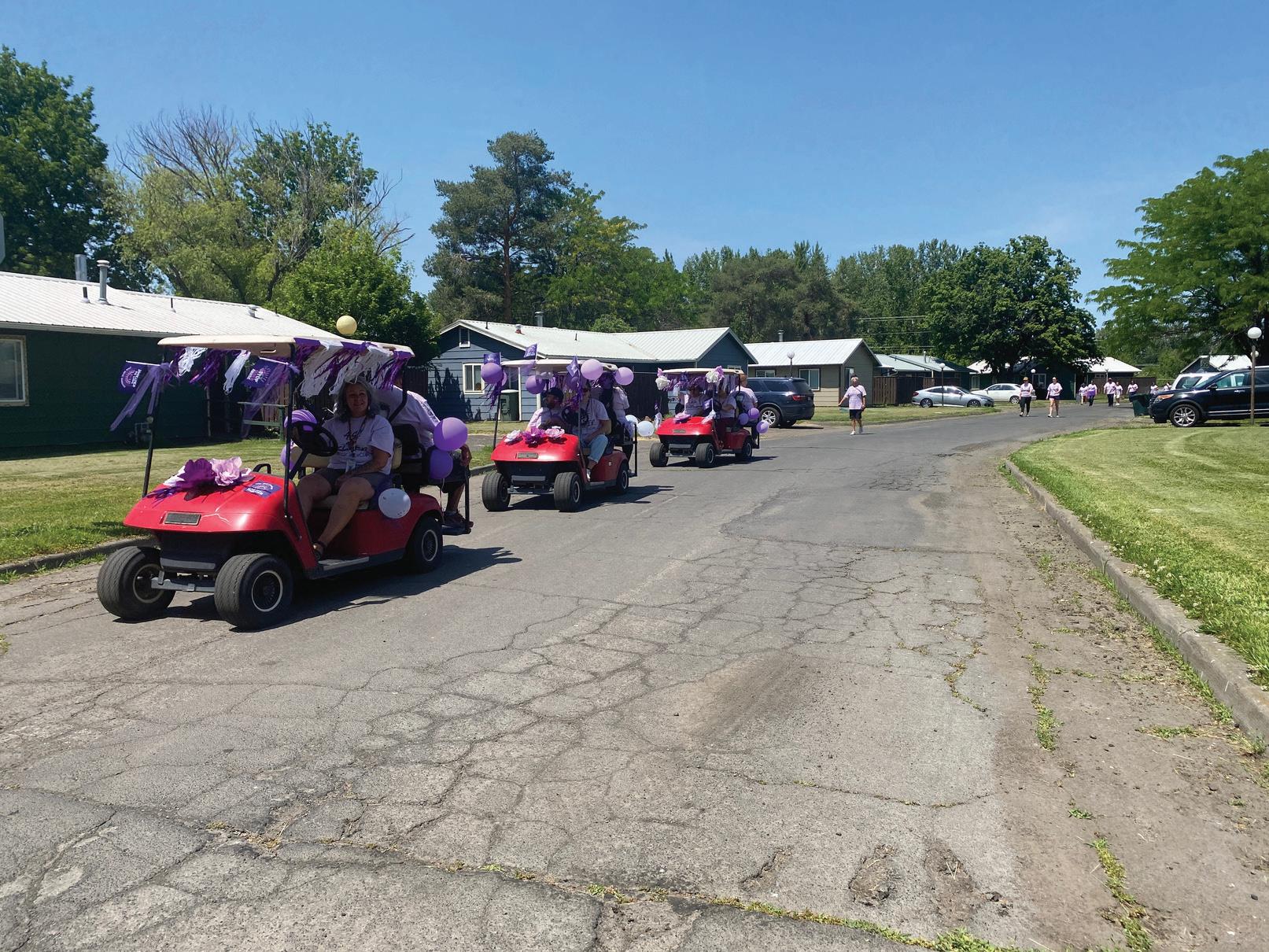



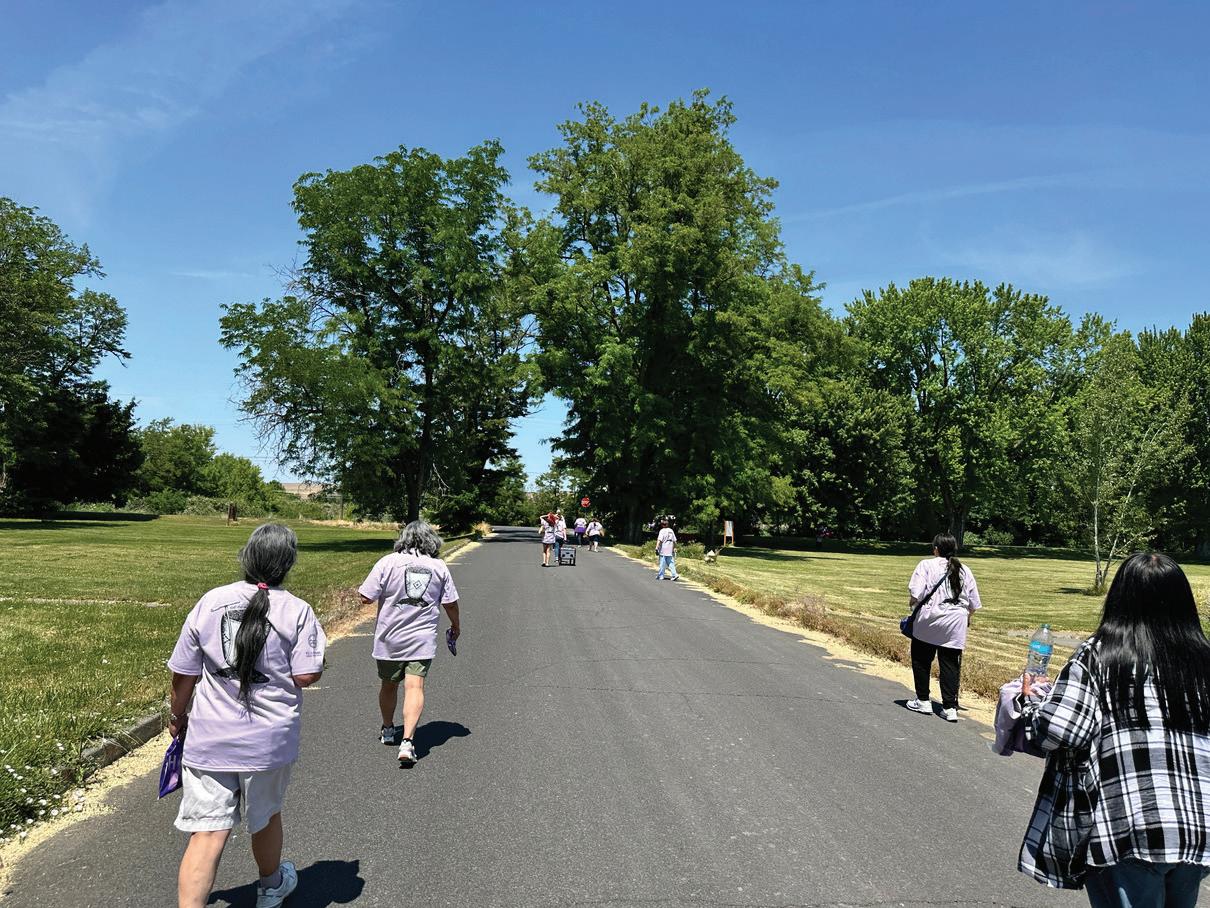


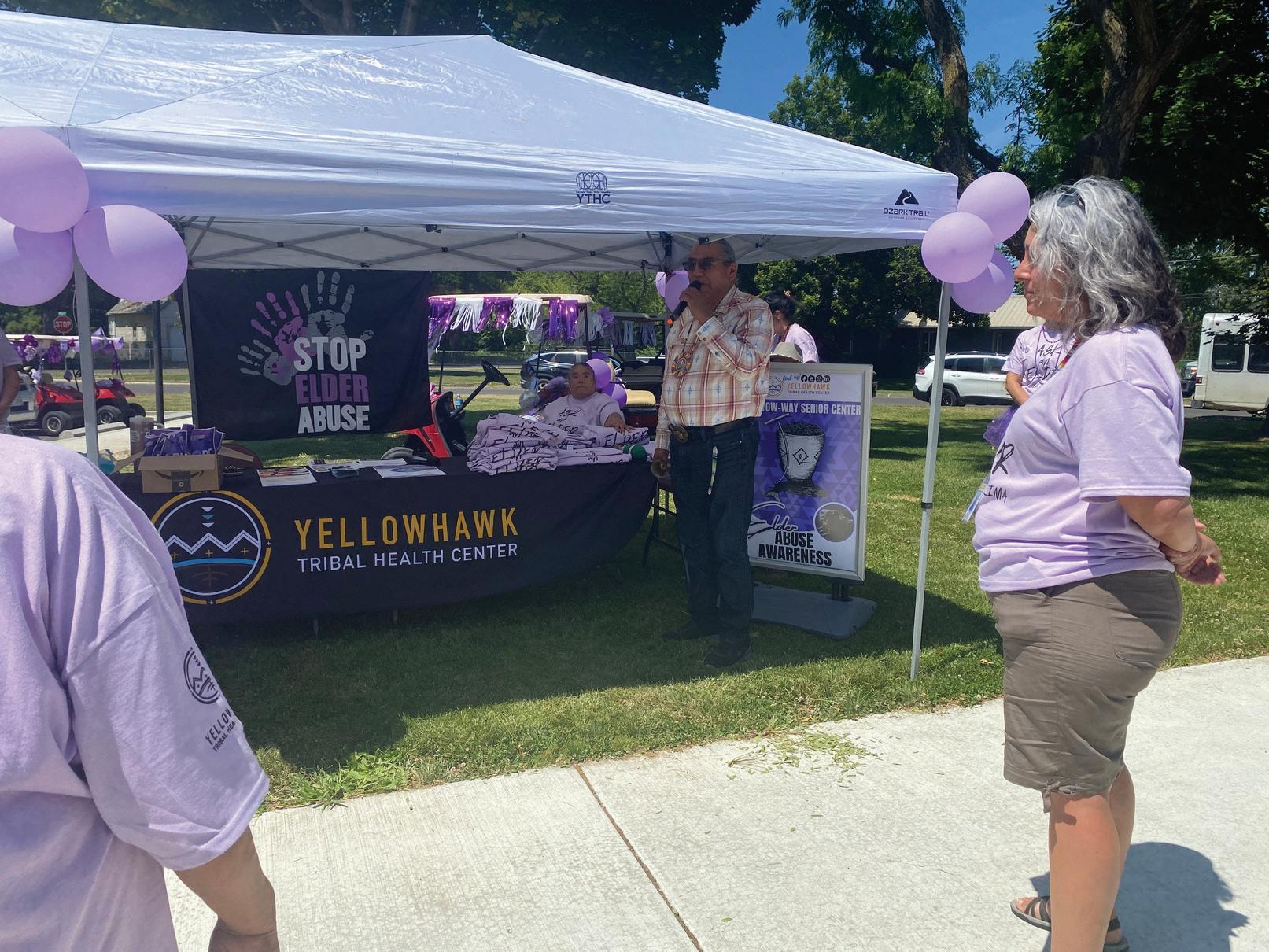




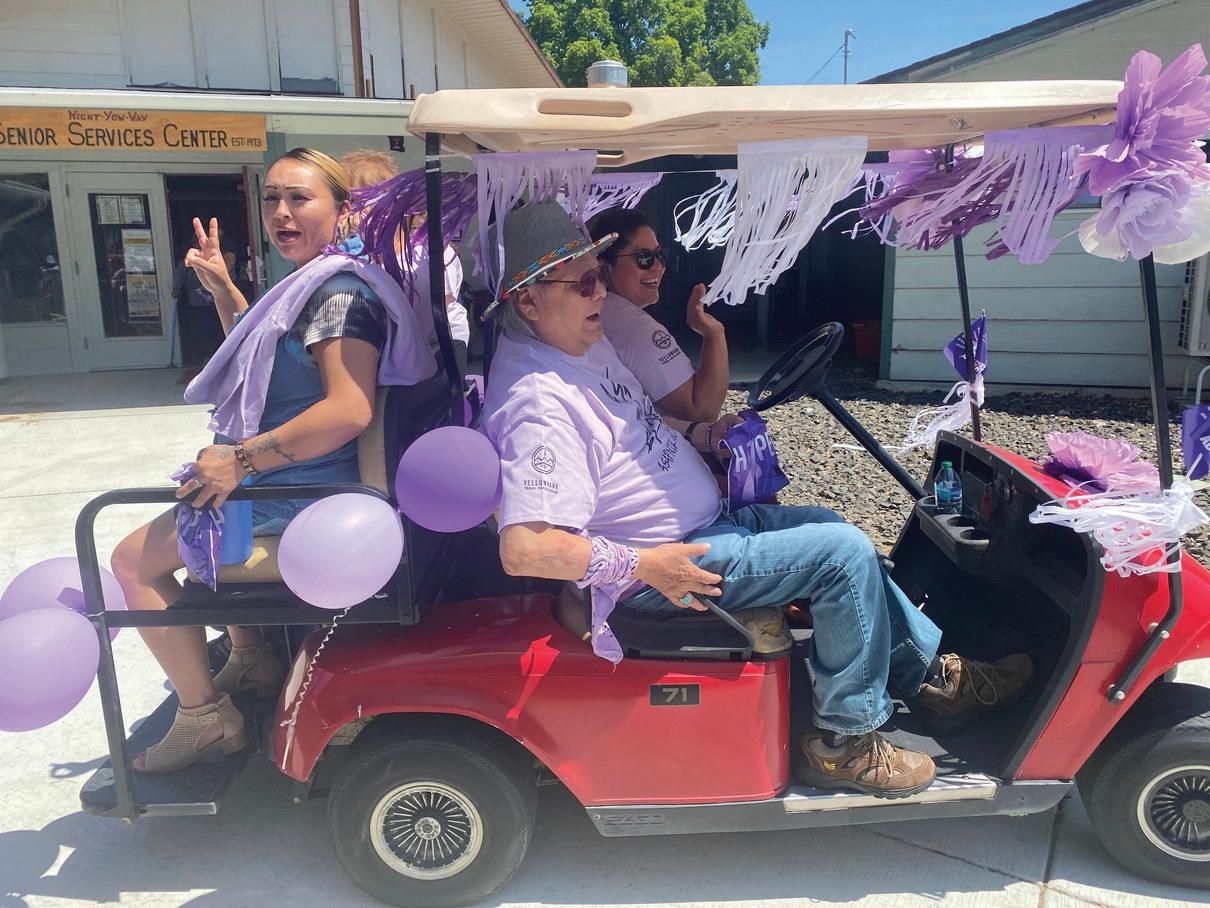


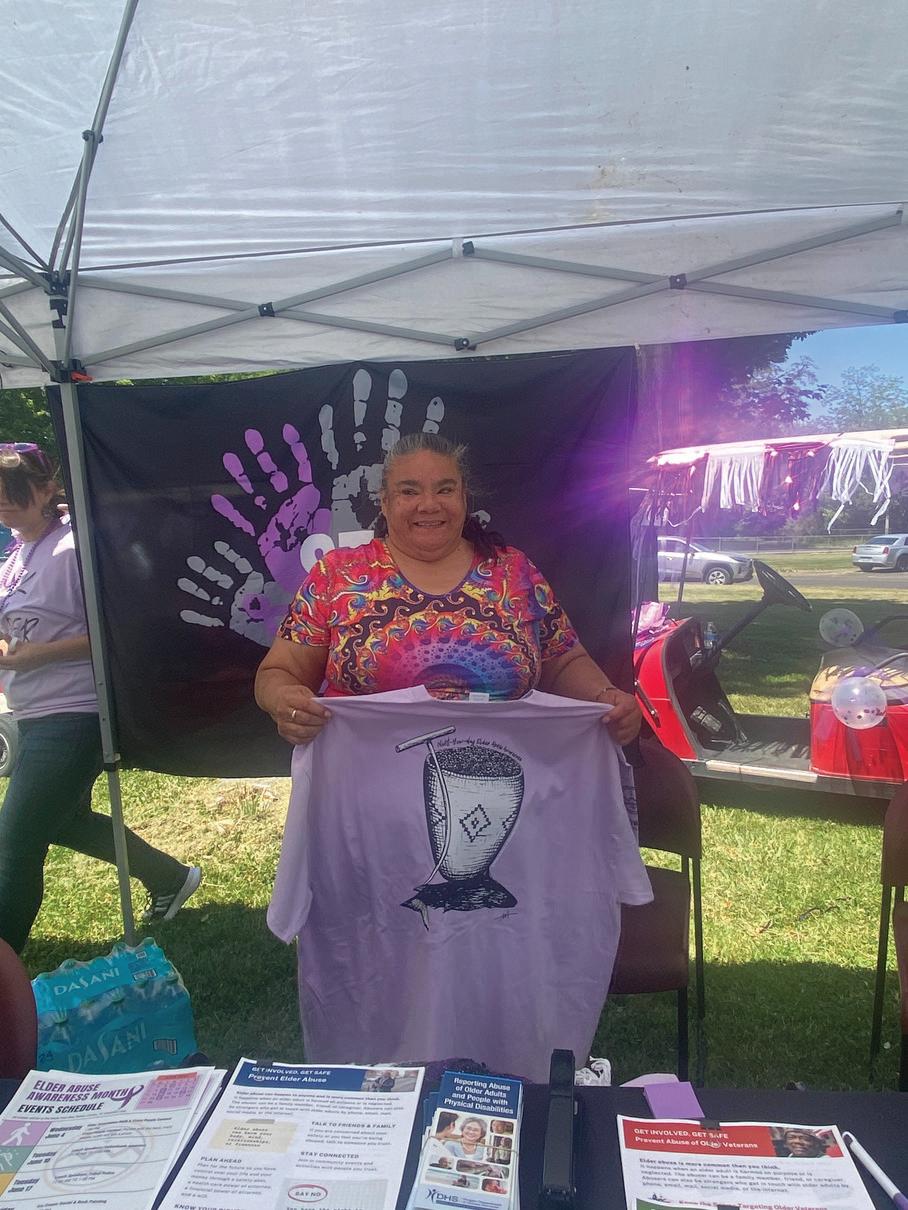
Lawmakers approve record $11.4 billion for Oregon schools
Oregon is increasing spending to keep up with the rising cost of running public schools. But some say student needs are increasing and require even more funding.
TIFFANY CAMHI
OPB
SALEM – Oregon’s $11.36 billion K-12 budget bill is now headed to Oregon Gov. Tina Kotek’s desk. But as a number of school districts throughout the state face grueling financial constraints, some lawmakers and education advocates say the budget is far from enough.
Senate Bill 5516, which passed easily on the House floor Monday afternoon, will increase the budget for Oregon’s State School Fund by more than 11% from the last biennium.
School districts throughout the state rely on money from the fund to pay for operational expenses covering everything from books and utility bills to the salaries of teachers, administrators and other staff.
“Senate Bill 5516 doesn’t solve every challenge, but it’s a clear statement of our values,” said Rep. Ricki Ruiz, D-Gresham, who carried the bill. Ruiz said the bill will also make investments in teacher retention, special education and dual language programs.
The funds allocated for the next two years in the K-12 budget bill represent what lawmakers and budget writers estimate districts need for schools to function as they are now. But some say the state’s so-called “current service level,” or CSL, calculation is already negatively impacting students.
“Oregon educators have been clear from the start – in a time of growing student needs, a budget that simply meets the ‘Current Service Level’ is actually a budget that will cause deep harm to our students, our schools, and the communities they serve,” said Oregon Education Association President Reed Scott-Schwalbach in a statement about the school budget.
Many school boards throughout the state have faced budget deficits and been forced to make cuts ahead of next school year.
Lawmakers did adopt proposed
changes to the CSL backed by Gov. Kotek last year. The governor’s office had said her revisions would streamline the State School Fund and boost its coffers by more than $500 million.
Still, these calculation changes were not enough to satisfy some lawmakers on the House floor. Rep. Paul Evans, D-Monmouth, said the state’s funding formula, which is designed to equitably distribute money to school districts, is overly complicated and confusing. He urged lawmakers to scrap the formula altogether and start from scratch in a future session.
“At some point we need to recognize it’s time to have a ‘no kidding, sleeves rolled up’ conversation about what it is we’re gonna provide for kids,” Evans said. “The system and structure is not designed to produce.”
Republican representatives said they support pumping more money into Oregon’s public schools but could not back a bill without more funding guardrails. Rep. Jami Cate, R-Lebanon, said the current school budget formula does not ensure every student receives funding equitably.
Cate said some schools “have longstanding systemic issues that continue to be shortchanged when we do not address the funding formula.”
She continued. “I appreciate that we are continuing to invest in our schools, but colleagues, I’m frustrated that the benefit of increasing our investment doesn’t trickle down to all schools.”
In addition to the school funding bill, lawmakers on the House floor also passed an education bill that will set up a statewide student outcomes accountability system for Oregon’s school districts: Senate Bill 141. That bill also awaits Gov. Kotek’s signature.
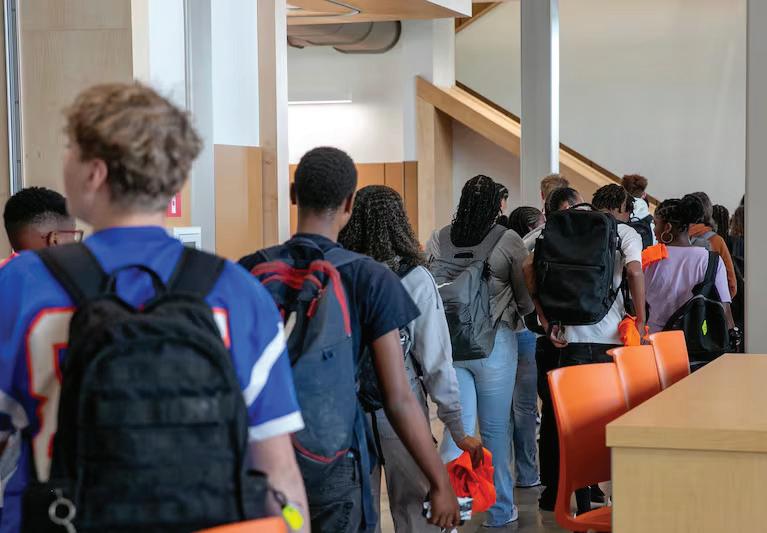
Open house set July 17 for proposed ‘Ŝiŝnamíiš’ subdivision
MISSION – The Confederated Tribes of the Umatilla Indian Reservation (CTUIR) Housing Development Services Team and Wenaha Group Inc. will be available in the lobby of the Nixyáawii Governance Center from 1:30-4 p.m. on Thursday, July 17, to provide information to the community on the next CTUIR housing development project.
The team wants to obtain feedback directly from tribal members regarding lot sizes, desired development standards and lot configurations. A draft poster showing a possible lot configuration for the subdivision will be available.
Following the completion of the Nixyáawii Neighborhood infrastructure and the Timíne North Apartments, the Board of Trustees (BOT) established the Housing Development Services Team through Resolution No. 23-067. The team is a subcommittee of the Capital Improvements Committee, assigned to implement housing-related development associated with the adopted Housing Strategy Plan.
One of the proposed projects is to plan and develop the next residential
subdivision. It will be located on 70 acres of CTUIR-owned trust property (T2103-D) located near Tutuilla Church Road and South Market Road commonly known as the “Nagel property.”
The CTUIR Language Program suggested the name “Ŝiŝnamíiš,” a place name traditionally used for the area.
This property has been identified for future housing since the CTUIR adoption of the 1989 Mission Community Plan. Now that CTUIR has methodology developed for the 99-year housing lease, the Housing Development Team has turned its attention to initial planning for the new site – completing cultural resources clearance, geotechnical evaluations, infrastructure assessments (water and sewer) and assessing lot configuration options.
These preliminary assessments help to determine lot size and development standards for a new residential zone and survey to create the subdivision. This is a similar process used to create the Nixyáawii Neighborhood where lots are leased and homes are being constructed.

Students walk through the remodeled cafeteria at Benson Polytechnic High School, Portland, Ore., Aug. 27, 2024. School districts throughout the state rely on

A $3.4 billion dollar settlement was approved in a class action lawsuit, called Cobell v. Salazar, that claimed individual Indian land, funds and other assets were mismanaged by the federal government. $38 million is available to pay heirs and awards could be significant.

Here’s what you need

Who is eligible?
You are eligible for a money award if you are an heir of one or more of the over 17,000 Individual Indian Money (IIM) account holders whose Cobell settlement awards were not distributed. You must submit a claim form with proof that you are an heir. Claim forms can be submitted online or can be downloaded and mailed to the administrator by June 30, 2025 More details are available on the website.
Heir eligibility proof includes any of the following:
• A state or tribal probate order identifying estate heirs; or
• A last will and testament approved by a probate order; or
• A small estate document from an approved state in accordance with small estate procedures; or
• Documentation showing the appointment of an estate Executor, Administrator, or Personal Representative; or
• A federal probate order that directs distribution of trust funds or trust lands.
A copy of a tribal, or state, or federal probate order is needed to establish whether the Settlement Administrator can pay the heir(s) directly for the estate's Settlement award.
If you do not have a tribal or state probate order but a personal representative or executor has been named for the estate, funds may be released to the representative or executor and they will be responsible for distributing the funds according to the wishes of the deceased Class Member.
You must act quickly.
The deadline to file is June 30, 2025.
After the deadline, all remaining funds will be distributed to the Cobell Scholarship Fund, which is managed by Indigenous Education, Inc.
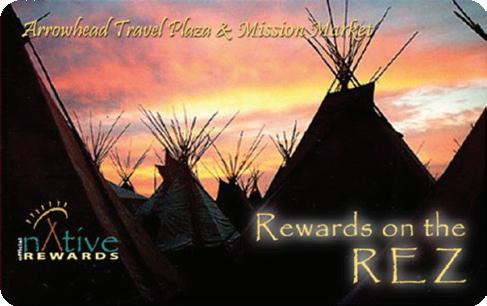
World Forestry Center presents ‘Sasquatch: Ancestral Guardians’ exhibit
PORTLAND – Indigenous peoples have long been in relationship with and shared stories about sacred forest protectors, often called Sasquatch and Bigfoot. And the World Forestry Center is highlighting this relationship with its “Sasquatch: Ancestral Guardians” exhibit until Jan. 4.
The works in this exhibition are made by Indigenous artists and honor generations of spiritual practices, storytelling, and tradition. Leave your preconceived notions behind and immerse yourself, not in the question of if Sasquatch exists, but rather, how are we existing with and honoring this non-human other.
This exhibition was created in collaboration with these Indigenous artists and the High Desert Museum in Bend, Oregon, which commissioned many of the artworks for the exhibition “Sensing Sasquatch” in 2024. Since then, artworks have been re–curated to align with the mission of World Forestry Center with new stories from the forests of the Pacific Northwest, new artwork and two additional artists.
The exhibition is advised by and consists of original artwork by: Phillip Cash Cash, Ph.D. (Nez Perce, Cayuse), HollyAnna CougarTracks DeCoteau Littlebull (Yakama, Nez Perce, Cayuse, Cree), Charlene “Tillie” Moody (Warm Springs), Frank Buffalo Hyde (Nez Perce, Onondaga), Rocky LaRock (Salish), Greg Archuleta (Grand Ronde) and Joe Scott (Siletz).
From t-shirts to beer cans and billboard advertisements, popular images of Sasquatch have become embedded in American culture, transforming the figure into a widely recognized pop icon. As a nod to this phenomenon, the entrance to the exhibition features a lighthearted homage to Sasquatch’s place in mainstream media. However, visitors are invited to set aside these familiar depictions in order to explore a deeper, more culturally grounded understanding. To encourage reflection on the kitsch and commercialization of Sasquatch, visitors are invited to
“bring-your-own” Sasquatch sticker to place on the back of a car driving off into the distance—symbolically sending their preconceived notions away and preparing to enter a space of new perspectives and insight.
Centered on Indigenous art and storytelling, the exhibition highlights the deep respect and reverence many Native peoples hold for this being. American pop culture situates Sasquatch within the wet rainforests of the Pacific Northwest. Though these non-human others exist here, they also traverse dry canyon lands, shrublands, valleys, open fields, and close to homes.
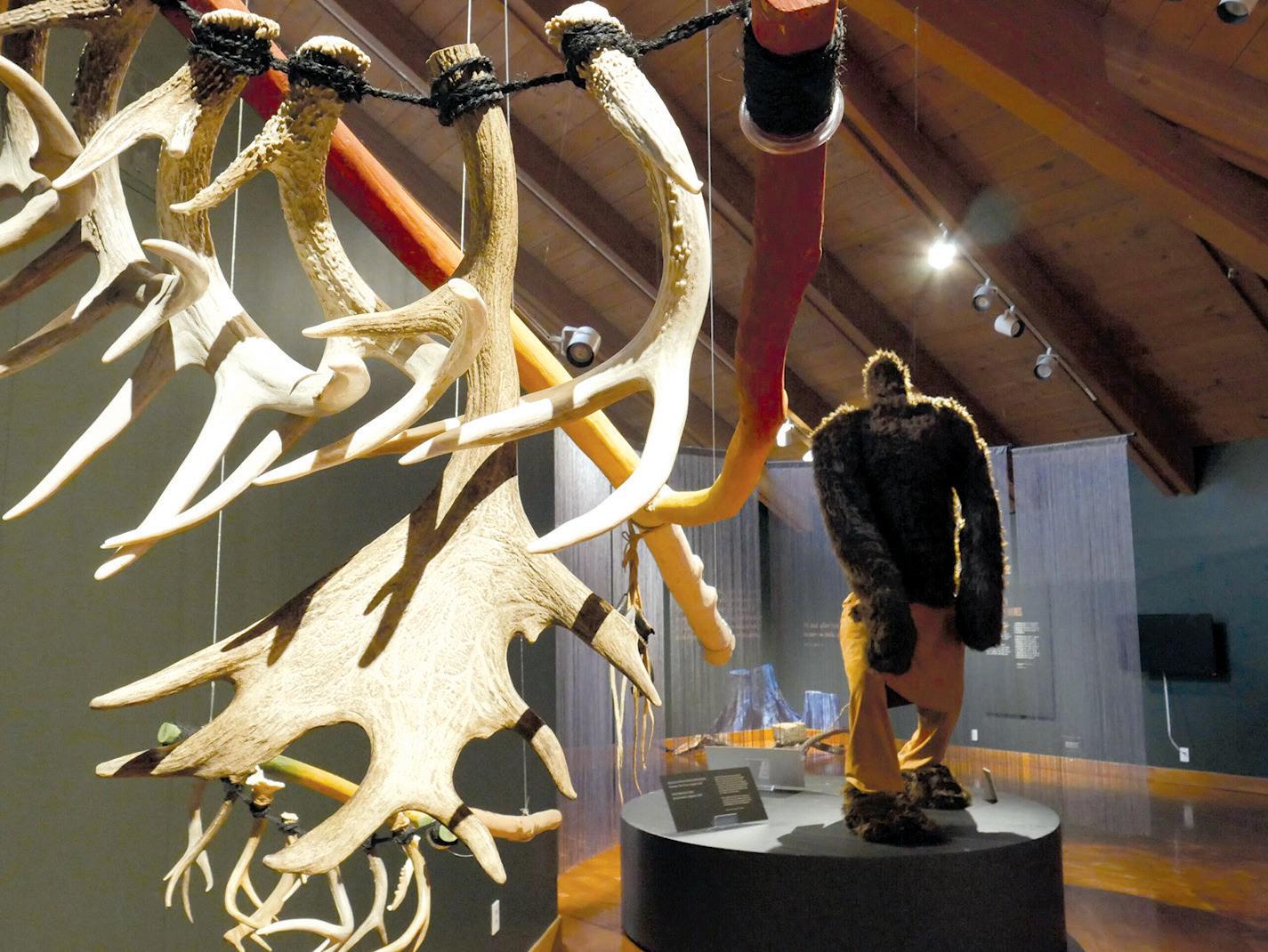
For people who have encountered Sasquatch in these environments, they describe a life-altering experience that overwhelms them.
Whether or not Sasquatch exists is beside the point; in many Indigenous traditions, Sasquatch is regarded as an elder, a relative, and a spiritual guide who may appear to share important messages to humans. Such encounters are not merely sightings—they can be profound, transformative experiences.
Many Indigenous people say that a Sasquatch encounter is a blessing. In turn, they have sought to protect Sasquatch’s anonymity and prevent human access to its wilderness habitat. HollyAnna CougarTracks DeCoteau Littlebull’s (Yakama, Nez Perce, Cayuse, Cree) whose artwork was originally commissioned for High Desert Museum, depicts Sasquatch as a protective “big sister” — not a predator but one who deserves respect and safeguarding. CougarTracks is an avid huckleberry gatherer, land protection advocate, and grew up on the Yakama Indian Reservation and considers herself “a protector of KwiKwiyai, or Bigfoot.”
This exhibition also challenges the common portrayal of Sasquatch as a shy, elusive creature that runs away to avoid human contact. It


instead presents Sasquatch as a sacred being that communicates with people. Central to this perspective is the exhibitions lead advisor and co-creator, Phillip Cash Cash (Nez Perce, Cayuse), whose artwork was also originally commissioned for High Desert Museum’s Sensing Sasquatch—a set of rattles made from cottonwood— imagines tools that Sasquatch might
use. Cash Cash is an artist, writer, and scholar of linguistic anthropology, as well as a passionate advocate for endangered languages. A fluent speaker of Nez Perce, he collaborates with Indigenous communities, museums, and professional organizations on initiatives that support cultural identity, advocacy, communication and healing.
Wanda
Exec. Director, Turtle Cove
Created a comfortable home and haven for her community, and families in need.
The World Forestry Center’s new exhibition, “Sasquatch: Ancestral Guardians,” features stories and art from Native perspectives on Bigfoot. WORLD FORESTRY CENTER
The World Forestry Center’s new exhibition, “Sasquatch: Ancestral Guardians,” features stories and art from Native perspectives on Bigfoot. WORLD FORESTRY CENTER
Trump wants to cut tribal college funding by nearly 90%
MATT KRUPNIC ProPublica
This story was originally published by ProPublica. – The Trump administration has proposed cutting funding for tribal colleges and universities by nearly 90%, a move that would likely shut down most or all of the institutions created to serve students disadvantaged by the nation’s historic mistreatment of Indigenous communities.
federal government’s trust and treaty obligations to tribes. The Coalition for Tribal Sovereignty said last month that the administration’s proposed discretionary spending for the benefit of Native Americans would fall to its lowest point in more than 15 years, which it viewed as “an effort to permanently impact trust and treaty obligations to Tribal Nations.”
Congress passed legislation in 1978 committing to fund the tribal college system and promising inflation-adjusted

The proposal is included in the budget request from the Department of the Interior to Congress, which was released publicly on Monday. The document mentions only the two federally controlled tribal colleges — Haskell Indian Nations University and Southwestern Indian Polytechnic Institute — but notes the request for postsecondary programs will drop from more than $182 million this year to just over $22 million for 2026.
If Congress supports the administration’s proposal, it would devastate the nation’s 37 tribal colleges and universities, said Ahniwake Rose, president and CEO of the American Indian Higher Education Consortium, which represents the colleges in Washington, D.C.
“The numbers that are being proposed would close the tribal colleges,” Rose told ProPublica. “They would not be able to sustain.”
ProPublica found last year that Congress was underfunding tribal colleges by a quarter-billion dollars per year. The Bureau of Indian Education, tasked with requesting funding for the institutions, had never asked lawmakers to fully fund the institutions at the levels called for in the law, ProPublica found.
But rather than remedy the problem, the Trump administration’s budget would devastate the colleges, tribal education leaders said.
The Bureau of Indian Education, which administers federal funding for tribal colleges, and the Department of the Interior, the bureau’s parent agency, declined to answer questions.
Rose said she and other college leaders had not been warned of the proposed cuts nor consulted during the budgeting process. Federal officials had not reached out to the colleges by the end of the day Monday.
The proposal comes as the Trump administration has outlined a host of funding cuts related to the
consistently lagged far behind inflation.
The colleges have managed, despite the meager funds, to preserve Indigenous languages, conduct highlevel research and train local residents in nursing, meat processing and other professions and trades. But with virtually no money available for infrastructure or construction, the schools have been forced to navigate broken water pipes, sewage leaks, crumbling roofs and other problems that have compounded the financial shortcomings.
Tribal college leaders said they were stunned by the proposed cuts to their already insufficient funding and had more questions than answers.
“I’m shivering in my boots,” said Manoj Patil, president of Little Priest Tribal College in Nebraska. “This would basically be a knife in the chest. It’s a dagger, and I don’t know how we can survive these types of cuts.”
Congress will have the final say on the budget, noted Rep. Teresa Leger Fernández, the ranking Democrat on the House Subcommittee on Indian and Insular Affairs, whose New Mexico district includes three tribal colleges. Tribal colleges “are lifelines in Indian Country,” Leger Fernández said in a statement. “They provide higher education rooted in language, culture and community. These cuts would rob Native students of opportunity and violate our trust responsibilities.”
latest in a string of bad financial news for tribal colleges since President Donald Trump began his second term. The administration suspended Department of Agriculture grants that funded scholarships and research, and tribal college presidents spent the past week trying to fend off deep cuts to the Pell Grant program for low-income students. The vast majority of tribal college students rely on Pell funding to attend school.
Tribal colleges contend their funding is protected by treaties and the federal trust responsibility, a legal obligation requiring the United States to protect Indigenous education, resources, rights and assets. And they note that the institutions are economic engines in some of North America’s poorest areas, providing jobs, training and social services in often remote locations.
“It doesn’t make sense for them to (approve the cuts) when they’re relying on us to train the workforce,” said Dawn Frank, president of Oglala Lakota College in South Dakota. “We’re really relying on our senators and representatives to live up to their treaty and trust obligation.”
But others noted they have spent years meeting with federal representatives to emphasize the importance of tribal colleges to their communities and have been disappointed by the chronic underfunding.
appropriations based on the number of students enrolled in federally recognized tribes. But those appropriations have

Other members of the House and Senate Indian Affairs committees did not immediately respond to questions from ProPublica. The White House also did not respond to a request for more information.
Monday’s budget release was the
“It is a bit disheartening to feel like our voice is not being heard,” said Chris Caldwell, president of College of Menominee Nation in Wisconsin. “They don’t hear our message.”
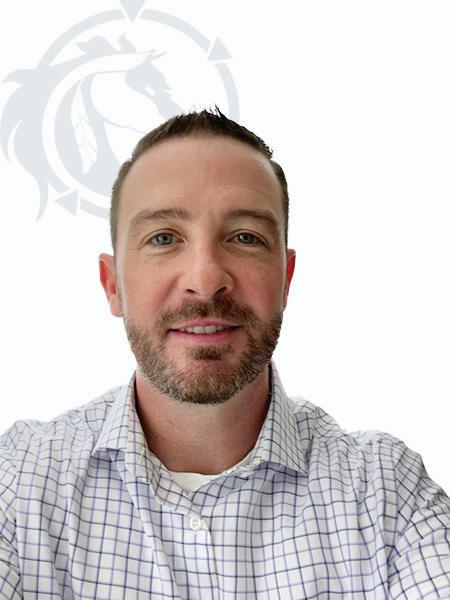

A student, left, and college staff member walk through the Blackfeet Community College campus in Browning, Montana. The Trump administration has proposed deep cuts to tribal colleges across the country. Credit:Rebecca STUMPF/PROPUBLICASTORIES
General Council hosts Treaty Day events on June 13
MISSION – The Confederated Tribes of the Umatilla Indian Reservation (CTUIR) General Council on Friday, June 13 hosted its annual Treaty Day Parade celebrating the signing of the Treaty of 1855.
Signed 170 years ago, the Treaty of June 9, 1855 between the United States and the Cayuse, Walla Walla and Umatilla Tribes established the Umatilla Indian Reservation in exchange for 6.4 million acres the tribes ceded to the federal government. However, the tribes reserved rights for fishing, hunting, gathering foods and medicines, and pasturing livestock. They had also reserved 510,000 acres on which to live. The Treaty was subsequently ratified by Congress on March 8, 1859.
The parade began at 9 a.m. at the Bureau of Indian Affairs parking lot. At 10 a.m., a Veterans Memorial was held followed by lunch at the Longhouse. The day’s
speakers included CTUIR Youth Councilors, Board of Trustees (BOT) Treasurer Raymond Huesties, (BOT) Secretary Roberta Wilson and BOT Members at Large Toby Patrick and Corinne Sams. Keynote speaker and parade Grand Marshal Jeanine Gordon delivered the featured address during the Treaty Day Program at noon. The Tribal Court took won best float, while Manaia Wolf was named best dressed, receiving a Pendleton blanket gifted from Tamástslikt Culture Institute.
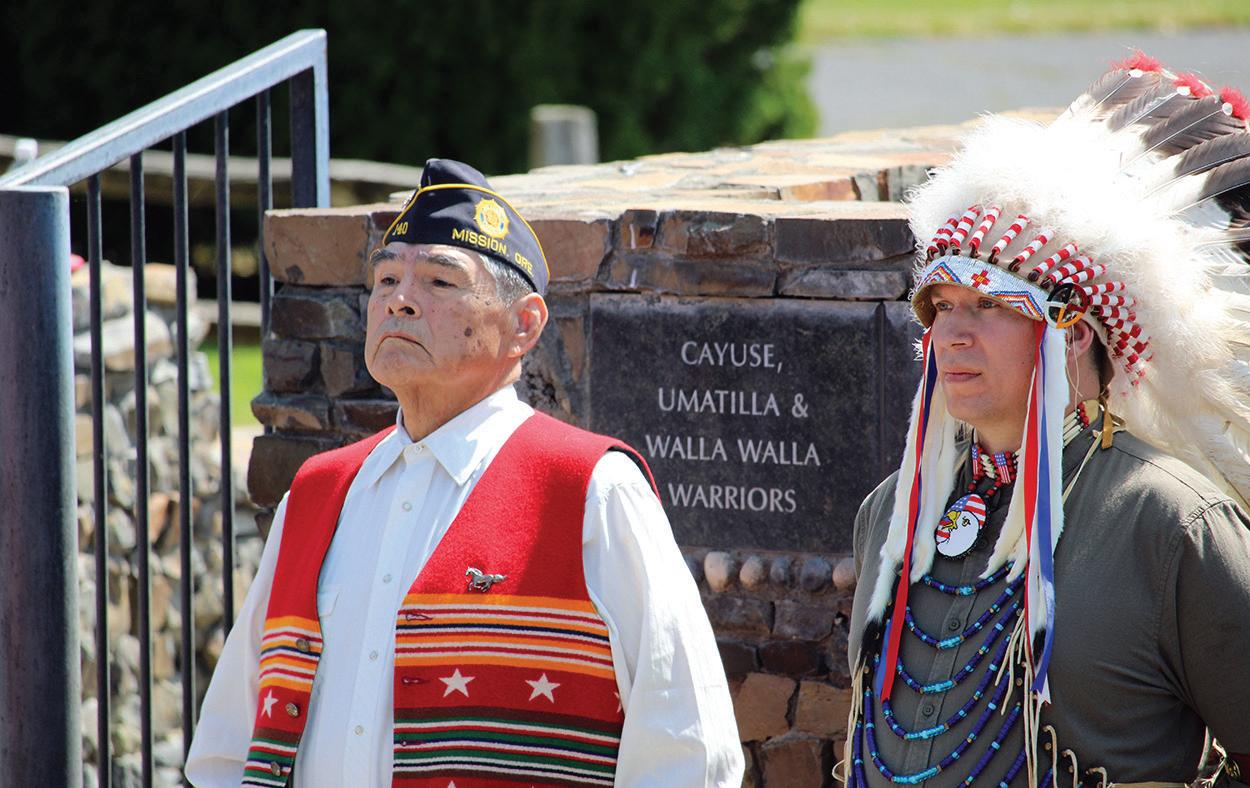
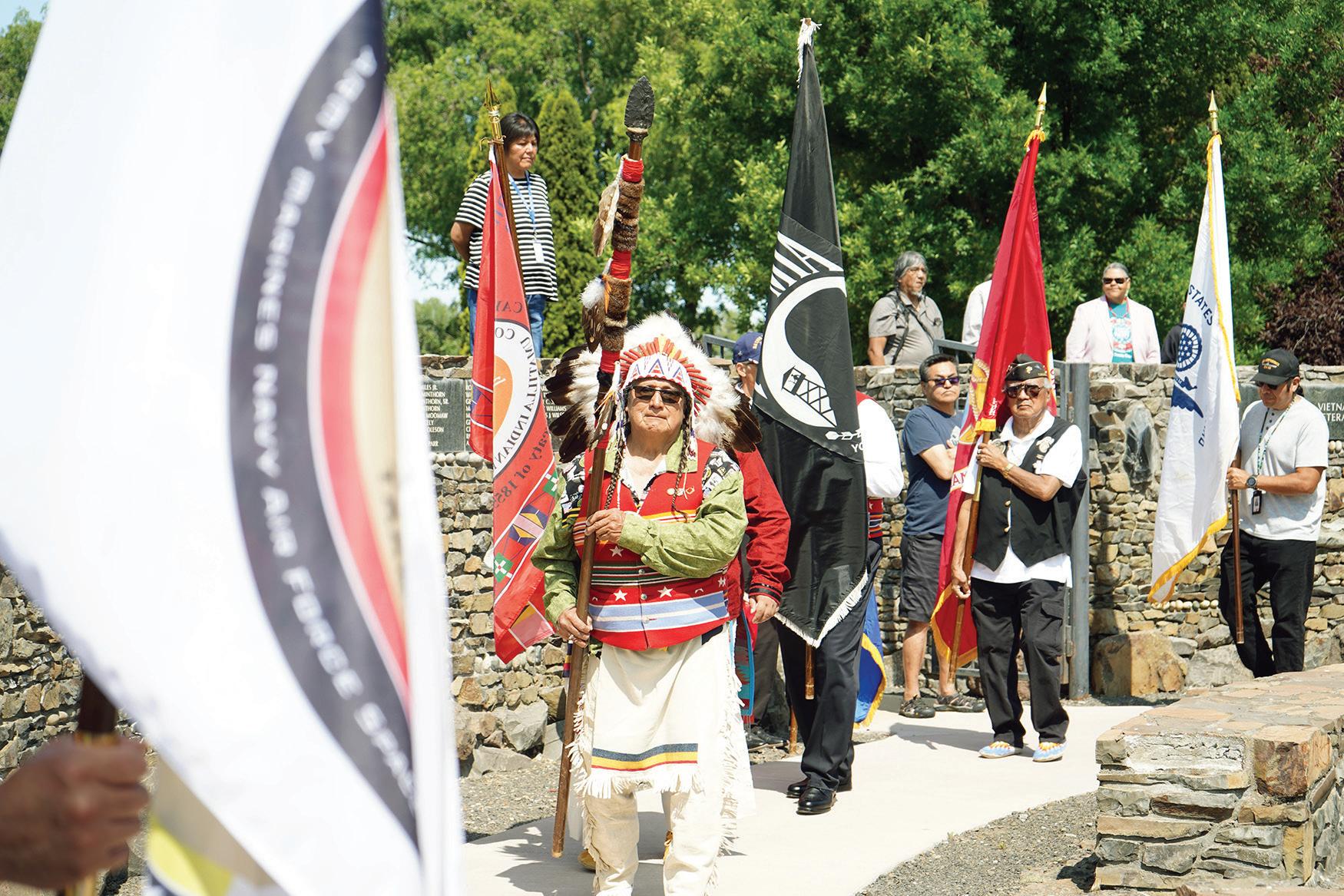
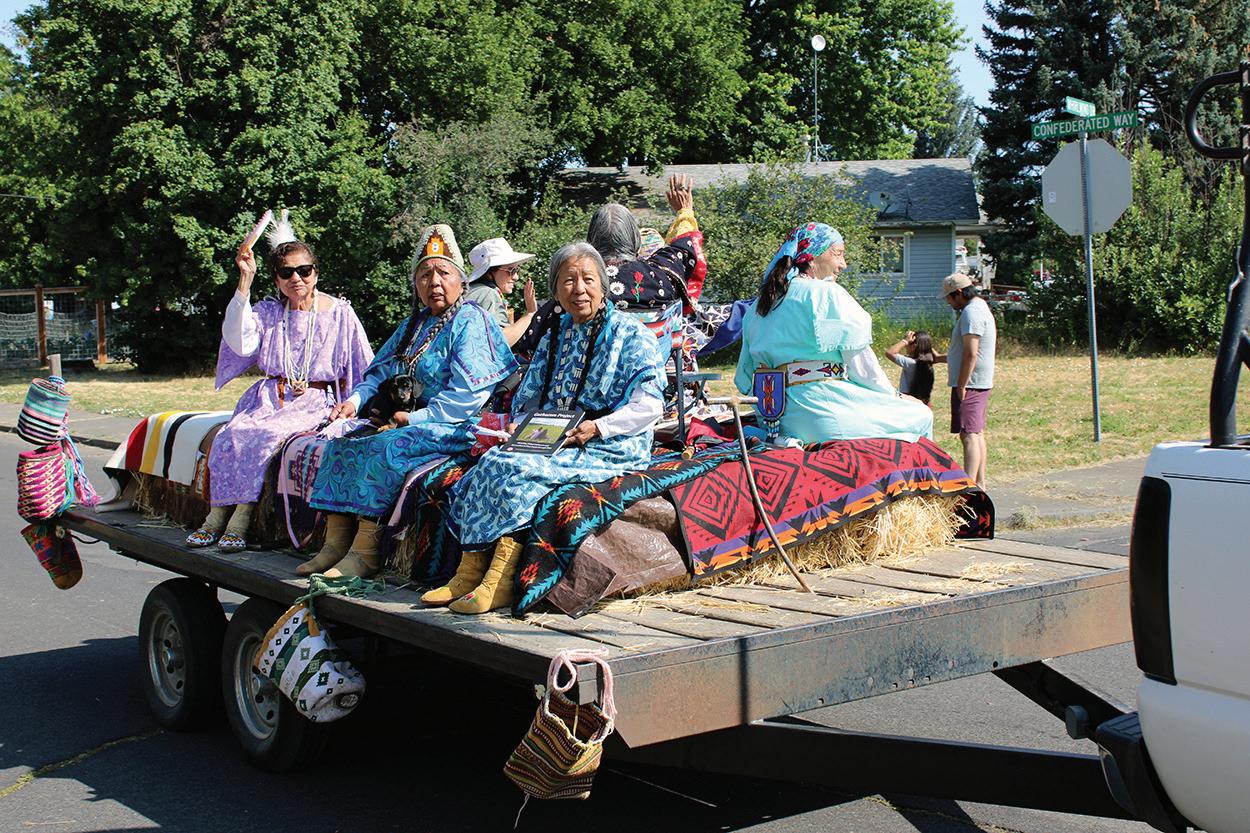
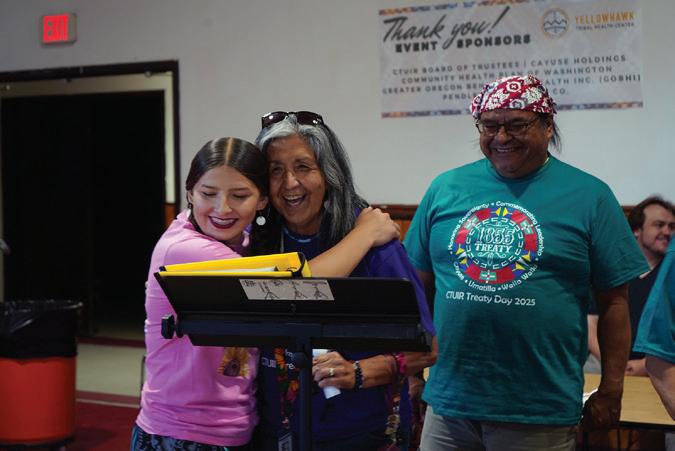

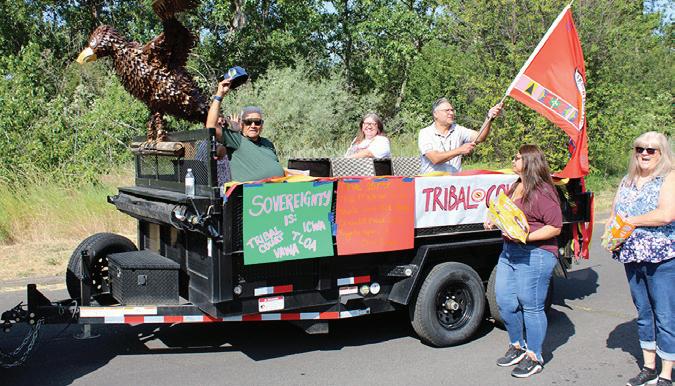
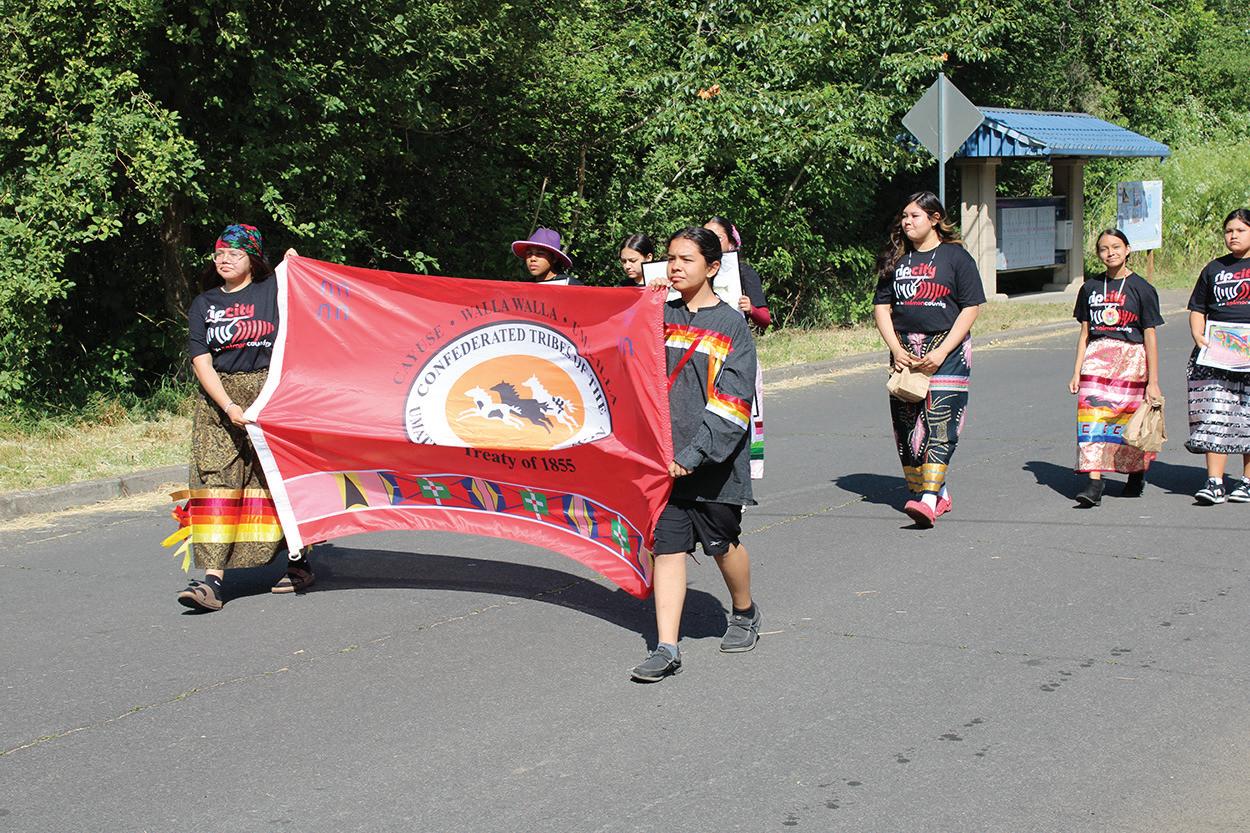
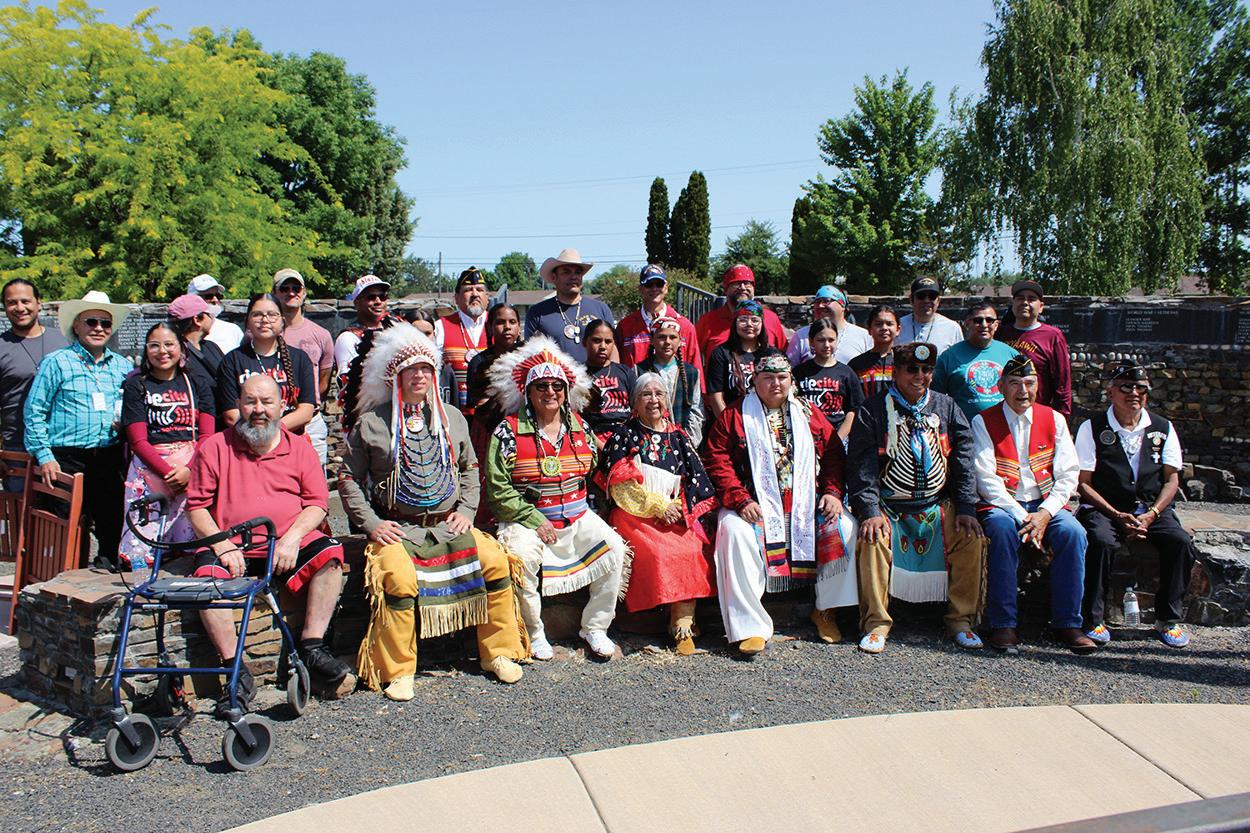
State Champs–Pendleton knocks off top-ranked Marist for 4A title

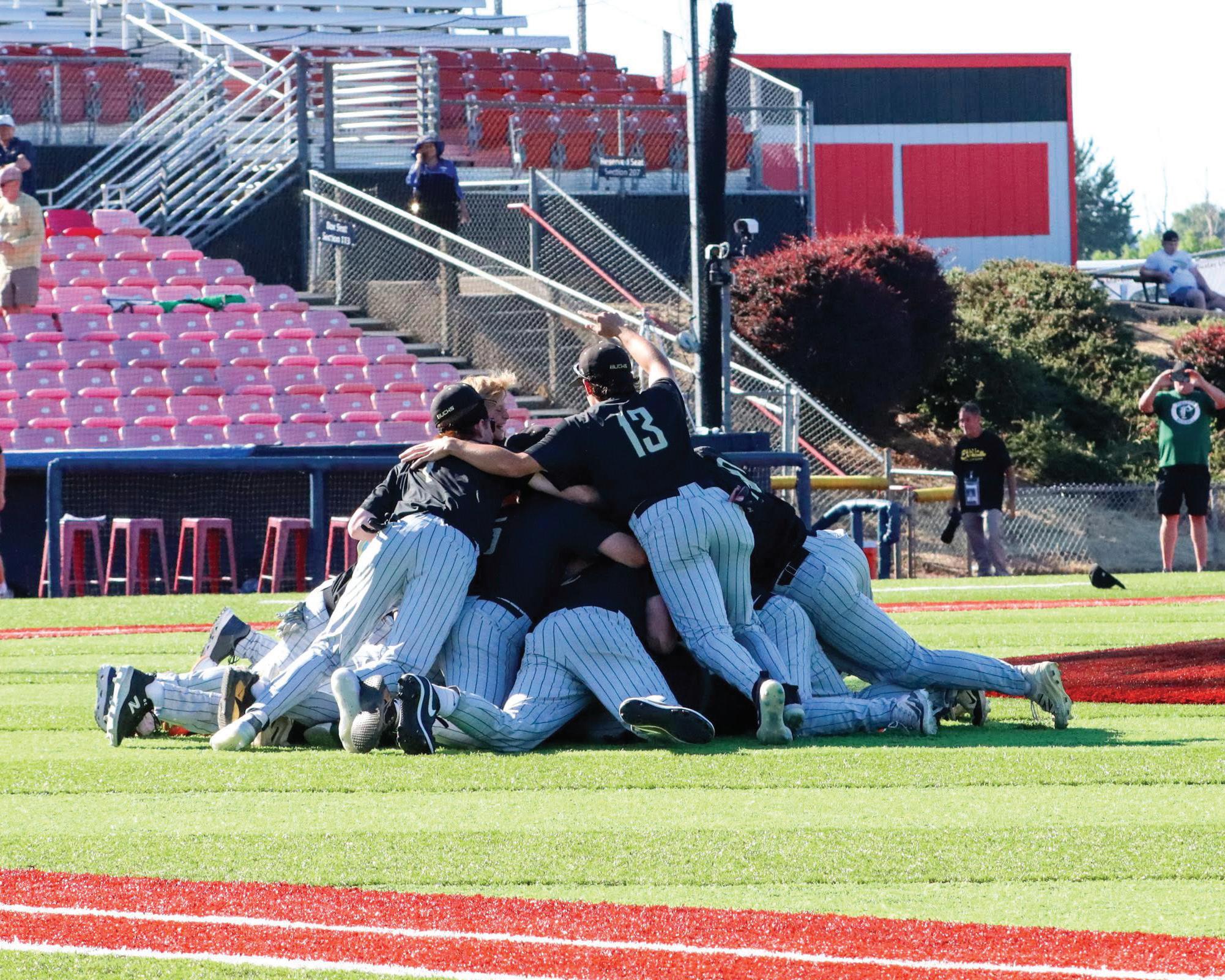
ANNIE FOWLER
KEIZER — Mason Strong drove in four runs, and Evan Lehnert pitched a complete game, as Pendleton ran over top-ranked Marist Catholic 14-3 in six innings to win the 4A state title on Saturday, June 7, at Roto Rooter Park.
It’s the first state baseball title in school history for the Bucks, who finished their season 23-8 and on a seven-game win streak.
“It’s phenomenal,” Pendleton coach Justin Speer said of the win. “Knowing how important and big baseball is for Pendleton High School, I’m proud of them to be able to do that. I’ve looked at the banners in Warberg Court and we didn’t have one. Now we do.”
Marist, which was ranked No. 1 all season, finished the season with a 25-4 record.
“Give them credit, they were the No. 1 seed all year,” Speer said. “I think they were up against a barnstorm against us. Our guys woke up today wanting to win. We were better than them today.”
The Bucks, who lost to the Spartans 14-4 in last year’s quarterfinals, put together a complete team game which included 16 hits and solid defense behind Lehnert.
“That is a testament to our team,” Speer said. “We have some competitive players. We find a way to get everyone involved. That’s why we won. It was a complete team effort.”
The Bucks were the first ones on the board, as Vance Nelson hit an RBI single and Colson Primus scored on a wild pitch.
The Spartans went three up, three down in the bottom of the first, putting Pendleton back at the plate.
Lehnert was hit by a pitch to drive in the first of five runs, and Colin Harrington followed with a two-run double for a 5-0 lead. Strong belted a two-run double to center field to push two more runs across the plate for a 7-0 lead.
The Spartans put a bit of life back in their game with two runs in the bottom of the second. Their first run came off
an error, and Jalen Smith had an RBI single to help pull his team to within 7-2.
Pendleton went scoreless in the third, while Marist scored once off a sacrifice fly by Gianni Lombardi for a 7-3 game.
The Bucks went back to work in the fourth, scoring four runs on four hits and chasing Lombardi from the mound.
With the bases loaded, Strong hit a two-run double to right field, Art Hill followed with an RBI groundout, and Jacob Neistadt pushed Strong across home plate with a single to right field.
“Mason hit the crap out of the ball,” Speer said. “Just to watch him and see how locked in he is, it’s fun to watch.”
After a scoreless fifth, Hill got the ball rolling in the top of the sixth with an RBI single, Keegan Kline had an RBI double, and Anson Dressler finished the scoring with an RBI single.
Lehnert, the Greater Oregon League player of the year, gave up three runs on four hits while striking out five and walking two. The school record holder in strikeouts for a single season,
Pendleton rakes in GOL, all-state honors
ANNIE FOWLER
PENDLETON — Pendleton dominated the first team with five players, and senior Evan Lehnert was named player of the year, as the Bucks ran away with a saddlebag of Greater Oregon League honors.
First-team GOL honors went to infielders Colson Primus and Art Hill, first baseman Jacob Neistadt, outfielder Mason Strong and catcher Vance Nelson.
Lehnert was the cream of the crop when it came to pitching this season. He was 11-1, including a win in the Bucks’ 14-3 victory over Marist Catholic in the 4A state championship game. He had an ERA of .774, struck out a singleseason school record 109, and walked just 16 batters over the course of 72 1/3 innings.
He gave up 43 hits, 15 runs and just eight earned runs as Pendleton posted

a 23-8 record. Defensively he had just three errors.
“Evan was the heart of our championship team,” Pendleton coach Justin Speer said. “A true leader on and off the field. Evan set the alltime strikeout record while guiding us to a state title with unmatched determination and poise.”
Primus played in all 31 games for the Bucks. He hit .381 with a team-high 40 hits, including 31 singles, seven doubles, one triple and one home run. He also had a team-high 44 RBIs, scored 28 runs and had six stolen bases. Defensively, he had six errors in 55 chances, and had a part in two double plays.
“Colson is a three-year varsity player for us who hit in the three hole,” Speer said. “He was our team’s silver slugger this year. He was Mr. Clutch offensively for us all year and came through in so many big moments.”
he added to his tally, which now stands at 109.
“That is going to be quite the feat to beat,” Speer said.
Harrington was 3-for-4 with a double, two RBIs and three runs scored for the Bucks, while Nelson was 3-for-4 with an RBI, Neistadt was 2-for-4 with an RBI, and Strong was 2-for-3 with two doubles and four RBIs.
The Bucks got off to a rocky start at the beginning of the season, losing five of their first seven games. It wouldn’t be long before they had an 11-game win streak and won the GOL title.
To reach the championship game, No. 7 Pendleton beat No. 10 North Bend 8-0, No. 2 Junction City 9-6 and No. 3 Scappoose 10-2.
“I’m a big believer that as the season progresses there are peaks and valleys,” Speer said. “I think that (slow start to the season) pushed us down to reality. I think it was good for us. From there, they bought in. They followed our lead and executed.”
Hill, the Bucks’ steady second baseman, hit .291 with 25 hits. He had 19 singles, five doubles, one triple and 25 RBIs. He also scored 21 runs and had six stolen bases. Defensively, had six errors in 69 chances (.913) and was part of five double plays.
“He is a solid bat in our lineup,” Speer said. “He played a smooth second base for us all year.”
Neistadt, who played in 23 games, hit .321 with 18 hits, including six doubles and one home run. He drove in 10 runs and scored 14 times. He was a big asset defensively for the Bucks with just four errors in 127 chances (.969), and helped turn seven double plays. Strong was solid all the way around for the Bucks. He played 31 games, hitting .429 with 36 hits, including 13 doubles, one triple and two home runs. He drove in 38 runs, scored 26 times,
Pendleton celebrates its 4A state championship June 7, 2025, in Keizer. The Bucks beat topranked Marist Catholic 14-3 for their first-ever state title. – JANE HILL/COURTESY
Pendleton’s Evan Lehnert was named the Greater Oregon League and the 4A allstate pitcher of the year. He led the Bucks to their first state title. – KATHY ANEY/ CUJ
Pendleton players pile on top of pitcher Evan Lehnert after he struck out a Marist Catholic batter for the last out of the game and the state title. – JANE HILL/COURTESY
CTUIR Officials, Members Celebrate lampreys in Oregon City
PORTLAND – Indigenous peoOREGON CITY – Elected officials, employees and members of the Confederated Tribes of the Umatilla Indian Reservation (CTUIR) traveled to Clackamette Park on Thursday, June 26, to attend the 2025 Willamette Falls Lamprey Celebration.
Hosted by the Yakama Nation, people from the surrounding community as well as the CTUIR, Confederated Tribes of Warms Springs and Nez Perce Tribe gathered to learn about and celebrate the lamprey.
“We’re here today to celebrate the return of our Pacific lamprey eels in the Willamette system here at Willamette Falls where we all have historically come to fish, trade and celebrate with other relatives of ours (Yakama, Warms Springs and Nez Perce) in the region,” said CTUIR Board of Trustees Member at Large Corinne Sams, who attended the event with fellow BOT Member at Large Toby Patrick. “This is our usual and accustomed fishing site. We’ve been coming here for millennia, and we’ll continue to come here to fish and to celebrate the return of our most ancient fish.”
For centuries, the tribes of the region have harvested lamprey at Willamette Falls. However, despite dating back approximately 450 million years, today Pacific lamprey numbers in the Columbia River and its tributaries have plummeted because of the construction of dams.
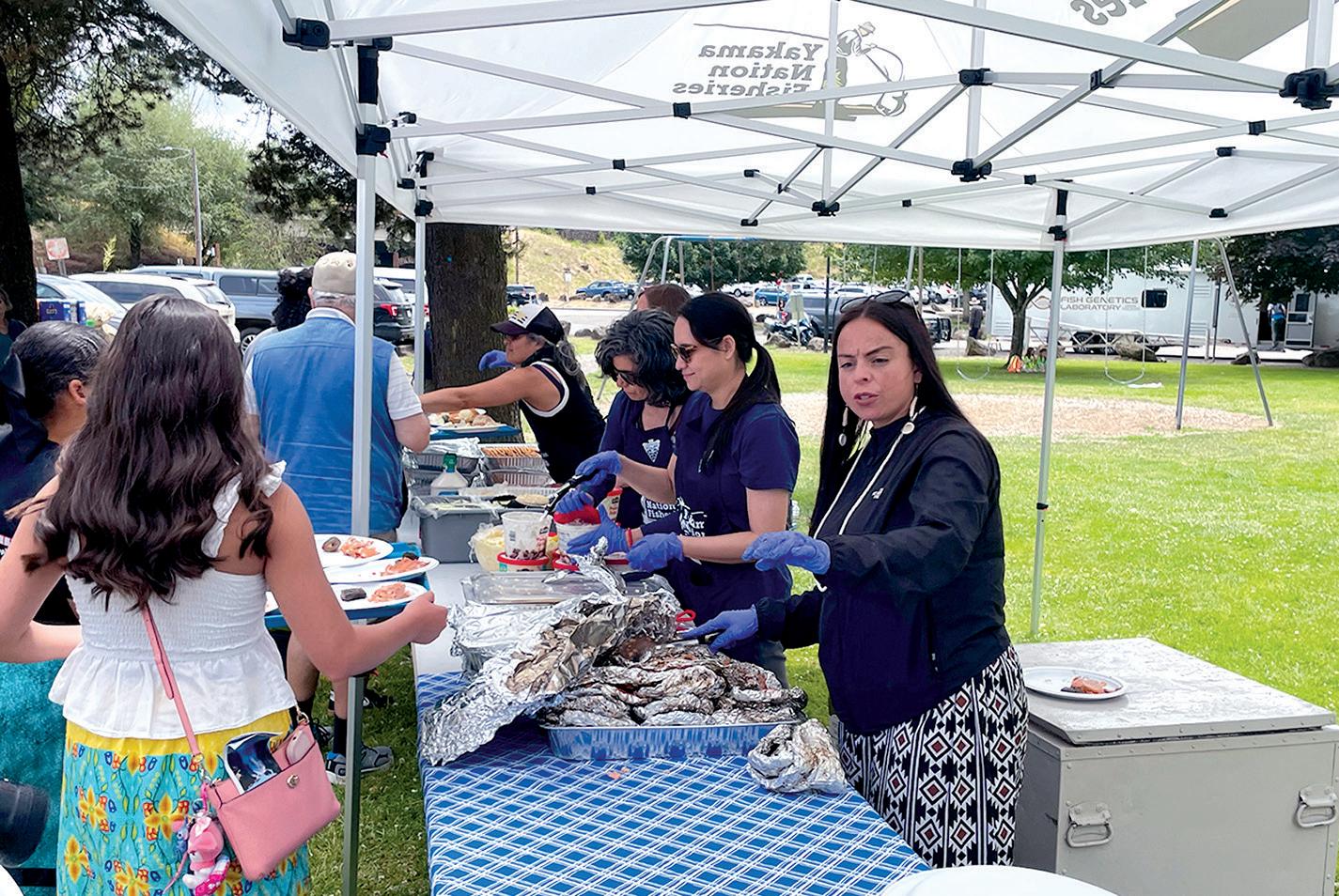
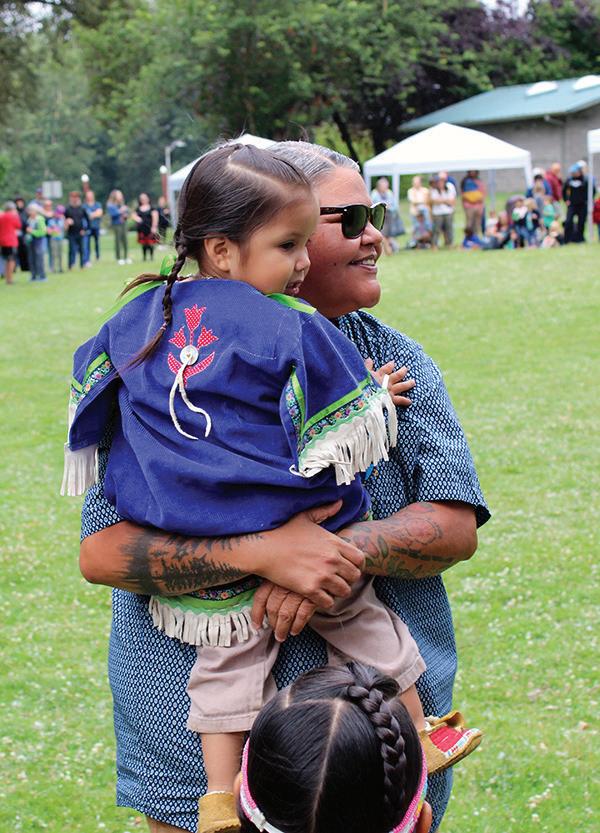

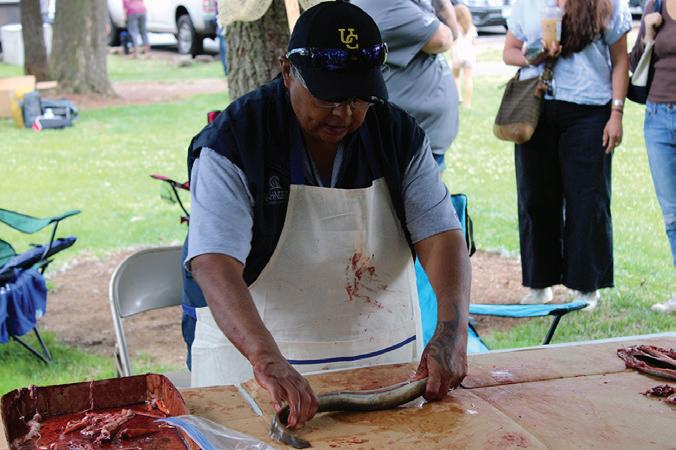
Pendleton rakes in GOL, all-state honors
Continued from page 17
and had a team-high 21 stolen bases. In the field, he had three errors in 37 chances (.919).
“His power bat, plus his speed, make him a weapon in any lineup,” Speer said. “His dynamic skill set makes him a tough match for many teams.”
Nelson was steady behind the plate for Pendleton, giving Lehnert and the rest of the pitching staff a sense of comfort. Defensively, Nelson had just seven errors in 207 chances (.966) and was part of one double play. At the plate, he hit .325 with 27 hits. He had eight doubles, two triples, two home runs and 25 RBIs.
Lehnert, who is headed to Linn Benton Community College, also was named the 4A all-state pitcher of the
Sams, who also serves as the Columbia River Inter-Tribal Fish Commission (CRITFC) treasurer, said the CTUIR Lamprey Project plays a significant role in increasing the number of lampreys in the Willamette system, the Columbia River Basin and its tributaries.
“They do an enormous amount of work with trans-relocating these fish to areas that they’ve vanished from,” she said. “Just yesterday, our crew, along with the other member tribes, trapped some eels at Bonneville Dam and trans-located them up to Eugene to be in the Willamette system so we always have an abundance of eels for us to harvest.”
The celebration included information booths, lamprey preparation demonstrations, inter-tribal dances, speakers from the four tribes, as well as a meal highlighted by lamprey and salmon. Boat tours also gave organizers an opportunity to teach the public about why Willamette Falls is important for harvesting lamprey.
“It’s important to have this celebration to honor our First Foods, to honor the return of the eel, and so in our tradition it’s important to celebrate that we celebrate that and give thanks and prayers and to give some enthusiasm to those who continue to do the work every day on behalf of the tribes,” Sams said. “And the significance of having it here is that it is close in proximity to Willamette Falls, the place where we do harvest eels.”

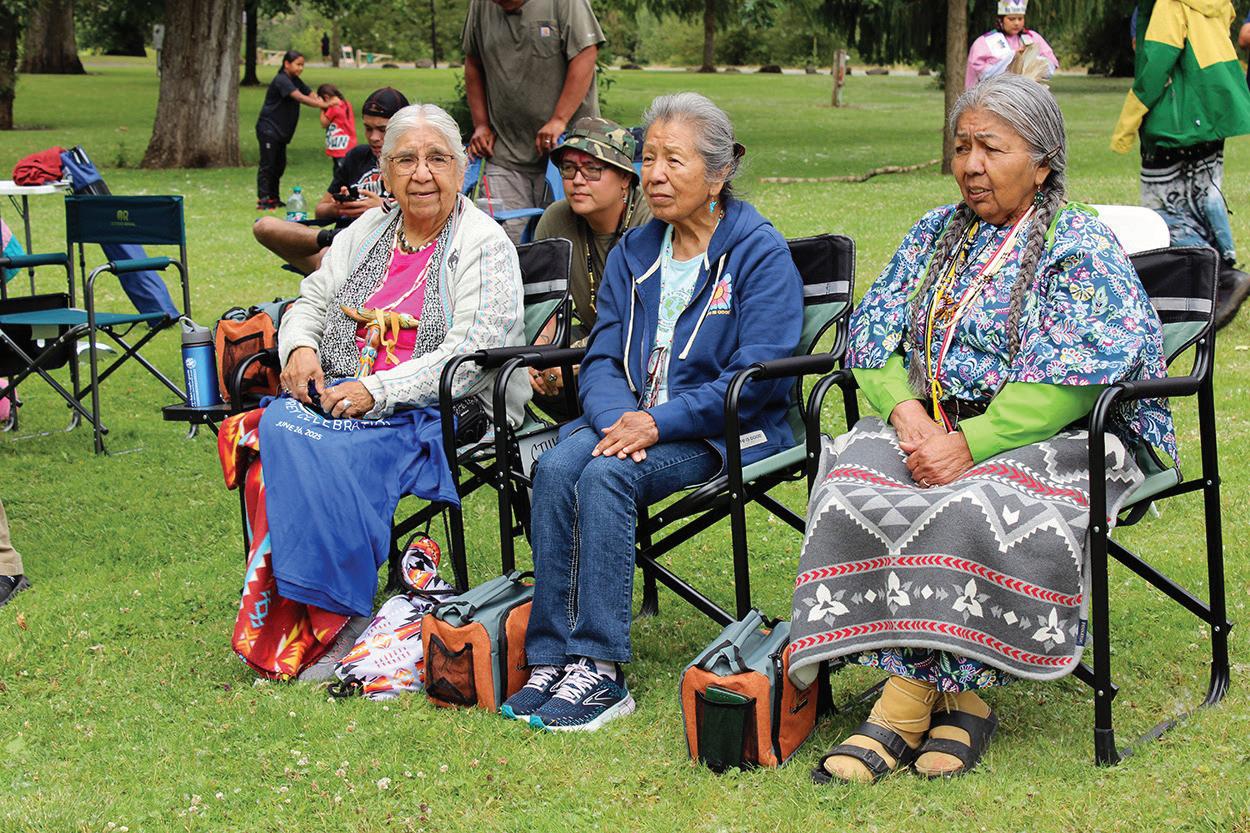
year, while Primus earned first-team honors as an infielder, and Strong as an outfielder.
Earning honorable mention honors for the Bucks were Nelson at catcher, Neistadt at first base, and Hill in the infield.
In addition to the GOL and allstate honors, Lehnert, Primus, Hill and Strong were selected to play in the 4A All-Star Series on June 14-15, at North Marion High School in Aurora. The four Bucks played on the South team.
The South won Saturday’s game 8-5, then won Sunday’s first game 5-1. The North won the second game 6-2. Lehnert earned the Outstanding Pitcher award for the South.
Greater Oregon League
Player of the year — Evan Lehnert, sr., Pendleton
First team
Pitchers — Bryce Pennington, sr., La Grande; Jake McClaughry, jr., Baker. Infield — Colson Primus, sr., Pendleton; Art Hill, sr., Pendleton; Jaxon Logsdon, sr., Baker. First base — Jacob Neistadt, sr., Pendleton. Outfield — Mason Strong, sr., Pendleton; Sage Joseph, sr., Baker; Dean Fenley, jr., La Grande. Catcher — Ryder McIlmoil, jr., La Grande; Vance Nelson, jr., Pendleton. DH — Able Perez, sr., Ontario. Utility — Landon Hood, jr., La Grande.
Second team
Pitchers — Colin Harrington, jr., Pendleton; Tugg McQuinn, jr., Pendleton. Infield — George Rodriguez,
sr., Ontario; Carter Seaquist, sr., La Grande; Aldo Duran, sr., Baker. First base — Marshall Begin, sr., La Grande. Outfield — Talon Gyllenberg, jr., Baker; Anson Dressler, sr., Pendleton; Conner Webster, sr., Ontario. DH — Connor Cook, sr., Pendleton. Utility — Brady Cradduck, sr., Ontario.
Honorable mention
First base — Zane Morgan, sr., Baker. Outfield — Keegan Kline, sr., Pendleton; Sovann Chab, jr., La Grande.
Weston-McEwen falls short to Grant Union in 2A/1A title game
ANNIE FOWLER
EUGENE — For the third time in as many years, Grant Union beat Special District 7 foe Weston-McEwen for the 2A/1A title on Friday, June 6, at Jane Sanders Stadium at the University of Oregon.
The Prospectors took control of the game early and never let up in a 10-2 victory over the TigerScots.
“Three years in a row this has happened,” W-M coach Jeff Griggs said. “It’s kind of scary. I told the girls there are no more games to be played after today. You played in the last one, but for some it was a little disheartening.”
It was the fourth consecutive title game for Grant Union (20-8), which
lost to Lakeview 5-3 in 2022.
On Friday, the Prospectors saw Reece Jacobs and Grace Kenyon drive in three runs a piece, and Addy Northway strike out seven to give first-year coach Tim Boethin a championship.
“This group of seniors is just phenomenal. I can’t say enough,” Boethin said. “We had issues at times early in the season, throwing the ball around. But we got ourselves in the right position toward the end of the year.”
Grant Union opened the game with one run in the first inning as a double by Jacobs sent Northway across the plate.
The TigerScots (23-6) had runners on second and third with two outs in the bottom of the first, but the threat
out the shortstop.

Continued on page 20
W-M’s Ward named 2A/1A all-state pitcher of the year
ANNIE FOWLER
ATHENA — Bre Ward has dominated the softball scene all season, and her hard work has paid off.
runs, 25 RBIs and 23 runs scored.
The TigerScots shared the SD7 title with Grant Union with matching 10-2 records. Both teams reached the state championship game for the third in a

The Weston-McEwen junior was named the Special District 7 and the 2A/1A all-state pitcher of the year by the league and state coaches, and she has the stats to back up her honors.
She finished the season with a 20-4 record, striking out 282 with an ERA of 2.55. She helped her own cause at the plate, hitting .488 with 40 hits, including seven doubles and six home runs.
“Bre came in with a goal of 200 strikeouts this year,” W-M coach Jeff Griggs said. “She more than accomplished that. She put herself in at 100%. She has worked hard to be there for her team in the circle, emotionally, and as a leader. I am really proud of her. I know she has a sense of accomplishment. The fact we have her for one more year is fantastic.”
Other W-M players joining Ward on the SD7 first team were utility player Ava Sams and infielder Hope Berry.
Sams hit .549 with 51 hits, including 16 doubles, two home runs, 46 RBIs and 43 runs scored. Berry hit .432 with 41 hits. She had 10 doubles, five home
row, with Grant Union beating W-M for the third consecutive year.
All-state first-team honors also went to W-M’s Sams and Berry.
Named to the all-state second team were Heppner’s Maya Payne, Isa Payne, Stefani, and Elgin/Imbler’s Hensley.
Griggs and Grant Union’s Tim Boethin were named the SD7 and the 2A/1A all-state coaches of the year.
Special District 7
Player of the year — Addy Northway, sr., Grant Union
Pitcher of the year — Bre Ward, jr., Weston-McEwen Coaches of the year — Jeff Griggs, Weston-McEwen and Tim Boethin, Grant Union
First team
Pitchers — Bre Ward, jr., WestonMcEwen; Maya Payne, so., Heppner; Keira Counsell, jr., Elgin/Imbler. Catchers — Addy Northway, sr., Grant Union; Isa Payne, fr., Heppner. First base — Ava Gerry, sr., Heppner. Infield — Savannah Watterson, sr., Grant Union; Delaney Stefanie, jr., Heppner; Hope Berry, jr., Weston-McEwen; Amanda Lawyer, sr., Union. Outfield — Reece Jacobs, sr., Grant Union; Kendra Hensley, sr., Egin/Imbler; Katie Spivey, sr., Heppner; Cabella Gregory, sr., Union. Utility — Ava Sams, sr., WestonMcEwen. DP — Lilly Rockhill, sr., Grant Union.
Second team
Pitchers — Coley Gibbs, jr., Pilot Rock; Izabel Martin, sr., Elgin/Imbler; Jada Deist, so., Pilot Rock. Catchers — Paige Hansen, so., Pilot Rock; Lily Langford, jr., Weston-McEwen. First base — Gracee Hemphill, so., Pilot Rock. Infield — Kylie Kramer, sr., Weston-McEwen; Alivia Gridley, so., Irrigon; Kali Amy, sr., Union; Hannah Robbins, sr., Union; Gracee Hueckman, so., Grant Union. Outfield — Kessa Litfin, so., Pilot Rock; Shianne Claassen, fr., Irrigon; Taylor Palmateer, Grant Union; Avi Allen, so., Union. Utility — Cici Stefani, fr., Heppner. DP — Kadie Henrichs, sr., Heppner.
Honorable mention
Pitcher — Hayden Gregory, so.,

Union. Catchers — Bristol Bailey, so., Grant Union; Brea Rudd, sr., Union; Brooklynn Locey, fr., Irrigon. First base — Maddie Ahlbrandt, so., Elgin/Imber. Infield — Hailey Thieme, jr., Pilot Rock; Megan McLouth, so., WestonMcEwen; Vannah Smith, so., Elgin/ Imbler; Natalia Gridley, sr., Irrigon. Outfield — Kashley Golden, jr., Pilot Rock; Keeley Nairns, sr., Heppner; Reagan Pickard, fr., Weston-McEwen; Skylar McKay, sr., Grant Union. Utility — Kimber Ricker, jr., Union. DP — Addison Kosey, sr., Pilot Rock.

stopped there as Hope Berry popped
The Protectors struck gold in the second inning, scoring four runs on
Weston-McEwen’s Bre Ward was named the Special District 7 and 2A/1A all-state pitcher of the year.
Weston-McEwen placed second in the 2A/1A state softball championships after a 10-2 loss to Grant Union on June 6, 2025, at Jane Sanders Field on the campus of University of Oregon. – Photo courtesy of WESTON-MCEWEN BOOSTER CLUB/COURTESY
three hits and two outs to take a 5-0 lead.
Savannah Watterson hit a double to center field to drive in two runs, and Jacobs hit a single to left field that scored two runs.
Grant Union went three up, three down in the top of the third, while W-M lit up the scoreboard in the bottom half of the inning.
With one out, Lily Langford hit a solo home run to left field to make it 5-1.
With two outs on the board, the TigerScots kept fighting. Ava Sams singled up the middle, and then went to second on a passed ball. Bre Ward and Berry each drew a walk to load the bases, only to see Reagan Pickard go down swinging.
Continued from page 19 The Big Johns Red Sox defeat the Padres 17-10 to advance to the Babe Ruth Championship

“We came down here and we stayed positive when we got down in the game,” Griggs said. “We had a little spark with Lily hitting a bomb over the Oregon fence. Several innings were shutout ball. We thought we had something going there in the seventh.”
Neither team would score again until the seventh inning, where the Prospectors rang up five runs, highlighted by a three-run triple from Grace Kenyon with two outs.
In the bottom of the inning, Kylie Kramer singled to left field to put one run across the plate. With Sams at the plate, Kramer attempted to steal second, but was caught as GU catcher Bristol Bailey threw the ball to shortstop Watterson, who tagged out Kramer to
end the game.
“We had our chance to break into the game,” Griggs said. “We left the bases loaded. That was disappointing. We had opportunities, but in a game like this you can’t afford to strand runners. Today, Grant Union was the better team. Tip my hat to them, they played every single playoff game on the road.”
Ward took the loss, giving up 10 runs on eight hits, She struck out 10 and walked six.
Kramer led W-M with two hits, while Langford and Sams each had one. Megan McLouth stole two bases.
Northway earned the win in the circle, allowing two runs on four hits with seven strikeouts and four walks.
“It wasn’t like we came down and
Hodgen


Big John’s falls to Byrns Oil 6-4 in the Babe Ruth Championship Game


played lousy ball,” Griggs said. “The big story is Northway was able to keep us off balance.”
Jacobs went 2-for-2 with three RBIs for GU, while Northway was 2-for-3, and Watterson was 1-for-4 with two RBIs and two runs scored.
Langford and Northway were named the Moda Health Players of the Game. Langford also was W-M’s Player of the Game in 2024.
With the win, Grant Union joined an elite group of teams with three or more consecutive state titles. Churchill won four in a row (1980-83), while Churchill (1985-87), Harrisburg (19992001), Valley Catholic (2007-09) and Crater (2007-09) won three in a row.
Distributing of Pendleton
lose 0-10 in the second game against Centennial Patriots of Idaho at the Ashley Hodgen’s Memorial Baseball Tournament on June 14



Cohen Steidl base running and scoring for the Padres.
Catcher Teegan Herrera protecting home plate
Emery Kordatzky gets the out in center with big catch and play at second base
Karter Spencer making a play at third base
Grant Sheoships went 0-2 at bat.the Padres. Spencer on the mound pitching from the stretch
Grant Sheoships making a play out of left field.
Quincy Sams on the mound throws a pitch.
